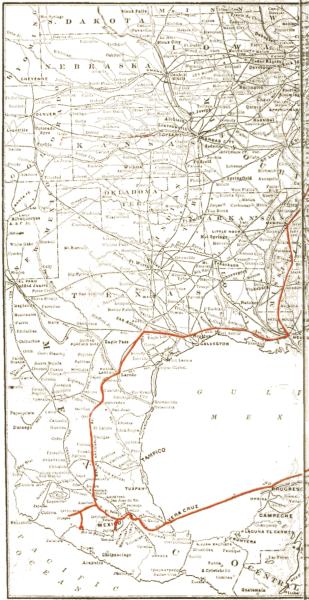.
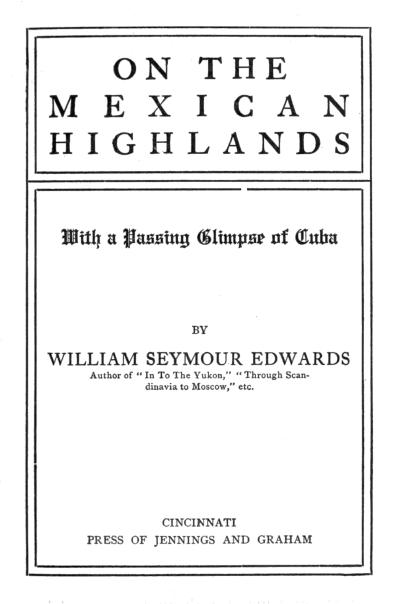
ON THE MEXICAN HIGHLANDS
With a Passing Glimpse of Cuba
BY
WILLIAM SEYMOUR EDWARDS
Author of “In To The Yukon,” “Through Scandinavia to Moscow,” etc.
CINCINNATI
PRESS OF JENNINGS AND GRAHAM
Copyright, 1906, by
William Seymour Edwards
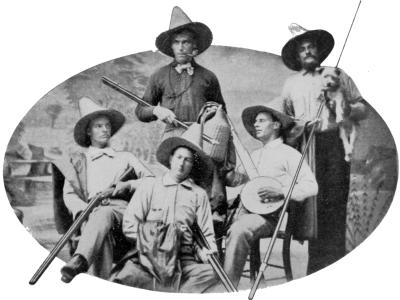
THE SIX COMRADES OF CAMP FLAP-JACK—1881
To
Julius H. Seymour, Otto Ulrich von Schrader, Edmund Seymour, and Rudolph Matz, Companions, Comrades, and Fellow-Travellers of
“CAMP FLAP-JACK”
These pages are affectionately dedicated.
FOREWORD
These pages contain the impressions of a casual traveller—a few letters written to my friends.
Upon the temperate Highlands of Mexico, a mile and more above the sea, I was astonished and delighted at the salubrity of climate, the fertility of soil, the luxuriance of tree and plant, the splendor and beauty of the cities, the intelligence and progressiveness of the people, the orderliness and beneficence of the governmental rule.
In Cuba I caught the newborn sentiment for liberty and order, and at the same time came curiously into touch with restive leaders, who even then boldly announced the intention to plot and wreck that liberty and order by sinister revolution, if their wild spirits should find no other way to seize and hold command.
If there shall be aught among these letters to interest the reader, I shall welcome another to the little circle for whose perusal they were originally penned.
William Seymour Edwards.
Charleston-Kanawha, West Virginia,
November 1, 1906.
CONTENTS
TABLE OF ILLUSTRATIONS
ON THE MEXICAN HIGHLANDS
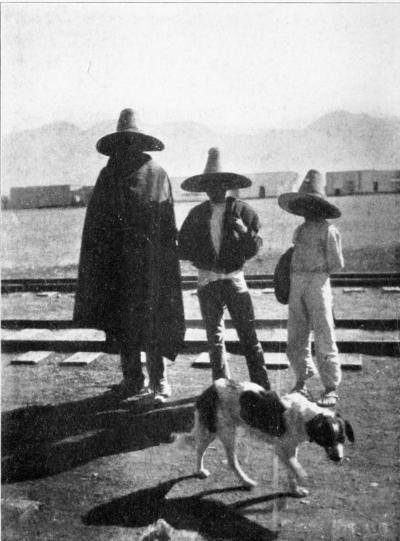
A VISTA OF MEXICO
I
Flying Impressions Between Charleston-Kanawha and New Orleans
New Orleans, Louisiana,
November 15th.
When the New York and Cincinnati Flyer (the “F. F. V. Limited”) came into Charleston yesterday, it was an hour late and quite a crowd was waiting to get aboard. Going with me as far as Kenova were D, H, and eight or ten of “the boys.” They all carried Winchesters and were bound on a trip to the mountains of Mingo and McDowell, on the Kentucky line, to capture a moonshine still which was reported to be doing a fine business selling to the mines. D wanted me to go along, and offered me a rifle or a shotgun, as I chose. They are big men, all of them, and love a scrap, which means the give and take of death, and have no fear except of ambush. I still carry in my pocket the flat-nosed bullet D took from the rifle of Johnse Hatfield two years ago, when he caught him lying-in-wait behind a rock watching for Doc. Ellis to come forth from his front door. Johnse was afterward hanged in Pikeville for other crimes. Then, a few months later, his brother “Lias,” just to get even, picked off Doc. Ellis as he was getting out of a Pullman car. Now “Lias” is said to be looking for D, also, but D says he’s as handy with his gun as “Lias” is, if only he can get a fair show. D is captain of this raid and promises to bring me tokens of a successful haul, but I am apprehensive that, one of these days, he or some other of “the boys” will not come back to Charleston.
At Ashland my Louisville car was attached to the Lexington train, and we turned to the left up the long grade and soon plunged into the hill country of eastern Kentucky. Here is a rough, harsh land, a poor, yellow soil, underlying miles of forest from which the big timber has long since been felled. Here and there small clearings contain log cabins, shack barns, and soil which must always produce crops as mean as the men who till it. We were traversing the land of the vendettas. At the little stations, long, lank, angular men were gathered, quite frequently with a rifle or a Winchester shotgun in their bony hands. It was only two or three years ago that one of these passenger trains was “held up,” by a rifle-armed gang, who found the man they were looking for crouching in the end of the smoker, and shot him to death right then and there—but not before he had killed two or three of the assassins.
I had gone forward into the smoking car, for it is in the day coaches where one meets the people of the countryside when traveling. I had seated myself beside a tall, white-haired old man who was silently smoking a stogie, such as is made by the local tobacco growers of this hill country. He had about him the air of a man of importance. He was dressed in homespun jeans and wore the usual slouch felt hat. He had a strong, commanding face, with broad, square chin and a blue eye which bespoke friendliness, and yet hinted of inexorable sternness. I gave him my name and told him where I lived, and whither I was going, introducing myself as one always must when talking to these mountain people. He was a republican, like myself, he said, and had several times been sheriff of his county; but that was many years ago and he declared himself to be now “a man of peace.” We talked of the vendettas and he told me of a number of these tragedies. When I made bold to ask him whether he had ever had any “trouble” himself, he replied, “No, not for right smart o’ yearn;” and then he slowly drew from his trousers pocket, a little buckskin bag, and unwound the leathern thong with which it was fast tied. Having opened it he took out three misshapen pieces of lead and handed them to me, remarking, “‘T was many yearn ago I cut them thar pieces of lead, and four more of the same kind, from this h’yar leg of mine,” slapping his hand upon his right thigh. “But where are the other four?” I queried. For an instant the blue eyes dilated and glittered as he replied, “I melted ’em up into bullets agen, and sent ’em back whar they cum from.” “Did you kill him?” I asked. The square jaws broadened grimly, and he said, “Wall, I don’t say I killed him, but he ain’t been seen aboot thar sence.” I offered him one of my best cigars, and turned to the subject of the horses of Kentucky. He was going to Lexington, he said, to attend the horse sales the coming week and he begged me to “light off with him,” for he was sure I would there “find a beast” I would delight to own. I promised to visit him some day when I should return, and he has vouched to receive me with all the hospitality for which Kentucky mountaineers, as well as blue grass gentlemen, are famed.
When we had come quite through the hill region, we rolled out into a country with better soil, and land more generally cleared, and much in grass. It was the renowned blue grass section of Kentucky, and at dark we were in Lexington. Twinkling lights were all that I could see of the noted town. The people who were about the station platform were well dressed and looked well fed, and a number of big men climbed aboard.
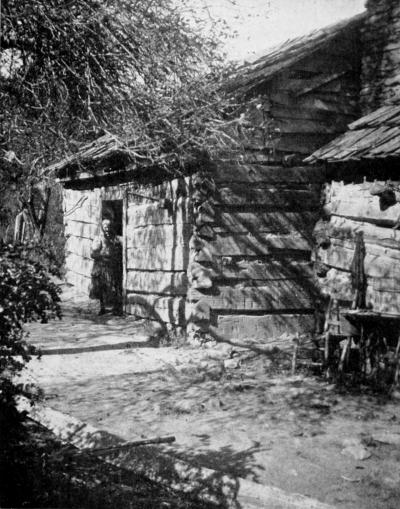
LOG CABIN OF KENTUCKY MOUNTAINEER
We arrived at Louisville half an hour late. This was fortunate, for we had to wait only an hour for the train to Memphis, via Paducah. Two ladies, who sat behind me when I entered the car at Charleston, stood beside me when I secured my ticket in the Memphis sleeper and took the section next to mine. It had been my intention to change trains at Memphis, take the Yazoo Valley Railway and go via Vicksburg, thinking that I might see something of the Mississippi River; but in the morning I met a young engineer of the Illinois Central Railroad, who told me that this route had a very bad track, the cars were poor, the trains slow, while the line itself lay ten or twelve miles back from the river so that I should never see it; therefore, I decided to stick to the through fast train on which I had started, and go on to New Orleans by the direct route down through central Mississippi.
When I awoke we were speeding southward through the wide, flat country of western Tennessee. We passed through acres of cornstalks from which the roughness (the leaves of the corn) and ears had been plucked, through broad reaches of tobacco stumps, and here and there rolled by a field white with cotton.
In the toilet room of the sleeper I found myself alone with a huge, black-bearded, curly-headed planter, who was alternately taking nips from a gigantic silver flask and ferociously denouncing the Governor of Indiana for refusing to surrender Ex-governor Taylor to the myrmidons of Kentucky law, to be there tried by a packed jury for the assassination of Governor Goebel. I finally felt unable to keep silent longer, and told him that I did not see the justice of his position, and reminded him that the Governors of the neighboring States of West Virginia, Ohio and Illinois had publicly expressed their approval of the Governor of Indiana, and their disapproval of the political methods then prevailing in Kentucky. He looked steadily at me with an air of some surprise, then stretching out his flask begged me to take a drink with him. He thereafter said no more on politics, but talked for half an hour of the tobacco and cotton crops of western Tennessee.
We arrived in Memphis at about ten o’clock of the morning and stopped there some time. In the big and dirty railway station I felt myself already in a country other than West Virginia.
Memphis, the little I saw of it, appeared to be a straggling, shabby town, with wide, dusty streets, and many rambling dilapidated buildings. The people had lost the rosy, hearty look of the blue grass country, and were pale and sallow, while increasingly numerous everywhere were the ebony-hued negroes. We were passing from the latitude of the mulattoes to that of the jet-blacks, the pure blooded Africans.
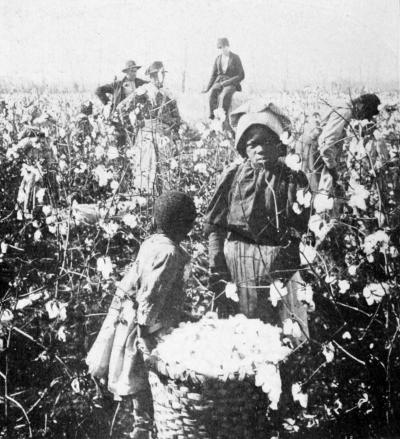
PICKING COTTON—MISSISSIPPI
Leaving Memphis, we turned southeastward and then due south, through the central portions of the state of Mississippi. Here spreads a flat country, with thin, yellow soil in corn and cotton. Everywhere were multitudes of negroes, all black as night. Negro women and children were picking cotton in the fields. There were wide stretches of apparently abandoned land, once under cultivation, much of it now growing up in underbrush and much of it white with ripened seedling cotton. In many places the blacks were gathering this cotton, apparently for themselves. There were a few small towns, at long intervals. Everywhere bales of cotton were piled on the railway station platforms; generally the big, old-fashioned bales, occasionally the small bale made by the modern compress. This is the shipping season, and we frequently passed teams of four and six mules, hauling large wagons piled high with cotton bales coming toward the railway stations. We passed through great forests of the long-leaved yellow pine, interspersed with much cottonwood and magnolia, while the leaves of the sumach marked with vivid red the divisions of the clearings and the fields. The day was dull and cloudy and a chill lingered in the air. The two lady travelers sat all day long with their curtains down and never left their books. The scenery and life of Mississippi held no interest for them.
In the late afternoon we passed through Mississippi’s capital, Jackson, and could see in the distance the rising walls of the new statehouse, to be a white stone building of some pretentions. Here a number of Italians and Jews, well dressed and evidently well-to-do, entered our sleeper en route to New Orleans. The country trade of Mississippi is said to be now almost altogether in the hands of Jews and of Italians. The latter coming up from New Orleans, are acquiring many of the plantations in both Mississippi and Louisiana, as well as, in many cases, pushing out the blacks from the work on the plantations by reason of their superior intelligence, industry and thrift. A lull in Italian immigration followed the New Orleans massacre of the Mafia plotters some years ago, but that tragedy is now quite forgotten, and a steady influx of Italians of a better type has set in.
In the dining car, I sat at midday lunch with a round-faced, pleasant mannered man some forty years of age, with whom I fell into table chat. He was a writer on the staff of a western monthly magazine and was well acquainted with the country we were traversing. He pointed out places of local interest as we hurried southward, while many incidents of history were awakened in my own mind. All of this land of swamp and bayou and cotton field had been marched and fought over by the contending armies during the Civil War. Here Grant skirmished with Johnston and won his first great triumphs of strategy in the capture of Vicksburg. Here the cotton planters in “ye olden time” lived like lords and applauded their senators in Congress for declaring in public speech that “Mississippi and Louisiana wanted no public roads.” Here Spain and France contended for supremacy and finally yielded to the irresistible advance of the English-speaking American pioneer, pressing southwestward from Georgia, Carolina and Tennessee.
It was still the same flat country when, near dusk, we entered Louisiana. At the first station where we stopped an old man was offering for sale jugs of “new molasses” and sticks of sugar cane—the first hint that we were surely below the latitude of the frosts.
It was a murky night, no stars were out, only a flash of distant electric lights told us that we were approaching New Orleans. We were in the city before I was aware. Quickly passing many unlighted streets, we were suddenly among dimly lighted houses, and then drew into an old-time depot, a wooden building yet more dilapidated than that of Memphis. We were instantly surrounded by a swarm of negroes. There were acres of them with scarcely a white face to be seen. I made out one of the swarthy blacks to be the porter of the new St. Charles Hotel. Giving him my bags, I was piloted to an old-fashioned ’bus and was soon driving over well asphalted streets amidst electric lights, and found myself in the thoroughfares of a really great city. From broad Canal Street we turned down a narrow alley and drew up in front of a fine modern hotel. This is an edifice of iron, stone and tile, with seemingly no wood in its structure, large, spacious and filled with guests, the chief hostelry of New Orleans, and worthy of the modern conditions now prevailing in this Spanish-French-American metropolis of the Gulf States.
II
The Life and Color of New Orleans
New Orleans, Louisiana,
November 16th.
After a well-served dinner in the spacious dining-room of the hotel, where palms and orange trees yellow with ripened fruit and exhaling the fragrance of living growth were set about in great pots, I lighted my cigar and strolled out upon narrow St. Charles street. Following the tide of travel I soon found myself upon that chief artery of the city’s life,—boulevard, avenue and business thoroughfare all in one—stately Canal street. It was crowded with a slowly moving multitude, which flowed and ebbed and eddied, enjoying the soft warm air beneath the electric lights and stars. I quickly became a part of it, taking pleasure in its leisurely sauntering company.
The typical countenance about me was of the dark, swarthy Latin south, and tall men were rarely met. Among the gossiping, good natured promenaders of Canal street there is none of the haste which marks New York’s lively “Rialto;” none of the scurry and jam which jostles you in brusque Chicago. In New Orleans there is an air of contented ease in the movement of the most poorly clad. Even the beggars lack the energy to be importunate.
At a later hour, crossing the wide thoroughfare, I was at once among narrow streets, the rues of the Vieux Carré, the Quartier Francais,—the Quartier now, but once all that there was of New Orleans. The transition was sharp. The buildings hinted of Quebec and Montreal, and of Old France. Balconies clung to second stories, high adoby and stucco walls were entered by narrow, close-barred doorways, latticed windows looked down upon the passer-by, and now and then, I fancied behind their jalousies the flash of dark eyes. My ear, too, caught softly sonorous accents which are foreign to the harsher palatals and sibilants of English. Beneath a glaring electric arc two swarthy pickaninnies were pitching coppers and eagerly ejaculating in curious, soft French. A man and a woman were chaffering at a corner meat shop, seller and buyer both vociferating in an unfamiliar tongue. I was hearing, for the first time, the Creole patois of old New Orleans.
Along one narrow rue—all streets are rues and all rues are narrow here—were many brilliant lights. It was the rue —— where cafés and wine shops and quiet restaurants abound. When last in New York M B, had posted me and said, “If ever you shall be in New Orleans, go to the Café ——. Go there and if you care to taste a pompano before you die, a pompano cooked as only one mortal on this earth can do the job, go there and whisper to the chef that ‘I’m your friend.’” So I went and found the chef and ever since have dreamed about that fish. The room was large; its floor was sanded and scrupulously clean. Many little tables were set along the walls. Pangs of hunger griped me the instant I peered within that door. I grew hungrier as I sat and watched the zest and relish with which those about me stowed away each dainty fragment. I was ready for that pompano when at last it came. I have eaten this fish in New York, in Baltimore, in Washington and in Richmond, and ever as I came further south did the delicacy of its flesh and flavor grow. Now, the long leap to New Orleans has given me this gourmet’s joy fresh taken from the waters of the Gulf. I ate with slow and leisurely delight, letting my enamored palate revel in the symphony of flavor, sipping my claret, and watching the strange company which filled the room. The men were mostly in evening dress—lawyers, bankers and business men. They had come in from the theatre or, perhaps, had spent the evening over cards. At some of the tables were only men, at others ladies were present, young, comely and, many of them, elegantly gowned. Black eyes were dominant among these belles, and here and there I fancied that I caught the echo, in some of their complexions, of that warmer splendor of the tropics which just a dash of African blood when mixed with white, so often gives, and which has made the octoroon demoiselles of New Orleans famous for brilliant beauty the world around. It was a gay company, full of chat and laughter and gracious manner—the graciousness of well-bred Latin blood.
When, at last, my pompano was vanished, and the claret gone, and I regretfully quitted the shelter of La —— it was long past the stroke of twelve, yet the café was still crowded and the Vieux Carré was alight and astir as though it were early in the night. Again crossing Canal street, I found the American city dark and silent. I hurriedly went my way to the hotel, my footsteps echoing with that strange, reverberating hollowness which marks the tread upon the deserted, midnight city street.
In the morning I was up betimes, taking a cup of coffee and a roll, and then making my way down St. Charles street and crossing Canal to the rue Royale, passing the open gates of the old convent garden of the Ursulines, now the Archbishop’s palace, and turning into the rue St. Petre, then into Jackson Square. The air was cool. The world had not quite waked up. The gardeners with their water carts were giving the morning bath to the lawns and flowers of the park. A friendly mannered policeman had just disturbed two tramps from their nightly slumber, bidding them move on. I sat down upon a stone bench near where they had slept and looked across at the old Spanish-French Cathedral of St. Louis and the municipal buildings of the courts, the Cabildo and Hotel de Ville—architectural monuments of an already shadowy past. The chimes were ringing to matins and the devout were entering to the early mass.
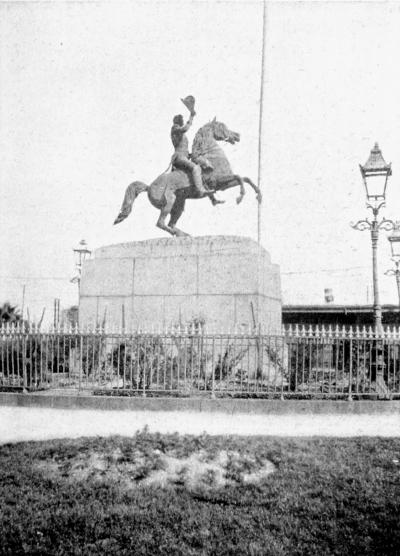
JACKSON STATUE—NEW ORLEANS
I watched the hurrying groups, musing the while upon the picture before me. Here, the Canadian de Bienville, and Cadillac and Aubry and their French compeers, as well as the Spanish Captains General, from Don Juan de Ulloa to Don Manuel Salcedo had offered up their thanks for safe arrival from dangerous voyages across uncharted seas. Here, Don Antonio O’Rielly, Havana’s murderous Irish Governor, had ordered his Spanish musketeers to shoot to death the Creole patriots, Lafreniere, Milhet, Noyant, Marquis, Caresse, that devoted band who refused to believe
that Monsieur le Duc de Choiseul and his Majesty, Louis XV, le bien aimé—had secretly made cold-blooded sale of the fair Province of Louisiana to Spain. Here, Citizen Laussat, by order of Napoleon, had surrendered the great Louisiana Province to General Wilkinson and Governor Claiborne, the Commissioners of Thomas Jefferson, who thereby added an empire to the dominion of the young government of the United States. Here, also, had been celebrated with so much pomp and trumpet fanfare the victory of Andrew Jackson’s border riflemen over Pakenham’s Peninsular veterans. The historic Place d’Armes has been rechristened Jackson Square, and “Old Hickory” now rides his big horse in the midst of a lovely municipal garden. In later years, here also had Confederate Mayor and Federal General posted their decrees and proclamations, among the latter that famous “General Order No. 28,” wherein the doughty General presumed to teach good manners to the dames and demoiselles of New Orleans, and gained thereby the sobriquet “Beast Butler.”
The worshipers were returning from the mass. My reverie was at an end. I arose and, crossing the square, strolled over to Decatur Place toward the old French market by the river side. There I found much that reminded me of the greater Marché Central which I had visited one early morning in Paris. There were the same daintiness and care in arranging and displaying the vegetables, the same taste and skill in showing the flowers, which are everywhere the glory of New Orleans. There were bushels of roses—the Marechal Neil, the gorgeous Cloth of Gold among the more splendid. Here also the butchers were carrying the meats upon their heads, just as they did in France, and the fish and game were as temptingly displayed. But the people of the market, though speaking the French tongue, were widely different. The swarthy tints of the tropics were here in evidence. Negresses black as night made me bonjour! The venders and porters were ebony or mulatto, and even the buyers were largely tinctured with African blood, while the French they talked was a speech I could with difficulty comprehend. The sharp nasal twang of Paris was greatly softened, and their “u” had lost that certain difficult liquidity which English and American mouths find it almost impossible to attain. Curious two-wheeled carts loaded with brass milk cans were starting on their morning rounds, and lesser two-wheeled wagons were being loaded with vegetables, meats and fish for the day’s peddling throughout the city. Burdens were not so generally borne upon the backs and shoulders as in France, although some of the women and a few men were carrying their wares and goods upon the head with easy balance.
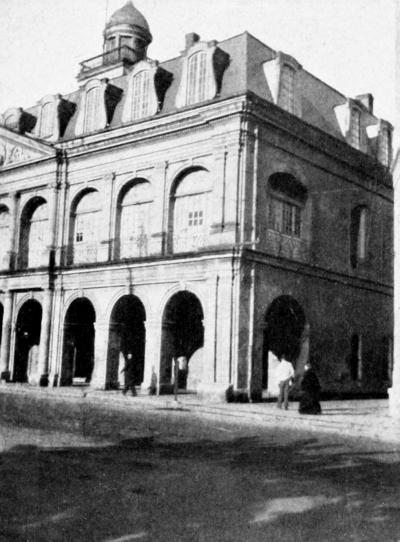
THE CABILDO—NEW ORLEANS
The Vieux Carré has in it to me a certain note of sadness. As you wander along its rues and ways you feel that, somehow or other, the days of its importance and its power are forever gone. Mansions, once the imposing homes of the affluent, are now cracked and marred, and there seem to be none to put them into good repair. Dilapidation broods over the Vieux Carré. You feel that the good old Creole days are surely fled. You realize that as the language of La Belle France is disappearing, so the leisurely customs and easy habits of French New Orleans, before many years, will be submerged by the direct speech and commercial brusqueness of modern America.
In the afternoon I rode many miles upon the trolley cars through and about the city, and particularly along by the levees and through the fine avenue St. Charles, and the upper modern section. Low, very low, lies New Orleans, the greater part of it only a few feet above the water, really below the level of the Mississippi in times of flood. Many streets are now asphalted and kept comparatively clean, but the greater portion of the city is yet unpaved, or, when there is pavement at all, is still laid with the huge French blocks of granite (a foot or eighteen inches square) put down two centuries ago. The city lies too close to perpetual dead water to permit of modern drainage and there are few or no underground sewers. The houses drain into deep, open gutters along the streets between the sidewalks and the thoroughfares over which you must step; fresh water is pumped into these gutters and, combining with the inflowing sewerage, is pumped out again into the Mississippi. It is in this crude and unsanitary manner that New Orleans strives to keep measurably clean.
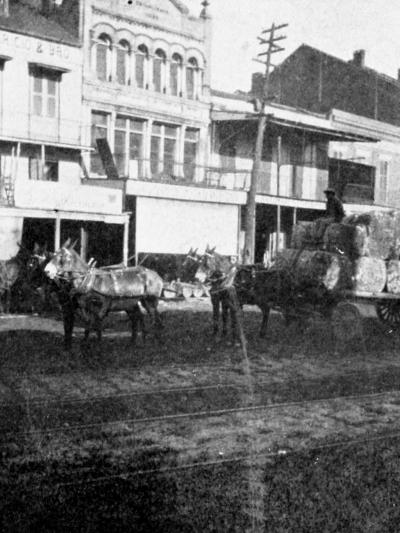
HAULING COTTON—NEW ORLEANS
The residence section, in the American city, contains many handsome mansions with wide lawns and a profusion of semitropical trees, and everywhere are gardens—flower gardens that are riotous masses of roses and jasmines and splendid blooms. Just as the glory of England is her flowers, where no home is too humble for a window box, so, too, is it in New Orleans. However dirty she may be, however slovenly and slipshod, you must yet love the city for her flowers. Even the laborer’s most humble cottage glows with its mass of color.
New Orleans has no parks to boast of—Audubon Park is a mere ribbon of green—but the cemeteries on her borders are really her parks. The live oaks in them hang with masses of drooping moss, and blossoming magnolias and shrubs are everywhere. So near is the water to the surface, however, that there can be no burials within the earth, and the cemeteries are therefore filled with tombs built above the ground. Many of these are costly works of art.
The city clings to the river where the Mississippi makes a great bend, like a half moon, to the southwest, whence its name, the “Crescent City.” Only the big embankments, fourteen to fifteen feet in height, prevent the homes and gardens, as well as the entire business portion of the city, from being sometimes submerged by the angry waters of the great river. I found it strange, from a steamer’s deck, lying at the levee, to be looking down into the city, ten or twenty feet below. It reminded me of Holland and of Rotterdam, except that there the waters are the dead and quiet pools of Dutch canals, while here they are the swelling restless tide of the more than mile-wide Mississippi.
Along the levees were many ocean liners loading with molasses, sugar and cotton, chiefly cotton, in which there is an enormous and constantly increasing trade. The biggest ships now come up right alongside the wooden wharves of the levees, and for several miles lie there bow to stern.
The theatres and business blocks, the customhouse, and city hall and other public buildings of New Orleans are none of them modern, but appear to have been built long years ago, yet, notwithstanding their marks of antiquity, the business part of the city is animate with stir and action. There is hope in men’s faces in New Orleans, and the younger men are finding in the city’s waxing commerce opportunity for achievement which their forefathers never knew. With the completion of the Panama Canal, New Orleans will become one of the greatest of commercial ports.
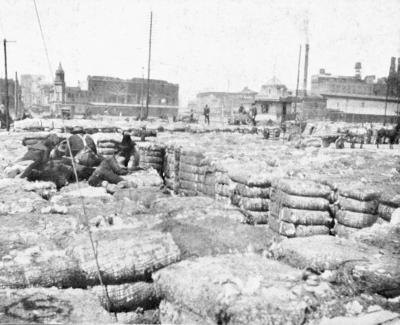
ALONG THE LEVEE—NEW ORLEANS
From New Orleans I shall go via the Southern Pacific Railway, crossing the Mississippi and traveling westward through Louisiana and Texas to San Antonio, Texas, and then I shall go south into Mexico.
III
Southwestward to the Border
(Written on the train and mailed at Laredo, Texas.)
November 16th.
The journey from New Orleans was somewhat tedious, but yet so crowded with new sights that the time passed quite too quickly for me even to glance at the copy of Lew Wallace’s Fair God, which I had bought in New Orleans for reading on the way.
At 9:45 A. M. I left the Hotel St. Charles and took the ’bus for the Southern Pacific Station, which is a shabby, weatherworn wooden building down by the water side, in the French quarter of the city. A large, ill-kept waiting room was crowded with emigrants—chiefly “crackers” and “po’ white trash” from the cotton states. A wide gangway led to the clumsy puffing ferryboat which took us across the Mississippi to a series of long, low, wooden sheds where our transcontinental train awaited us.
The ferry crosses the Mississippi from near the center of the bow, where the river sweeps in a giant curve against the crescent shore. The current is swift, and whether the waters be high or low, the river always hurries on with relentless eagerness toward the Gulf of Mexico, one hundred miles away.
As I stood upon the boat and my eye swept up and down the river, the city stretched before me black and sombre beneath a heavy pall of smoke, flat and uninteresting, only here and there a spire or steeple lifting itself solitarily above the level monotony. But along the miles of levees there was activity and life. Ocean steamers were taking on cargo, and multitudes of river steamboats were discharging freights of cotton bales and other upstream products, brought from the coal mines and wheat fields and plantations of Pennsylvania, West Virginia, and Ohio, Indiana and Illinois, Kentucky and Tennessee, of Wisconsin and Minnesota and Iowa, even from the Dakotas and Nebraska and Kansas, and from Missouri and Arkansas and Mississippi and Louisiana, for here converges the vast interior water-traffic of the continent. (The enormous traffic of the Great Lakes is now urging Congress to give them ship canals and unimpeded access to New Orleans.)
It is a prodigious traffic that steadily increases notwithstanding the competition of the railways which are now penetrating everywhere, even into the rich plantation country. For some years after the Civil War, New Orleans seemed to be losing her one-time pre-eminence as a port. The railways to the north threatened to cut off her trade from above, the silting up of the Mississippi’s mouths threatened to destroy her access to the sea. Then came the strong, wise hand of Uncle Sam, who built the magnificent jetty system contrived by Captain Eads, and New Orleans began to wake up. Her trade increased by leaps and bounds, the river traffic revived, and she became the mistress of a water commerce far exceeding what she had known before. Now not merely are her suburbs extending along the river, but her trade and commerce have crossed to the western shore, where a new and supplemental city is rapidly growing up. There, the Southern Pacific Railway and other western lines have erected their shops and factories, laid out extensive yards and built great warehouses. There they unload and store the freight which Louisiana, Texas and the farther West send eastward for distribution to the eastern railway connections which carry it to the Gulf and Atlantic seaboard ports for export, and for delivery to domestic consumption by inland water carriage.
We were to take the through San Francisco Express, and I had anticipated a fine transcontinental train, something like our own “F. F. V.” which takes us from Kanawha to Cincinnati, or New York. But I was disappointed. The “Sunset Limited,” as it is called, consisted of two sleepers, hitched behind a number of shabby immigrant cars and old-fashioned passenger day coaches. None of these were vestibuled, and there was no dining car attached. I had secured, fortunately, several days in advance, a lower berth as far as San Antonio; but many passengers applied who could obtain no berths, and were allowed to crowd into the sleepers for lack of accommodation in the day coaches, into which the swarming immigrants had overflowed.
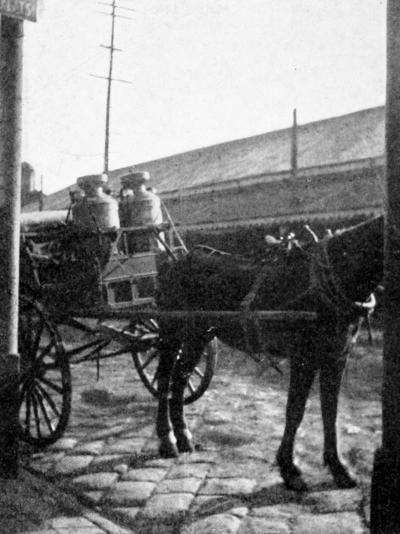
ANCIENT FRENCH PAVEMENTS
We were late in starting; we were late at every station along the road; we were an hour late when we arrived next morning at San Antonio; a poor beginning, surely, for a train that must journey four long days and nights to the Pacific coast.
We traversed a flat land, with many ditches and canals and pools of stagnant water lying a few feet below the level of the surface. The soil was black and rich. We crossed acres and acres, thousands of acres, of sugar-cane, and we saw many large mills, all using modern machinery for grinding cane and making sugar. Then there were fewer ditches, fewer canals, the land was higher, slightly, and there were miles of cotton fields, the cotton yet in the boll, ripe for the picking. Then it was a land with many little ditches, and little dykes; there were rice fields to be flooded; and there were rice mills,—representing a large and rapidly increasing interest. Every extent of forest we passed hung heavy with gray moss and parasitic vines. There were many live oaks and palmettoes and some cypress. The land was still gradually rising, finally becoming drier, grass-covered and grazed by herds of cattle and horses; but it was flat, always flat.
Toward dusk we passed through Beaumont, the famous oil town. This is the fateful place where millions of dollars have been made and lost within a few months. Ten years ago a group of our own Kanawha tenderfeet drilled here a four-hundred-foot dry hole, and abandoned the project, finding no oil within a stone’s throw of the spot where, a few years later, Dan Lucas drilled down eight hundred feet, and struck his seventy-thousand-barrel gusher. There was an excited “boom” throng at the station, and the travelers entering our car fairly buzzed thrilling talk of oil. Among them were a number of ladies, more bediamonded, bejeweled and begolded than any group of femininity I ever saw before. The men, too, wore flashing jewels and bore that distinct stamp which marks those who, with nonchalance, win or lose a fortune in a night. They were by all odds the toughest-looking lot of elegantly clad men and women I ever yet beheld.
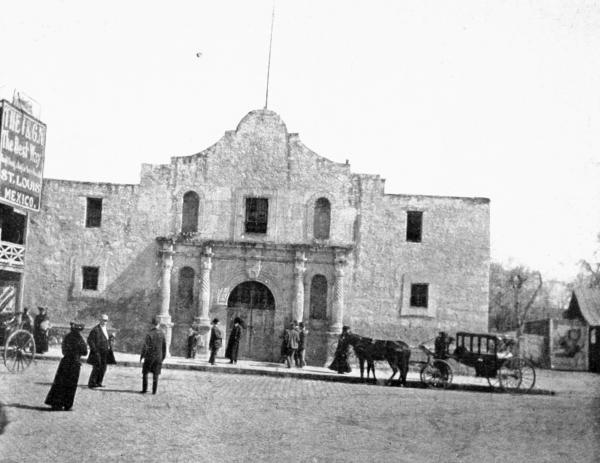
THE ALAMO
We passed Houston near midnight, and in the morning by eight o’clock were at San Antonio, a city of wide streets, and spacious parks adorned everywhere with palms and palmettoes and semitropical shrubs. We entered a ’bus and drove a mile to the station of the International and Great Northern Railway, which comes down from St. Louis and runs south seventy miles to Laredo, on the Rio Grande and the Mexican border. We passed the bullet-battered walls of the famous Alamo, the hallowed shrine of every loyal Texan, then a large Roman Catholic Cathedral with Spanish roof and bell tower, a huge convent and several stately public buildings. San Antonio is a city of forty thousand people and the last American town of magnitude north of Mexico. At the station, where we waited half an hour, I saw my first Mexican greasers, in their prodigious sombreros and began to feel myself nearing a strange land.
Our train from the North drew in at nine o’clock, on time, all vestibuled, lighted with electricity, with a dining car attached, and all its equipment greatly superior to that of the Southern Pacific. It was one of the Gould trains from St. Louis to the far South.
Leaving San Antonio, we traversed a country still flat, always flat, covered with sand and mesquit for miles and miles and miles. As far as the eye could see in every direction, hour after hour stretched this illimitable monotonous wilderness. The mesquit trees looked like ill-grown peach trees. To my unaccustomed eye, we seemed to be passing through endless barren orchards, the trees standing generally thirty or forty feet apart. Here is the home of the jack rabbit, and toward the Mexican border and within reach of the waters of the Rio Grande, deer abound. Quail are also common, but of other life there is little or none. Here and there the mesquit trees were cut away, and wide, sandy fields were planted with cotton. Cattle also were cropping the short, dry native grass. As we traveled south the grass diminished, the sand increased and the prickly cactus became increasingly plentiful. At one of the stations where we stopped for the engine to take water, I talked with a tall white-bearded planter, who stood holding his horse, the horse accoutered with Mexican saddle and lariat, the man in high Mexican sombrero. “The labor hereabouts is all Mexican,” he said. “Mexican peons you can import in unlimited numbers, who are glad to work for thirty cents per day and board themselves. Hence there are no negroes south of San Antonio, for no negro will work and live on such small pay. Moreover, the soil is so poor and water is so scarce that neither cotton nor cattle could here be raised with profit, if it were not for the low wage the Mexican is glad to accept.”
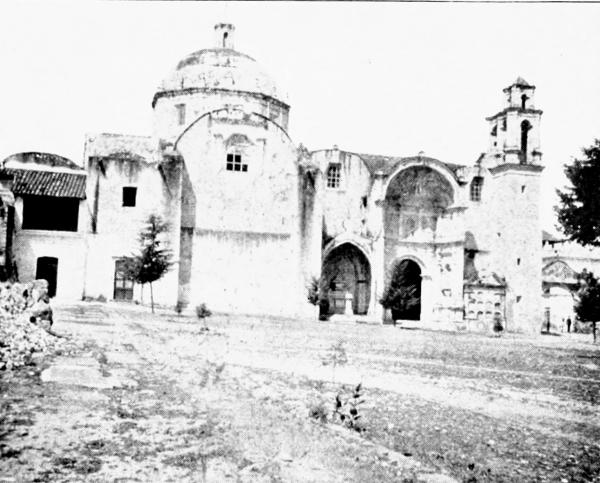
OLD SPANISH CONVENT
We reached Laredo, a city of some five thousand inhabitants, about six o’clock, P. M., where I sent the following telegram, “Cane, cotton, cattle, mesquit, sand and cactus, O. K.,” which, though brief, sums up the country I have been traversing for the last two days. Laredo is upon the American side of the Rio Grande, which is crossed by a long bridge to Nuevo Laredo, in the State of Nuevo Leon. Here smartly uniformed Mexican customs officers examined my baggage and passed me through.
IV
On to Mexico City
Mexico City, Mexico,
November 18th.
He llegado en esta ciudad, hoy, cerca las ocho de la mañana! The moment we crossed the Rio Grande we changed instantly from American twentieth century civilization to mediæval Latin-Indian. The Mexican town of Nuevo Laredo, the buildings, the women, the men, the boys, the donkeys, all were different. I felt as though I had waked up in another world. As we approached the station of the Mexican city, I noticed an old man riding upon his donkey. His saddle was fastened over the hips just above the beast’s tail, his feet trailed upon the ground. He sat there with immense dignity and self-possession, viewing with curiosity the gringos, who had come down from the land of the distant North. He silently watched us for some moments and then rode solemnly away, while I wondered by what hand of Providence it was he did not slide off behind.
From Nuevo Laredo to Monterey, which we reached at half past ten P. M., was all one flat mesquit and cactus-covered plain; sand, mesquit and cactus; cactus, sand and mesquit, mile after mile, till darkness fell upon us, when we could see no more. Monterey is the center of Mexico’s steel and iron industries, of large tobacco manufactories, of extensive breweries. It is the chief manufacturing city of modern Mexico. Our stay was brief, and I caught only a glimpse of a cloaked and high-sombreroed crowd, hurrying beneath the glare of electric lamps, and then we passed on toward the great interior plateau of the Mexican Highlands.
During the night it grew cold. I awoke shivering and called for blankets. In San Antonio the morning had been warm and, all day, south to Laredo and on to Monterey, the heat had been oppressive. It was cold when I left Kanawha, but the chilly air had not followed me beyond New Orleans, and I had there packed into my trunk all my warm clothing and checked it through to Mexico. Passing westward through Louisiana and Texas, the mild air was delightful and I was comfortable in my thinnest summer garments. Thus dreaming of orange groves and sunny tropics I fell asleep. Now I was shivering with a deadly chill, and the thin keen air cut like a scimiter. I pulled on my overcoat, which I fortunately still had with me, and slept fitfully till the day.
We crossed, during the night, the first great mountain range which shuts out the inland plateau of central Mexico from the lowland plains stretching eastward toward the Gulf and into Texas. We climbed many thousands of feet to Saltillo, where the mercury almost registered frost. Now we were descending the inner slopes of the barrier mountains, passing near the battle field of Buena Vista, where Zachary Taylor smote Santa Anna and his dark-skinned horde, and gained the fame which made him President of the United States. We were entering that vast desolate inland plain which stretches so many hundreds of miles south to Acambaro, where we should begin to climb again yet higher ranges, crossing them at last—at an altitude of eleven thousand feet,—before we should finally descend into the high cool valley of Anahuac to the City of Mexico.
About nine o’clock, we drew up at a wayside station for breakfast (almuerzo). If I had known it, I might have obtained my desayuno coffee and roll at an earlier hour upon the train. We were now upon a wide-stretching sandy level. A cold mist hung over us. The scorching sun was trying to penetrate this barrier. A band of Indians wrapped to their eyes in brilliant colored blankets of native make (zerapes), their high-peaked sombreros pulled over their eyes, with folded arms, silent as statues, stood watching us. I deliberately took their photograph. They did not smile or move. A group of Indian women sitting on the ground near these men were not so placid. They regarded the kodak as an evil mystery and hid their faces in their rebozos when I pointed my lens at them. The strange instrument smacked of witchcraft, and they would none of it. With rebozos still drawn, they got upon their feet and fled.
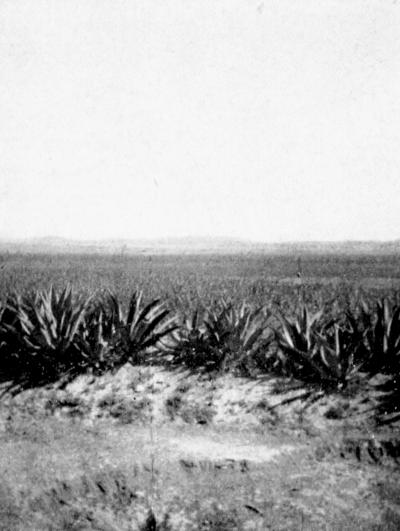
THE DESOLATE PLAINS
In another hour the bright white sun dissipated the mists. The sky was blue and cloudless. The track ran straight, with rarely a curve, mile after mile into the South. The land lay flat as a table, an arid plain, shut in by towering, verdureless mountains, ranging along the horizon on east and west. All day we thus sped south through illimitable wastes of sand, and sage brush and cactus, and a curious stunted palm, which lifted up a naked trunk with a single tuft of green at the very end. The landscape gave no sign of ever having been blessed by a drop of water, the barren prospect extending upon all sides in apparently unending monotony.
Now and then we passed a small station made of adoby brick. Now and then, a cluster of adoby dwellings centered about a low-roofed adoby church. At one place a half wild rancherro raced along beside the train on his broncho, vainly trying to keep the pace and wildly waving his sombrero as he fell behind. At the stations were always women and children, and the ever silent men standing like statues. They never moved, they never spoke, they never smiled; they gazed at us with blank astonishment. As we came further and further south, the extreme aridness of the landscape began to lessen. Cattle began to appear upon the plain, adoby villages became more frequent, the swarthy dark brown population became more numerous. Toward midafternoon, the towers, the high walls, the red tiled roofs of a great church, a cathedral, and a town of magnitude grew large before us. We drew up at a fine, commodious station, built of red sandstone. There, gathered to meet the train, were curious two-wheeled carts and antique carriages with high wheels, drawn by mules; many donkeys bearing burdens, some with men sitting upon their hips; a multitude of dark-faced Latins, men in high sombreros, the women with heads enveloped in rebozos or mantillas. We were at the station built a mile distant from the important city of San Louis Potosí, one of the great ore-smelting centers of Mexico, and a city of sixty thousand inhabitants. In the station we dined, and I ate my first Mexican fruits, one a sort of custard apple, and all delicious.
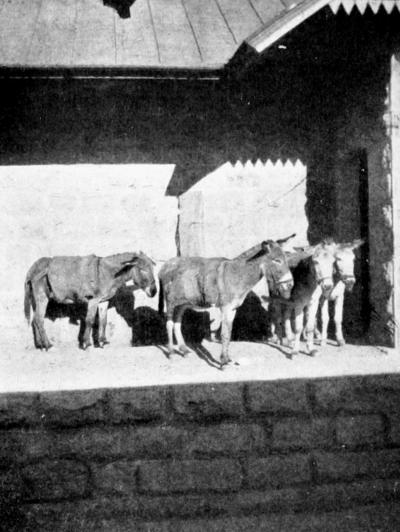
AWAITING OUR TRAIN
In the car with me sat a Mexican youth, who had evidently been studying and traveling in the States. He was dressed in the height of American fashion, and bore himself as a young gentleman of means. As he stepped from the train he was enveloped in the arms of another youth of about his own age. They clasped their right hands and patted each other on the small of the back with their left hands, and kissed each other’s cheeks, and then he was similarly embraced by a big stately man, over six feet in height, with a long gray beard, who carried himself with great dignity. The two were dressed in full Mexican costume, with tight-fitting pantaloones flaring at the bottom and laced with silver cording on the sides, short velvet jackets embroidered with gold lace, high felt hats with gold cords and tassels, and their monograms six inches high in burnished metal fastened on the side of the crown. Several peons seized the young man’s bags and American suit-case, and the party moved toward a six-mule carryall, set high on enormous wheels. The traveler was evidently the son of one of the great haciendados, whose estates lay perhaps fifty miles away. Only grandees of the first magnitude travel by carriage in Mexico.
Our colored porter, black as jet, was also in a happy mood. The first of his series of Mexican sweethearts had come to greet him, bringing him a basket of fruit. She was comely, with fine dark eyes, her long hair coiled beneath her purple rebozo. There is no color line in Mexico and Sam proved himself to be a great beau among the Mexican muchachas.
Sitting in the smoking compartment of my car, during the morning, I found myself in company with three Mexican gentlemen who entered at Monterey. They could speak no English. My Spanish was limited. But as we sat there I became conscious of a most friendly interchange of sentiment between us. They were demonstratively gracious. One of them offered me a fine cigar, the other insisted that I accept of his cigarettos, and they would accept none of mine until I first took one from them. They sent the porter for beer, and insisted that I share with them. They even got out at one of the way stations and bought fragrant light skinned oranges, and pressed me to share the fruit. I could not speak to them, nor they to me, but I became aware that they were members of the Masonic order. I wore my Master Mason’s badge. They displayed no outward tokens, but their glances and friendliness revealed their fraternal sentiments. They treated me with distinguished courtesy through all the journey to Mexico City, and at last said good-bye with evident regret. At a later time, I learned that a Mexican of the Masonic Fraternity wears no outward sign of his membership, owing to the hostility of the yet dominant Roman Church, while the Masonic bond is of peculiar strength by very reason of that animosity.
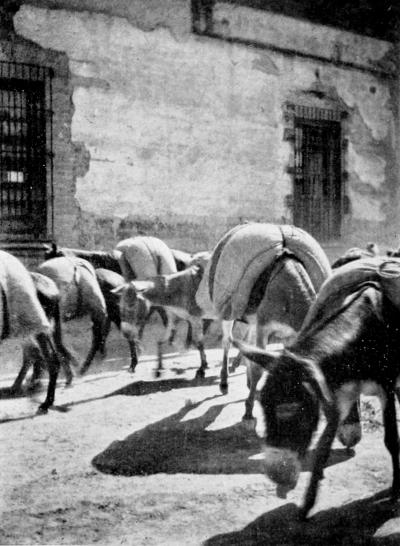
MULES CARRYING CORN
After leaving San Louis Potosí, the great inland plain which we had all day been traversing grew more and more broken. We came among small hills, with here and there deep ravines, and we began turning slightly toward the west and climbing by easy grades toward distant, towering mountains far upon the horizon to the south. Water now became more plentiful. We followed the course of a stream, wide, between high banks, where were long reaches of sand interspersed with well filled pools. There were adoby villages in increasing numbers, and here and there were little churches or chapels, each surmounted with a large cross. I counted more than a hundred of these chapels in the course of a few miles. It was as though the whole population had for centuries devoted its time to building these shrines. Some were dilapidated and in ill repair, others looked as though recently constructed. Each has its Madonna, and each is venerated and cared for by the family who may have erected it. It was eight o’clock and dark when we reached Acambaro where a good supper awaited us in the commodious station.
Just as the train was starting, I asked some questions of the American conductor and, after a little conversation with him, was surprised to find that he was a West Virginian from Kanawha. “Señor Brooks,” he said, who had grown up near “Coal’s Mouth,” now St. Albans. He was delighted to learn from me of Charleston and the Kanawha Valley, and hoped some day to return and see the home of his childhood. He now loved Mexico. Its dry and sunny climate had given him life, when in the colder latitude of West Virginia he would have perished.
During the night, while crossing the summit of the Sierra, at La Cima,—nearly eleven thousand feet above the sea,—it became intensely cold again, even colder than when we crossed the mountains near Saltillo. The chill again awoke me, when I discovered that we were rolling down into the valley of Anahuac toward the City of Mexico. We were soon below the mists and beneath a cloudless sky, yet I felt no undue heat, but rather, a quickening exhilaration in the pure, dry air. As we curved and twisted and descended the sharp grades, many vistas of exceeding beauty burst upon the eye. We were entering a wide valley of great fertility surrounded by lofty mountains, and to the far south, fifty miles away, the burnished domes of Popocatepetl and Ixtacciuhatl, lifted their ice crests into space, eighteen thousand feet above the level of the sea. Far beneath us glittered and glinted the waters of Lakes Tezcoco, Xochimilco and Chalco, once joined, but now separated, by the rescued land on which stood Tenochtitlan, the mighty capital of Montezuma, even yet to-day a city exceeding four hundred thousand souls (when Cortez conquered it, it is said to have held more than a million). Everywhere the eye rested upon fruitful land, tilled under irrigation, containing plantations of maguey, orchards of oranges and limes, and pomegranates, and groves of figs and olives—all forming a landscape where spring is perpetually enthroned.
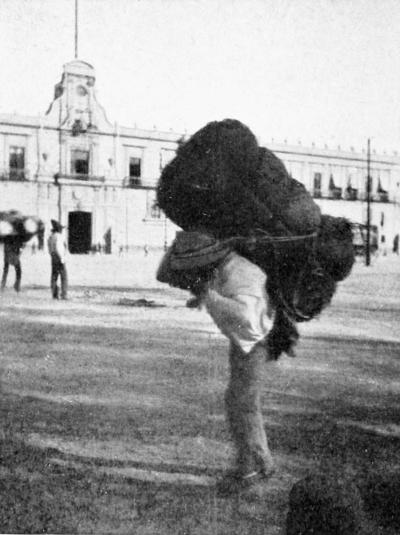
A CARGADORE BEARING VEGETABLES
Along the roads, trains of pack mules and burros, heavily laden, were toiling toward the great city, and many footfarers were bearing upon their backs enormous packs, the weight resting on the shoulders, and held in place by a strap about the forehead. When the Aztecs were lords of Mexico and Montezuma ruled, the horse, the ox, the ass, the sheep were unknown upon the American continent. All burdens and all freight were then carried upon the backs and shoulders of the Indians, who from their forefathers had inherited the hardy muscles and the right to bear the traffic of the land. And from these ancestors the Indian cargadores of to-day have received the astonishing strength, enabling them to bear these great loads with apparent ease; the Indian, with his jog-trot gait, carrying a hundred pounds upon his back a distance of fifty miles a day. A large part of the fruit, vegetables and tropical products displayed each day in the markets of the city are thus brought up from distant lowland plantations upon the backs of men. As we approached the city, nearer and nearer, the highways we ran beside or cut across were filled more and more with these pack trains and cargadores, and with men and women faring cityward.
We finally drew into a large newly-built station of white sandstone. Pandemonium reigned upon the platform alongside which we stopped. Men were embracing each other, slapping each other’s backs and kissing either cheek. Women flew into each other’s arms and children kissed their elders’ hands. We passed along through wide gateways and into a paved semicircular courtyard, where were drawn up carriages with bands of yellow or red or blue across the door. Those with yellow bands are cheap and dirty, those with blue bands mean a double fare and those with red bands are clean and make a reasonable charge, all of which is regulated by the Federal government. I entered one of the red-banded vehicles. The driver called two cargadores, who seized my steamer trunks, loaded them on their backs and ran along beside us. The horses started on a half gallop and when we reached the hotel, the cargadores, with the trunks upon their backs were there as well, less out of breath than the panting team, and each was gratified with a Mexican quarter for his pay (equal to an American dime), while my cochero swore in profuse Spanish because I did not pay him five times his legal fare.
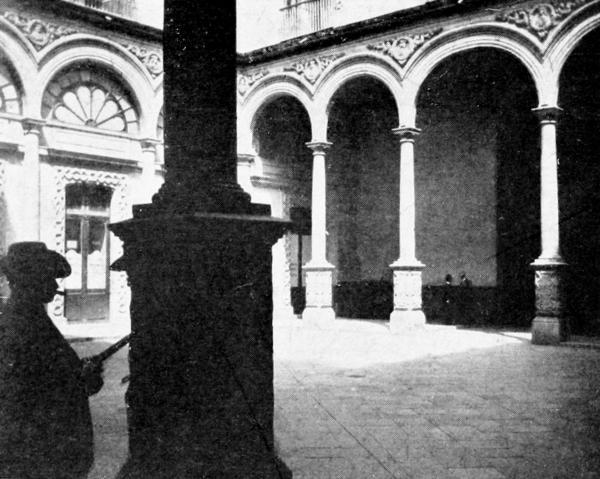
PATIO—HOTEL ITURBIDE
I was come to the one-time palace of the Emperor Iturbide, and was welcomed by the American speaking Administrador, in softly accented Louisianian speech.
V
First Impressions of Mexico City
Hotel Iturbide,
November 20th.
When I awoke this morning, the bare stone walls of my chamber, the stone-paved floor, the thin morning air drifting in through the wide-open casements, all combined to give me that sensation of nipping chilliness, which may perhaps only be met in altitudes as high as these. I am a mile and a quarter in the air above the city of Charleston-Kanawha, a mile and half above the city of New York. By the time I had made my hasty toilet, my fingers were numb with the cold. I put on my winter clothes, which I had brought with me for use when returning to Virginia in January. I also put on my overcoat.
Leaving my vault-like chamber, I passed along the stone-flagged hallways, down the stone flights of stairs, into the stone-paved court, passed out through the narrow porter’s door and found myself among the footfarers on the Calle de San Francisco. It was early. The street was still in the morning shadows. The passers-by, whom I met, were warmly wrapped up. The rebozos of the women were wound about the head and mouth. The zerapes of the men were held closely about the shoulders and covered the lower face. Overcoats were everywhere in evidence, and scarfs shielded the mouths of the Frenchly uniformed police. All these were precautions against the dread pneumonia, the most feared and fatal ailment of Mexico.
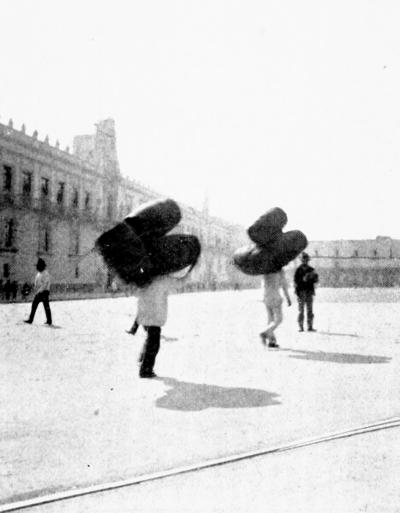
CARGADORES TOTING CASKS
I entered a restaurant kept by an Irishman speaking with a Limerick brogue, but calling himself a citizen of the United States. I came into a high, square room with stone walls, stone floor, windows without glass, with many little tables accommodating three and four. Here were a few Americans with their hats off, and many Mexicans with their hats on. A dish of strawberries was my first course, the berries not very large, a pale pink in color, very faint in flavor. These are gathered every day in the year from the gardens in the neighborhood of the city. My coffee was con leche (with milk). I asked for rolls and a couple of blanquillos (eggs) passados por agua (passed through the water, i. e. soft boiled). For a tip, cinco centavos (five cents in Mexican, equal to two cents in United States) was regarded as liberal by the Indian waiter. Upon leaving the
wide entrance, I found the shadows fled and the sunshine flooding its white rays upon the street.
Leaving my overcoat in the hotel, I took my way toward the lovely Alameda Park, where, choosing a seat beneath a splendid cypress, I sat in the delicious sunshine and watched the moving crowds. Many droves of mules, laden with products of the soil, were coming into the city. Later in the day, these same carriers of freight go out again, laden with merchandise for distribution to all the cities and villages of the mountain hinterlands.
An Indian mother passes by, her baby caught in the folds of her rebozo. I toss her a centavo, and she allows me to kodak herself and child.
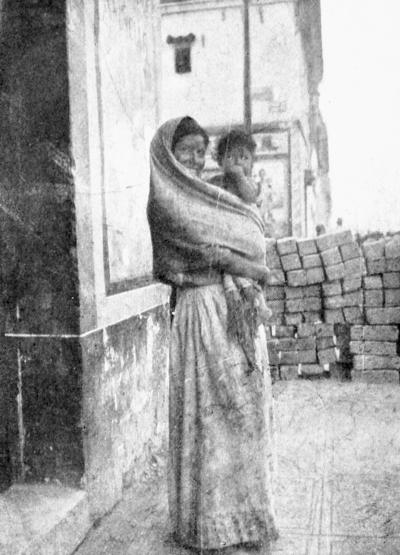
A SNAP-SHOT FOR A CENTAVO
A handsome man riding a fine, black horse, pauses a moment at the curb. He is gratified that I should admire the splendid animal. He reins him in, and I capture a view.
A rancherro in all the gaudy splendor of gilt braid, silver-laced pantaloones, and costly saddle, behung with ornaments of trailing angora goat’s wool, draws near me. He permits me to photograph his fine sorrel horse, but will never allow me to take himself face to face. He halts, that his animal may be admired by the passing throngs; he chats with friends who linger by his side, but whenever I try to catch his face he wheels about.
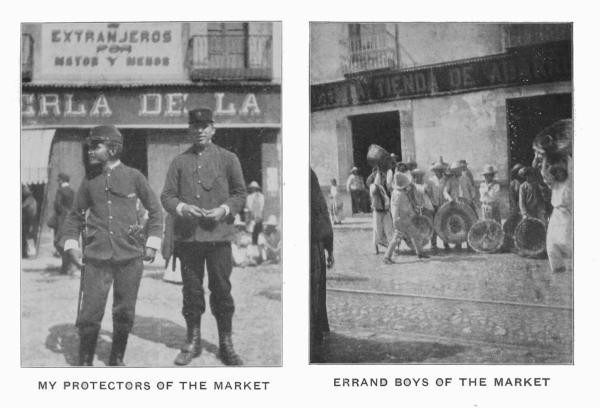
MY PROTECTORS OF THE MARKET & ERRAND BOYS OF THE MARKET
The dulce sellers bearing sweets in trays upon their heads; the flower venders carrying baskets piled high, such roses as only veritable trees may yield, come also within the vision of my kodak.
Later, I take my way to the Plaza Grande, fronting the Cathedral, and there again catch glimpses of the life of the city. Here are men bearing upon their shoulders casks, apparently filled, bales of garden produce, crates of chickens. Every sort of portable thing is here borne upon the human back. Now and then one or another seats himself upon the stone and iron benches and engages in gossip. Of these, also, my camera makes note.
Later in the morning, I saunter through many streets, inquiring my way to one of the great markets. Here I linger, going about from stall to stall and taking a picture as my fancy urges. A policeman, uniformed like a Paris gendarme, eyes me curiously, comprehends the power of my camera, and comes up to me smiling. He drives back the crowd, calls up his companion-in-arms and stands at attention, begging me to send him a copy of the picture. A group of errand boys, who carry large flat baskets, and will take anything home you buy, attracted by the mysterious black box, line up and motion that their pictures also be taken. The instantaneous movement of
the shutter strikes them with wonder, when, throwing a few centavos among them, I catch them now struggling for the coin. I have become the center of attraction. The swarming street crowd crushes about me, all eager to face the magic instrument, till I am fain to call upon my policemen friends to fend them off.
Standing there, joking with my guardians and keeping the good will of the increasing mob, I am accosted by a tall, thin-bearded gentleman in rusty though once fashionable black. He speaks to me in French. He is from Paris, he says; and Ah! have I really been there in Paris! Très jolie Paris! He also enjoys coming to the markets, and wandering among the stalls, and watching the people, and noting their habits and their ways. He guides me about among the different sections, commenting on the fruits and vegetables and wares. When we have spent an interesting hour, he invites me to share a bottle of French wine, a delicious claret, and then, lifting his hat, bids me adieu and is lost forever among the swarming multitudes.
There is so much to see in this ancient city, so much to feel! It is so filled with historical romance! As I wander about it, my mind and imagination are continually going back to the pages of Prescott and Arthur Helps, whose histories of Spanish invasion and conquest I used to pore over when a boy, and to the tragedies which Rider Haggard and Lew Wallace so graphically portray. I scarcely dare take up my pen, so afraid am I of retelling what you already know. I am ever seeing the house tops swarming with the dark hosts of Montezuma, hurling the rocks and raining the arrows upon the steel-clad ranks of Cortez and his Christian bandits as they fight for life and for dominion in these very streets below.
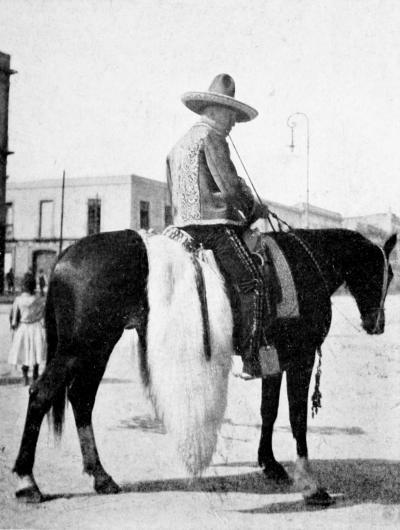
A RANCHERRO DUDE
I stood, this morning, within the splendid cathedral, built upon the very spot where once towered the gigantic pyramid on whose summit the Aztec priests sacrificed their human victims to their gods, while down in the dungeons beneath my feet, the Holy Inquisition, a few years later, had also tortured men to their death, human victims sacrificed to the glory of the Roman Church. An Aztec pagan, a Spanish Christian, both sped the soul to Paradise through blood and pain, and I wondered, as I watched an Indian mother kneel in humble penitence before an effigy of the Virgin, and fix a lighted taper upon the altar before the shrine, whether she, too, felt clustering about her, in the sombre shadows of the semi-twilight, memories of these tragedies which have so oppressed her race.
On these pavements, also, I review in fancy
the serried regiments of France and Austria marshaled in the attempt to thrust Maximillian upon a cis-Atlantic Imperial throne. In this day, one recalls almost with incredulity the insolence of this conspiracy by European Monarchy to steal a march on Western liberty, when it was thought that democracy was forever smitten to the death by civil war. But the bold scheme was done to death by Juarez, the Aztec, without Sheridan’s having to come further south than the Rio Grande.
All these pictures of the past, and many more, crowd thick upon me as I walk the streets and avenues of this now splendid modern city.
I have also tried to see what I could of the churches,—the more important of them—which here abound, but my brain is all in a whirl, and saints and Madonnas troop by me in confused and interminable train.
Ever since Cortez roasted Guatemozin upon a bed of coals, to hasten his conversion to the Roman faith and quicken his memory as to the location of Montezuma’s hidden treasure, the Spanish conquerors have been building churches, shrines and chapels to the glory of the Virgin, the salvation of their own souls and the profit of their private purse. Whenever a Spaniard got in a tight place, he vowed a church, a chapel or a shrine to the Virgin or a saint. If luck was with him, he hadn’t the nerve to back down, but made some show of keeping his vow and, the work once started, there were enough other vowing sinners to push the job along. Mexican genius has found its highest expression in its many and beautiful churches, and perhaps it has been a good thing for genius that so many sinners have been ready to gamble on a vow.
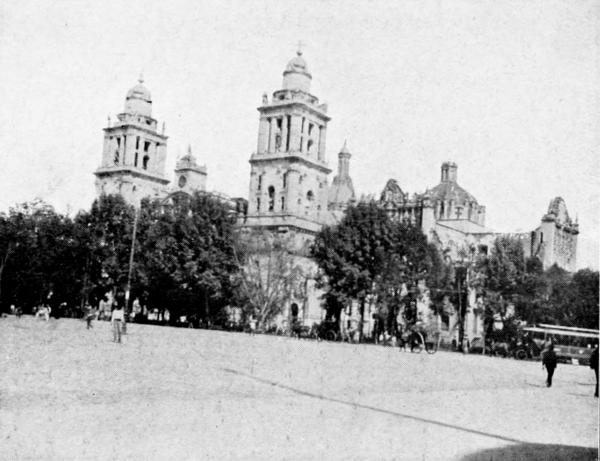
THE CATHEDRAL—MEXICO CITY
When Juarez shot Maximillian he also smote the Roman Church. The Archbishop of Mexico, and the church of which he was virtual primate, had backed the Austrian invader. Even Pope Pius IX had shed benedictions on the plot. When the Republic crushed the conspirators, the Roman Church was at once deprived of all visible power. Every foot of land, every church edifice, every monastery, every convent the church owned in all Mexico was confiscated by the Republic. The lands and many buildings were sold and the money put in the National Treasury. Monks and nuns were banished. Priests were prohibited from wearing any but ordinary garb. The Roman Church was forbidden ever again to own a rod of stone or a foot of land.
So now it is, that the priest wears a “bee-gum” hat and Glengarry coat, and the state takes whatever church-edifices it wants for public use. The church of San Augustin is a public library. Many
churches have been converted into schools. Others have been pulled down, and modern buildings erected in their stead. The cloisters and chapel of the monastery of the Franciscans are leased to laymen, and have become the hotel Jardin. What churches the Republic did not need to use, it has been willing to rent to the Roman hierarchy for the religious uses of the people. So many have been these edifices that, despite the government’s appropriations and private occupations, there yet remain church buildings innumerable where the pious may worship and the priesthood celebrate the mass. But the Roman hierarchy has no longer the wealth and will to keep these buildings in repair and in all of those I visited there was much dilapidation.
While it is true that the stern laws of the Republic debar the Roman Church from owning land, yet, it is said, this law is now evaded by a system of subrosa trusteeships, whereby secret trustees already hold vast accumulations of land and money to its use. And although the church cannot go into court to enforce the trust, yet the threat of dire pains in Purgatory is seemingly so effective that there is said to have been extraordinary little loss by stealing. The promise of easy passage to Paradise also makes easy the evasion of human law.
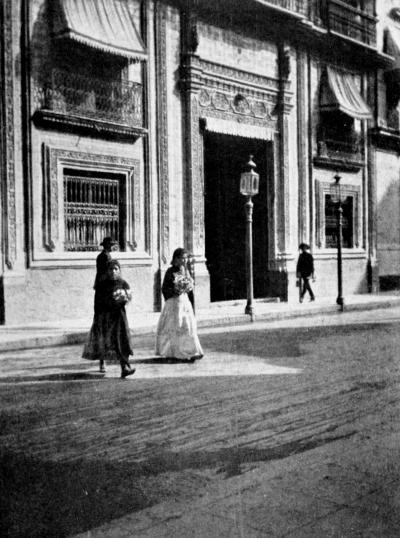
LA CASA DE AZULEJOS, NOW JOCKEY CLUB
VI
Vivid Characteristics of Mexican Life
Hotel Iturbide, Mexico,
November 22d.
This limpid atmosphere, this vivifying sun,—how they redden the blood and exhilarate the spirit! This is a sunshine which never brings the sweat. But yet, however hot the sun may be, it is cold in the shadow, and at this I am perpetually surprised.
The custom of the hotels in this Latin land is to let rooms upon the “European” plan, leaving the guest free to dine in the separate café of the hotel itself, or to take his meals wherever he may choose among the city’s multitude of lunch rooms and restaurants. Thus I may take my desayuno in an “American” restaurant, where the dishes are of the American type, and my almuerzo, the midmorning meal, in an Italian restaurant where the dishes of sunny Italy are served; while for my comida, I stroll through a narrow doorway between sky blue pillars, and enter a long, stone-flagged chamber, where neat tables are set about and where the Creole French of Louisiana is the speech of the proprietor. Here are served the most delicious meals I have yet discovered. If you want fish, a swarthy Indian waiter presents before you a large silver salver on which are arranged different sorts of fish fresh from the sea, for these are daily received in the city. Or, perhaps, you desire game, when a tray upon which are spread ducks and snipe and plover, the heads and wings yet feathered, is presented to you. Or a platter of beefsteaks, chops and cutlets is held before you. From these you select what you may wish. If you like, you may accompany the waiter who hands your choice to the cook, and you may stand and see the fish or duck or chop done to a turn, as you shall approve, upon the fire before your eyes. You are asked to take nothing for granted, but having ascertained to your own satisfaction that the food is fresh, you may verify its preparation, and eat it contentedly without misgiving. In this autumn season, flocks of ducks come to spend their winters upon the lakes surrounding the city. At a cost of thirty cents, our money, you may have a delicious broiled teal with fresh peas and lettuce, and as much fragrant coffee as you will drink. The food is cheap, wholesome and abundant. And what is time to a cook whose wages may be ten or fifteen centavos a day, although his skill be of the greatest!
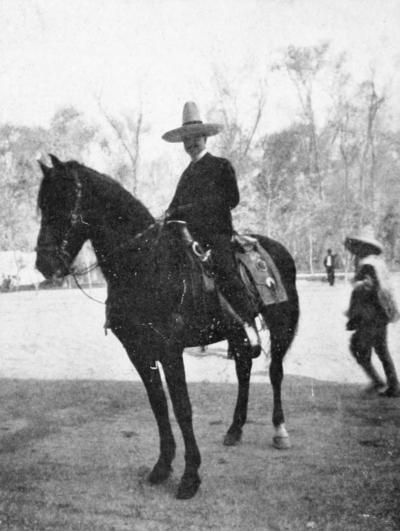
PLEASED WITH MY CAMERA
The city is full of fine big shops whose large windows present lavish displays of sumptuous fabrics. There is great wealth in Mexico. There is also abject poverty. The income of the rich comes to them without toil from their vast estates, often inherited in direct descent from the Royal Grants of Ferdinand and Isabella to the Conquestadores of Cortez, when the fruitful lands of the conquered Aztecs were parceled out among the hungry Spanish compañeros of the Conqueror. Some of these farms or haciendas, as they are called, contain as many as a million acres.
Mexico is to all intents and purposes a free trade country, and the fabrics and goods of Europe mostly supply the needs and fancies of the Mexicans. The dry goods stores are in the hands of the French, with here and there a Spaniard from old Spain; the drug stores are kept by Germans, who all speak fluent Spanish, and the cheap cutlery and hardware are generally of German make. The wholesale and retail grocers have been Spaniards, but this trade is now drifting to the Americans. There are some fine jewelry stores, and gems and gold work are displayed in their windows calculated to dazzle even an American. The Mexican delights in jewels, and men and women love to have their fingers ablaze with sparkling diamonds, and their fronts behung with many chains of gold. And opals! Everyone will sell you opals!
In leather work, the Mexican is a master artist. He has inherited the art from the clever artificers among the ancient Moors. Coats and pantaloons (I use purposely the word pantaloons) and hats are made of leather, soft, light and elastic as woven fibre. And as for saddles and bridles, all the accoutrements of the caballero are here made more sumptuously than anywhere in all the world.
The shops are opened early in the morning and remain open until noon, when most of them are closed until three o’clock, while the clerks are allowed to take their siesta, the midday rest. Then in the cool hours of the evening they stay open until late.
Over on one side of a small park, under the projecting loggia of a long, low building, I noticed, to-day, a dozen or more little tables, by each of which sat a dignified, solemn-looking man. Some were waiting for customers, others were writing at the dictation of their clients; several were evidently composing love letters for the shy, brown muchachas who whispered to them. Of the thirteen millions constituting the population of the Mexican Republic, less than two millions can read and write. Hence it is, that this profession of scribe is one of influence and profit.
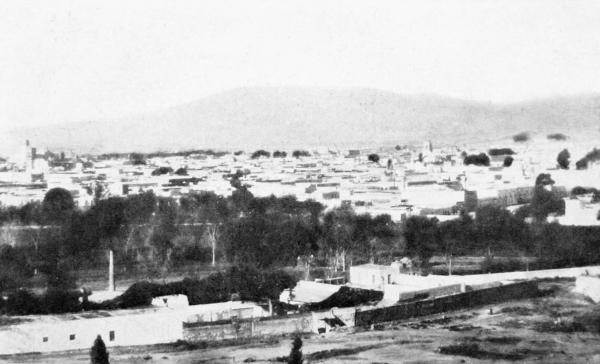
VOLCANO DE POPOCATEPETL
I have once more visited the famous cathedral which faces the Plaza Grande. From the north tower of it, to the top of which I climbed by a wonderful convoluted staircase, ninety-two spiral steps without a core, I gained a view of the city. North and south and east and west it spread out several miles in extent. It lies beneath the view, a city of flat roofs, covering structures rarely more than two stories high, of stone and sun-dried brick, and painted sky blue, pink and yellow, or else remaining as white and clean as when first built, who knows how many hundreds of years ago? For here are no chimneys, no smoke and no soot! To the south I could descry the glistening surface of Lake Tezcoco, and to the west, at a greater distance, Lakes Chalco and Xochomilco. Never a cloud flecked the dark blue dome of the sky. Only, overhead, I noted one burst of refulgent whiteness. It was with difficulty that I could compel my comprehension to grasp the fact that this was nothing less than the snow summit of mighty Popocatepetl, so distant that tree and earth and rock along its base, even in this pellucid atmosphere, were hid in perpetual haze.
It is said that peoples differ from one another not merely in color, in form and in manners, but equally so in their peculiar and individual odors. The Chinese are said to find the European offensive to their olfactory nerves because he smells so much like a sheep. The Englishman vows the Italian reeks with the scent of garlic. The Frenchman declares the German unpleasant because his presence suggests the fumes of beer. Just so, have I been told that the great cities of the world may be distinguished by their odors. Paris is said to exhale absinthe. London is said to smell of ale and stale tobacco, and Mexico City, I think, may be said to be enwrapped with the scent of pulque (Pool-Kay). “Pulque, blessed pulque,” says the Mexican! Pulque, the great national drink of the ancient Aztec, which has been readily adopted by the Spanish conqueror, and which is to-day the favorite intoxicating beverage of every bibulating Mexican. At the railway stations, as we descended into the great valley wherein Mexico City lies, Indian women handed up little brown pitchers of pulque, fresh pulque new tapped. Sweet and cool and delicious it was, as mild as lemonade (in this unfermented condition it is called agua miel, honey water). The thirsty passengers reached out of the car windows and gladly paid the cinco centavos (five cents) and drank it at leisure as the train rolled on. Through miles and miles we traversed plantations of the maguey plant from which the pulque is extracted. For pulque is merely the sap of the maguey or “century plant,” which accumulates at the base of the flower stalk, just before it begins to shoot up. The pulque-gatherer thrusts a long, hollow reed into the stalk, sucks it full to the mouth, using the tongue for a stopper, and then blows it into a pigskin sack which he carries on his back. When the pigskin is full of juice, it is emptied into a tub, and when the tub is filled with liquor it is poured into a cask, and the cask is shipped to the nearest market. Itinerant peddlars tramp through the towns and villages, bearing a pigskin of pulque on their shoulders and selling drinks to whosoever is thirsty and may have the uno centavo (one cent) to pay for it. When fresh, the drink is delightful and innocuous. But when the liquid has begun to ferment, it is said to generate narcotic qualities which make it the finest thing for a steady, long-continuing and thorough-going drunk which Providence has yet put within the reach of man. Thousands of gallons of pulque are consumed in Mexico City every twenty-four hours, and the government has enacted stringent laws providing against the sale of pulque which shall be more than twenty-four hours old. The older it grows the greater the drunk, and the less you need drink to become intoxicated, hence, it is the aim of every thirsty Mexican to procure the oldest pulque he can get. In every pulque shop, where only the mild, sweet agua miel, fresh and innocuous, is supposed to be sold, there is, as a matter of fact, always on hand a well fermented supply, a few nips of which will knock out the most confirmed drinker almost as soon as he can swallow it.
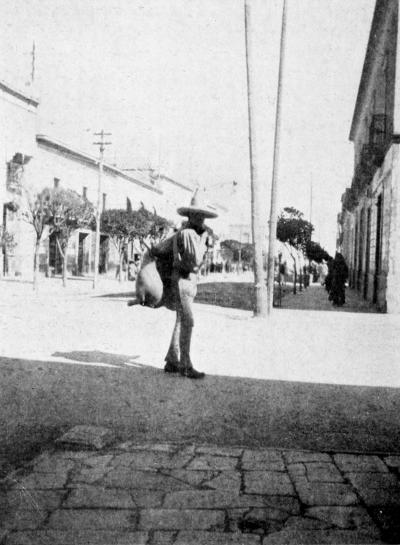
A PULQUE PEDDLER
I was passing a pulque shop this afternoon when I noticed a tall, brawny Indian coming out. He walked steadily and soberly half way across the street, when all of a sudden the fermented brew within him took effect and he doubled up like a jackknife, then and there. Two men thereupon came out of the self same doorway, picked him up head and heels, and I saw them sling him, like a sack of meal, into the far corner of the shop, there to lie, perhaps twenty-four hours, till he would come out of his narcotic stupor.
Riding out to the shrine of Guadeloupe the other afternoon, I passed many Indians leaving the city for their homes. Some were bearing burdens upon their backs, some were driving donkeys loaded with goods. Upon the back of one donkey was tied a pulque drunkard. His legs were tied about the donkey’s neck and his body was lashed fast to the donkey’s back. His eyes and mouth were open. His head wagged from side to side with the burro’s trot. He was apparently dead. He had swallowed too much fermented pulque. His compañeros were taking him home to save him from the city jail.
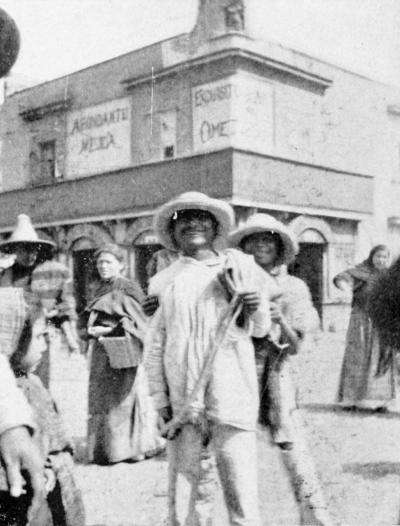
A FRIEND OF MY KODAK
The Mexicans have a legend about the origin of their pulque. It runs thus: One of their mighty emperors, long before the days of Montezuma’s rule, when on a war raid to the south, lost his heart to the daughter of a conquered chief and brought her back to Tenochtitlan as his bride. Her name was Xochitl and she gained extraordinary power over her lord, brewing with her fair, brown hands a drink for which he acquired a prodigious thirst. He never could imbibe enough and, when tanked full, contentedly resigned to her the right to rule. Other Aztec ladies perceiving its soothing soporific influence upon the emperor, acquired the secret of its make and secured domestic peace by also administering it to their lords. Thus pulque became the drink adored by every Aztec. The acquisitive Spaniard soon “caught on” and has never yet let go.
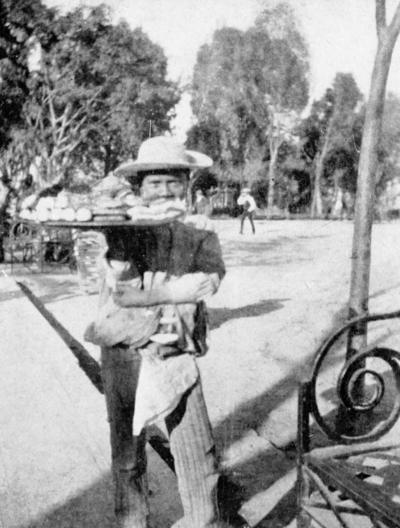
DULCE VENDER
The one redeeming feature about the pulque is that he who gets drunk on it becomes torpid and is incapable of fight. Hence, while it is so widely drunk, there comes little violence from those who drink it.
But not so is it with mescal, a brandy distilled
from the lower leaves and roasted roots of the maguey plant. It is the more high priced and less generally tasted liquor. Men who drink it become mad and, when filled with it, sharpen their long knives and start to get even with some real or imaginary foe. Fortunately, mescal has few persistent patrons. It is pulque, the soporific pulque that is the honored and national beverage of the Mexican.
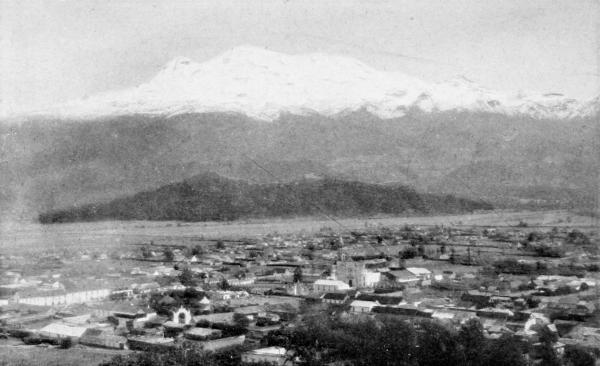
VOLCANO DE IZTACCIHUATL
VII
A Mexican Bullfight
Mexico City,
Sunday, November 24th.
A feeling first of disgust and then of anger came over me this afternoon. I was sitting right between two pretty Spanish women, young and comely. One of them as she came in was greeted by the name Hermosa Paracita (beautiful little parrot), by eight or ten sprucely dressed young Spaniards just back of me. The spectators with ten thousand vociferous throats had just been cheering a picador. He had done a valiant deed. He had ridden his blindfolded horse around the ring twice, lifting his cap to the cheering multitude. He was applauded because he had managed to have the belly of his horse so skillfully ripped open by the maddened black bull, that all its vitals and entrails were dragging on the ground while he rode it, under the stimulus of his cruel spurs and wicked bit, twice around the ring before it fell, to be dragged out, dying, by mules, gaily-capari
soned in trappings of red and gold, tugging at its heels! Paracita clapped her pretty bejeweled hands and cried “bravo!” And so did the scores of other pretty women; women on the reserved seats, elegant ladies and pretty children in the high-priced boxes on the upper tiers! The howling mob of thousands also applauded the gallant picador! Would he be equally fortunate and clever and succeed in having the next horse ripped open so completely, all at one thrust of the bull’s horns? Quien sabe?
The city of four hundred thousand inhabitants, capital of the Mexican Republic, had been profoundly stirred all the week over the arrival from Spain of the renowned Manzanillo and his band of toreadors (bullfighters). Their first appearance would be the opening event of the bullfighting season.
Manzanillo, the most renowned Toreador of old Spain! And bulls, six of them, of the most famous strains of Mexico and of Andalusia! Señor Limantour, Secretary of State for Mexico, spoken of as the successor to President Diaz, had just delighted the jeunesse dorée by publicly announcing his acceptance of the honor of the Presidency of the newly founded “Bullfighting Club.” Spanish society and the Sociadad Española had publicly serenaded Don Manzanillo at his hotel! A dinner would be given in his honor after the event! Men and women were selling tickets on the streets. Reserved tickets at five dollars each, could only be obtained at certain cigar stores. The rush would be so great that, to secure a ticket at all, one must buy early. I secured mine on Thursday, and was none too soon. The spectacle would come off Sunday afternoon at three o’clock, by which hour all the churches would have finished their services, and the ladies would have had their almuerzo, and time to put on afternoon costume.
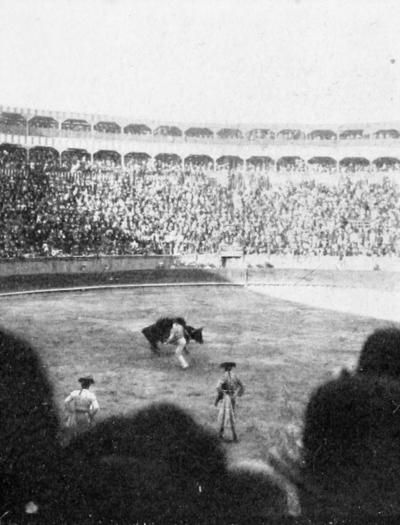
SETTING A BANDERILLA
By noon the drift of all the street crowds was toward the bull ring, a mile or two out near the northwest border of the city. All street cars were packed and extra cars were running; even all carriages and cabs were taken, and the cabmen commanded double prices. I had retained a carriage the day before. At the restaurant I could scarcely get a bite, the waiters and cooks were so eager to get through and escape, even for a single peep at the spectacle. As I drove out, young ladies were standing in groups at the gateways of many fashionable residences waiting for their carriages to take them to the ring. As I approached the arena, the throngs upon the streets and sidewalks blocked the way.
Hundreds of Indians and Mexicans, mostly women, had set up temporary eating stands along
the roadside. Fruit, tortillas, steaming broth and meat roasting over fires, tempted the hungry. These stands would feed a multitude. It was early, but the city fire department was already on hand with apparatus to extinguish any possible blaze among the wooden tiers of seats. A battalion of mounted police sat on their blood-bay horses at intervals along the road, their gaudy blue and gold uniforms setting off effectively their dark brown skins. We entered a large gateway, gave up half of our tickets, and then passed in to a broad flight of steps. We ascended to the tiers of seats and chose good places. Presently, two companies of infantry with set bayonets also entered and took up their positions. Often the mob becomes so mad with blood-lust, that bayonets are needed to keep order, sometimes also bullets.
It was an hour before the set time, but none too early. The crowds, all well dressed on this side, every one of whom had paid five dollars for a ticket, kept pouring in. Across on the other side swarmed the cheap mob. Behind me was a row of young Spaniards. They stood up and called nicknames to all their friends who entered within reach of their vision. They cheered every pretty well dressed woman. They howled like mad when the band came in, they fairly burst themselves when, at last, Manzanillo, the toreador, the matadores, picadores, the valiant gold-laced company of bullfighters, entered and marched around the ring.
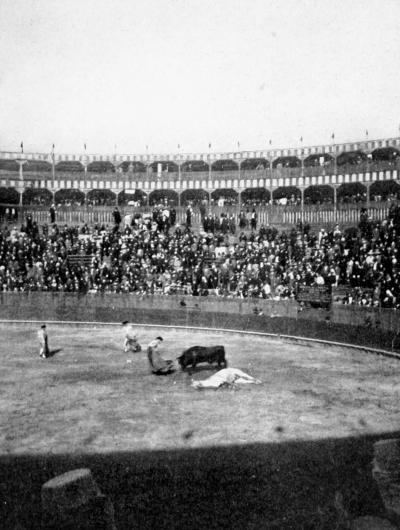
TEASING EL TORO
Manzanillo sat on a superb Andalusian charger which pranced and threw up his forefeet as though conscious of the illustrious character of his master. Then Manzanillo dismounted and took his place, the picadores stationed their horses on either side and pulled over their eyes the bandages to blindfold them, others carrying big gold-embroidered red shawls, stood all attention, the band struck up, the door opposite me was thrown open and a handsome, black-brown bull trotted in. As he passed the gate he received his first attention. Two rosettes of scarlet and gold ribbons were hooked into his shoulders, with steel teeth, enough to irritate him just a little. He stood there amazed. The crowd cheered him. A man in gold lace promptly flaunted a red shawl in his face. He charged it. The man stepped lightly aside and bowed to the audience, who cheered vociferously. “Bravo! Well done!” Then one of the blindfolded horses was spurred toward the bull. The bull was dazed and angry. He charged right at the horseman. The horseman lowered his spear and caught the bull in the shoulder. The bull flinched to one side. The audience cheered the picador, but the bull dexterously turning, charged
the horse on the other side, and, before the poor beast could be turned, drove his sharp horns into his abdomen, ripped it up and upset the rider and horse in a cloud of dust. The audience now cheered the bull. A dozen men rushed to the rescue and dragged the picador away. The horse lay there and the bull charged it again, and again ripped out more entrails. The audience cheered the bull, and the bull, encouraged by the applause, took another turn at the dying horse. Just then a dexterous footman slung the red sheet in the bull’s face and he turned to chase it. But all in vain! Charge the red vision all he would, he never caught anything but thin air! He could never catch the man.
Then the bull saw another horse blindly sidling towards him, for though blindfolded, the old horse could yet smell the bull and the blood, and only went forward under the pressure of savage spur and bit. The bull stood gazing at the horse and rider a moment, then he charged right at them with head down. He caught the horse in the belly and ripped out its entrails, which dragged on the ground, while the brave picador continued to ride it about, and sought yet again to engage the attention of the bull.
But the bull was now tired. He thought of his mountain pastures and the sweet, long grass of the uplands. He would go home. He would fight no more. He wanted to get out, he wanted badly to get out. The now hissing mob scared him worse than when they cheered. He ran about the ring trying all the locked doors. He couldn’t force them. Then he tried to climb over the high wall, to jump over anyway. He was frantic with pathetic panic. But shouting men stood round the parapet and clubbed him over the head. So he gave up and returned to the center of the ring, panting, his tongue hanging out, foam dripping from his jaws. He was altogether winded.
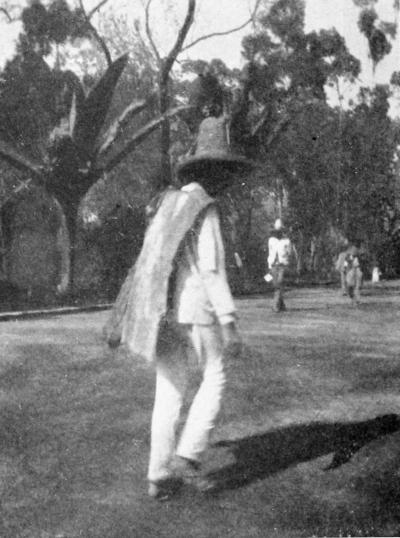
THE GARDENS OF CHAPULTEPEC
Now was Manzanillo’s opportunity. He carried a small purple gold-fringed scarf over his left arm, and his long, straight naked sword in his right hand. He stood directly in front of the bull. He caught its eye. He waved the purple banner. Almost imperceptibly he approached. The bull stood staring at him, legs wide apart, sides panting, tail lashing, head down, tired but ready to charge. Then, quick as lightning, Manzanillo stepped up to the bull, straight in front of him, and reaching out at arm’s length drove the sword to the very hilt right down between the shoulder blades. It was a mortal stroke, a wonderful thrust, perfect, precise, fatal. Only a master of his craft could do just such a perfectly exact act. And as quick as lightning did Manzanillo step aside, fold his arms and stand motionless, not ten feet from the bull, to watch him die. He gave only one sweeping bow to the audience. The Spaniard is a connoisseur in all the delicate and subtle masterstrokes in this duel of man and beast. Manzanillo had sustained his reputation as the greatest living bullfighter of old Spain. The nerve, the agility, the lightning-like act—too quick for human eye to follow—the perfect judgment of time and distance and force, all these he had now displayed. The vast audience broke out into one simultaneous “Bravo,” rose to its feet and then, like the matador, stood silent and breathless to watch the bull die,—to see the hot blood pour from mouth and nostrils, the sturdy thighs and shoulders shake, the powerful knees bend. The nose sank to the dust, the knees trembled, the bull rolled in the sand, quite dead. Manzanillo drew out his reeking sword. Again he bowed to the vast multitude, and no human being ever received a more overwhelming ovation than did he. Flowers were thrown him in heaps. Sometimes women even take off their jewels and throw them, and kiss the hero when they later meet him on the street. So great is the joy of the blood-lust! So has the frenzy of the Roman arena descended to some of Rome’s degenerate sons. Mules in gay red and gold trappings now dragged out the bull as they had the horse. There would be cheap stews for the multitude in the city to-night.
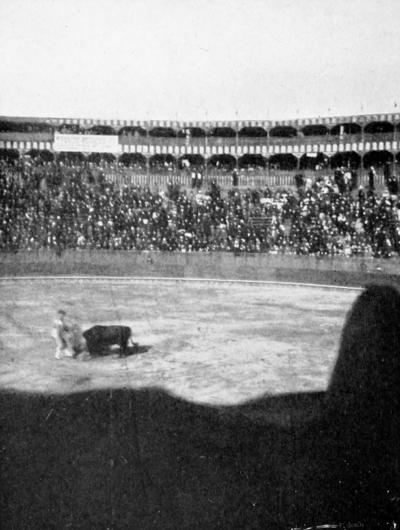
MANZANILLO’S FATAL THRUST
The next bull was jet-black, big, sturdy, ferocious. He scorned to charge or gore a blindfolded horse, but he chased a man wherever in sight. Such a bull is according to the Spanish heart! The audience cheered him wildly. He ripped up three or four horses just because he had to, in order to get at the man on their backs. One of the horses had been ripped up by the first bull, but his dusty entrails had been put back, the rent sewn up, and under cruel spur and bit he had been presented to the second bull to be again splendidly and finally ripped wide open, ridden around the ring by his bowing rider, bloody entrails dragging in the dust, and applauded to his death by the blood-hungry multitude! The second bull was game! The banderillas were placed with danger and difficulty. These are two beribboned sticks tipped with steel gaffs that are jabbed into the bull’s shoulders, adding to the irritation of the rosettes, and increasing his desire for revenge. In the first bull they were perfectly planted and three pairs set in. In the second only one was got in at first, then a pair, then one again. Each setting of the banderillas is a dangerous feat! The bull must be approached from the front. Just as they are stuck into the maddened animal, the banderillador must step aside. He must be quick, very quick, as quick as the toreador in planting his fatal sword thrust. And not infrequently the banderillador gets tossed, and perhaps gored and killed by the bull. Hence the act, well done, receives deafening applause. Despite his fierce courage, this splendid black bull also met at last his inevitable fate, beneath the perfectly skillful thrust of Manzanillo.
The third bull was the biggest and oldest yet. Horses were ripped up by him in exciting succession and one picador was caught under his fallen horse and badly bruised. Nor was it so easy to kill this bull. The matador lost a trifle of his nerve. The sword only went in half way. It took the bull some time to bleed internally and die. With the sword-hilt waving between his shoulder blades, he tried to follow and gore the matador, but his strength began to fail. He stood still, his head sank down, his knees bent, he knelt. And the vast audience stood in hush and silence to watch with delighted expectancy the final oncoming of death. When he rolled over quite dead, the pretty women in the box behind me shouted and waved their dainty hands in mad delight.
The fourth bull was just ushered in when the brutality and cruelty and horror of it all quite nauseated me. I rose to go. My friend told our neighbors that I was “ill.” Otherwise they could not have understood my leaving in the midst of the fight. Afterward I heard it declared to be a very fine performance, for, as a little Mexican boy exclaimed delightedly, “they killed six bulls and thirteen horses! It was magnifico!”
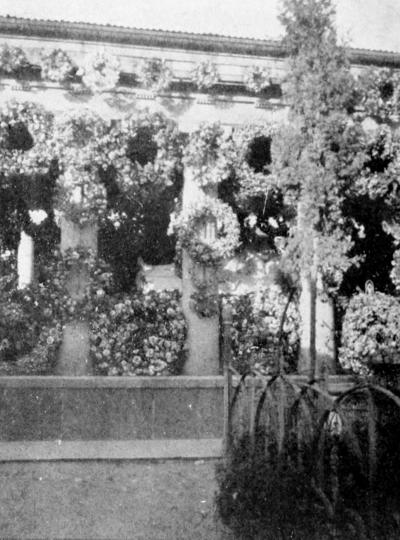
JUAREZ’ TOMB AND WREATHS OF SILVER
As I sat and looked out on the ten thousand faces of all classes, rich and poor, all radiant and frenzied with the blood-lust and the joy of seeing a creature tortured to the very death, and then heard the clang of the multitudinous church bells, calling to Vesper services, even before the spectacle was ended, I realized that, surely, I was among a different people, bred to a different civilization from my own; a civilization still mediæval and still as cruel as when the Inquisition sated even fanaticism with its cultivated passion for blood! I also shame to say that I met to-night two young American ladies, school teachers at Toluca, going home with two bloody banderillas plucked from one of the bulls—“Trophies to keep as souvenirs.” They “Had so much enjoyed the fine spectacle.” Thus do even my countrywomen degenerate, thus is the savage aroused within their hearts!
VIII
From Pullman Car to Mule-back
Michoacan, Mexico,
November 25th.
After the bullfight we had difficulty in finding a cocha to take us to the railway station. In fact, we could not get one. We were compelled to depend upon cargadores, who carried our trunks and bags upon their backs, while we jostled along the crowded sidewalks. And here, I might remark, that there is no such thing as a right-of-way for the footfarer on either street or sidewalk. You turn to the right or left, just as it may be most convenient and so does your neighbor. You cross a street at your peril, and you pray vigorously to the saints when you are run down.
We left Mexico City about five o’clock in the evening, taking the narrow gauge National Railway to Acambaro and Patzcuaro, where horses and a guide were to be awaiting us, and whence we would cross the highlands of the Tierra Fria and finally plunge into the remote depths of the Tierra Caliente, along the lower course of the Rio de las Balsas, where it forms the boundary line between the states of Michoacan and Guererro, on its way to the Pacific.
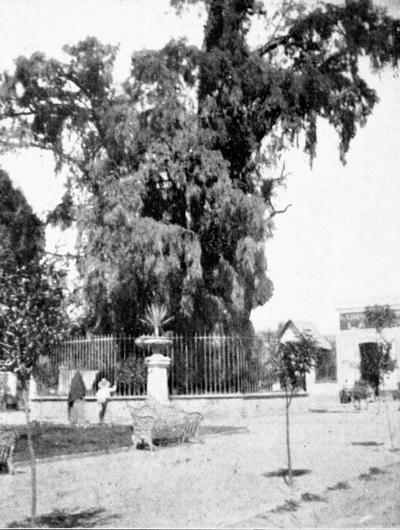
THE TREE WHERE CORTEZ WEPT EL NOCHE TRISTE
As we departed from the city, we passed through extensive fields of maguey, and began climbing the heavy grade which would lift us up some four thousand feet ere we should descend into the valley of Toluca, more lofty, but no less fertile than the basin of Anahuac. Before we crept up the mountain very far, darkness descended precipitately upon us, for there is no twilight in these southern latitudes.
We were at Acambaro for breakfast, and all the morning traversed a rolling, cultivated, timbered country much like the blue grass counties of Greenbrier and Monroe in West Virginia. Here we travelled through some of the loveliest landscapes in all Mexico. This is a region of temperate highlands amidst the tropics, so high in altitude lies the land,—seven to eight thousand feet above the sea. There was much grass land and there were wheat and corn fields many miles in area. Here and there crops were being gathered, and yokes of oxen were dragging wooden plows, the oxen pulling by the forehead as in France. Several successive crops a year are raised upon these lands. No other fertilization is there than the smile of God, and these crops have here been raised for a thousand years—irrigation being generally used to help out the uncertain rains. We passed vineyards, and apple and peach and apricot orchards, forests of oak and pine, several lakes, Cuitzeo and Patzcuaro, being the largest of them—lakes, twenty and thirty miles long and ten to twenty wide. Never yet has other craft than an Indian canoe traversed their light green, brackish waters.
These high upland lakes of Mexico are the resting-places of millions of ducks and other waterfowl, which come down from the far north here to spend the winter time. It is their holiday season. They do not nest or breed in Mexico. They are here as migratory winter visitors. Mexico is the picnic ground of all duckdom. On Lakes Tezcoco, Xochimilco and Chalco, near to Mexico City, the destruction of the wearied ducks is an occupation for hundreds of Indians, the birds being so tired after their long flight from sub-Arctic breeding grounds, that it is often many days before they are able to rise from the water, when once they have settled upon it. The Indians paddle among them with torches or in the moonlight, and club them to death, or gather them in with nets or even by hand, so easy a prey do they fall.
For many miles our train skirted these lovely sheets of water, and so tame were the waders and swimmers along the shores that they rarely took to flight, but swam and dove and flapped their wings and played among the sedges as though no railroad train were roaring by. Among them I looked for the splendid scarlet flamingo and roseate spoonbill, but happened to see none, although they are said often to frequent these shallow waters, but pelicans, herons and egrets I saw in thousands.
The first town of importance we reached, after leaving Acambaro, was Morelia, a city exceeding thirty thousand inhabitants, and the capital of the important state of Michoacan. The people gathered at the incoming of the train were rather darker in color than those in Mexico City, which seemed to indicate a greater infusion of Indian blood. Here we first beheld a number of priests garbed in cassock and shovel hat, a costume now forbidden by the laws.
At this station, too, we came upon a curious tuber which seemed to be cousin to the yam and the Irish potato. The Indians bake it and hand it to you bursting with mealy whiteness of a most palatable taste. The Mexican eats as opportunity occurs, and as opportunity is incessantly offered, he is always eating. At least, so it is with the Indian. Cooked food and fruits are sold at all times along the streets and highways everywhere. The hot tamale, and a dozen kindred peppered and scorching foods, are always to be had. Oranges and lemons, limes and pomegranates, figs and bananas, cocoanuts and sugar cane are sold at a price so low that the poorest can buy. Candied fruits are abundantly eaten, and delicious guava paste is handed up to the car windows on little trays.
Our sleeper went only as far as Morelia. After that we traveled in the day coach. Our traveling companions had been three or four Mexican gentlemen, who kept closely together, incessantly smoking cigarettes. In the day coach we were now traveling with people of the countryside. A tall, white-haired priest, in cassock and shovel hat, with bare feet thrust into black, leathern sandals, sat just in front of me. A large, brass crucifix, six or eight inches long, hanging about his neck, suspended by a heavy brass chain, was his only ornament. He was much interested in my kodak and watched me taking snap shots at the flying panorama. He indicated that he would like to have his own picture taken, arranging himself gravely for the ordeal. No sooner had I snapped the padre than several of his parishioners moved up and intimated that they also would be pleased to have me take their portraits. The film on which these pictures were taken was afterwards lost, or I should be able to present these friends to you.
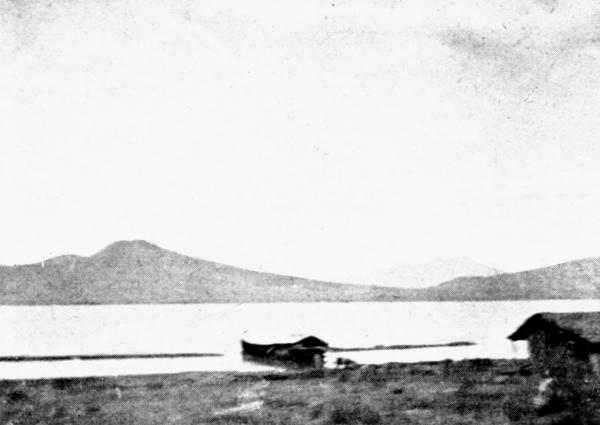
LAKE PATZCUARO
As we drew near Patzcuaro, the car filled up, and among the incomers were a number of pretty señoritas of high-class Spanish type. Their skins were fair, their facial outlines were softly moulded and their large dark eyes were lustrous beneath their raven hair. Most of the ladies smoked cigarettes, for every car is a smoking car in this Spanish-Indian land. Very few Indians rode upon the train. The railway is too expensive a mode of traveling for them.
It was past the midday hour when we came to Patzcuaro, a city of perhaps ten thousand souls. For many miles we had followed the shores of the lake of that name. Far across the light green waters I noted many islands. Upon one of these stands the Mission Church, where is preserved the famous altar painting supposed to be by Titian—a picture so sacred that it has rarely been looked upon by white men, much less by a heretic gringo. I had hoped to be able to voyage across the lake and see the precious painting, despite the jealous care with which the Indians are said to guard it, but the hurry of travel has made this impossible.
A crowd of almost pure Indians was gathered to meet the train. They watched us closely,
while we bargained for our trunks and bags to be carried upon the backs of eager cargadores two miles up the long hill to the town. We passengers entered an antique tram car, drawn by six mules. It was packed to suffocation, most of the occupants being ladies of the city, who had ridden down to see the train arrive and were now riding back again. Among them sat one whose cracking face, I was told, disclosed leprosy, a disease here not uncommon. Not many gringos visit Patzcuaro, and our strange foreign clothing and unknown speech were matters of curious comment. Our mules clambered up the hill at a gallop, urged by a merciless rawhide. We halted finally before a quaint and ancient inn, La Colonia. Through a big open doorway, into which a coach might drive, penetrating a high, white wall, we passed to an ill-paved interior courtyard, where our host, the landlord, greeted us with formal ceremony. He then led us up a flight of stone steps to a wide, stone-flagged piazza running round the interior of the court. We were there given rooms opening off this open corridor, each door being ponderously locked with a big iron key. I had scarcely reached my quarters before the cargadore brought in my trunk. He had carried it two miles upon his back in almost as quick time as we had traveled in the six-mule car. I paid him twenty-five cents (Mexican) for this service (ten cents in United States money). He bowed with gratitude at my liberal fee.
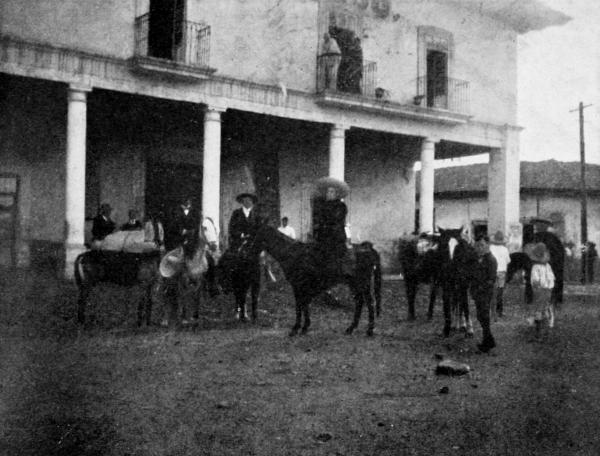
OUR DEPARTURE—FONDA DILIGENCIA
The inn faces upon a wide plaza around which are many ancient stone and adoby buildings, for Patzcuaro is an old city and was the chief Tarascon town before Cortez and his conquestedores made it the capital of a Spanish province. On one side of the plaza is a large and towered church, while beside it stand the extensive, crumbling walls of a dismantled convent. Upon the opposite side are many little shops, and upon the other two are inns of the city with their rambling courtyards, within which gather and disperse constantly moving streams of horsemen, mule drivers and pack beasts. Patzcuaro is the gateway through which a large commerce is borne by thousands of pack animals and Indian carriers to all the country in the southwest, even to La Union upon the Pacific, a hundred miles away. Until recently, through here also passed a large portion of the traffic which crossed the Rio de las Balsas and the Cordilleras to Acapulco.
My companions for the journey are three. There is “Tio,” as we have familiarly named him, who is leader of our company. He is a giant-framed mountaineer of the middle west, who has spent a life-time in prospecting the Rocky Moun
tains and the Cordilleras from Canada to Central America. Like all those of that fast disappearing race, the lone prospector, he is visionary and sanguine of temperament, and a delightful companion for a plunge among the wild and lonely regions of the Cordilleras. His imagination is eternally fired by the ignes-fatui of mineral wealth, and he has discovered, exploited and lost a hundred fortunes with no lessening of the gold-silver-copper hunger which incessantly gnaws his vitals. His muscles are of iron, his voice is deep and resonant. Kindly by nature, his solitary life has made him reticent and self-contained. Only incidentally do I learn of his past. A slight scar upon the back of his right hand is all that witnesses the smashing of a mescal-infuriated Indian who once went up against him with murderous two-bladed cuchillo; a bullet graze upon his brow is his only reference to a duel-to-the-death, where, it is whispered, the black eyes of a señorita were once involved. Grim and rugged and silent he declares himself to be a man of peace, and none there are who care to disturb this tranquility. But despite his austerity, Tio has a weakness. He is not a little vain of his mastery of the idiomatic intricacies of the Iberian tongue. Nothing delights him more than to dismay a humble peon by the sonorous bellowing of a salutation put in vernacular Spanish or Tarascon. He rides beside me and acquaints me with the history, geography and probable mineral riches of the land we traverse.
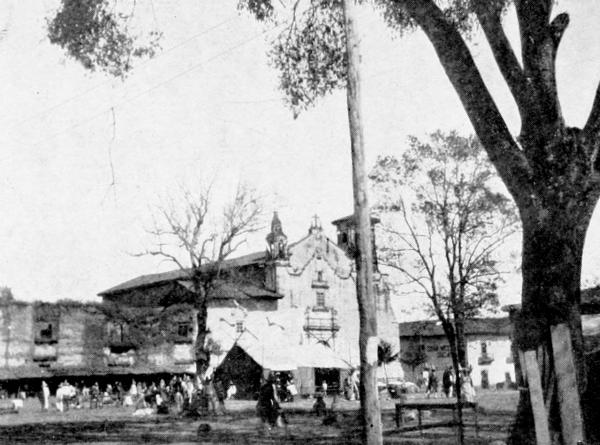
THE DISMANTLED CONVENT—PATZCUARO
Then there is “El Padre” as we call him, who joins our party as our guest and for the pleasure and profit of seeing the wilder, remoter sections of the great state of Michoacan. He is virtually the Presiding Bishop of the Baptist Missionaries of Mexico, for as General Secretary he visits their different stations, handles the funds sent down by the General Board from Richmond, Virginia, and does invaluable work in organizing and directing the common propaganda. He is a native of Tennessee, a graduate of the University of that state, a cultivated, scholarly man who speaks classic Spanish and is master of local dialects as well. I find him greatly respected by the leading Mexicans whom we meet, and withal a most delightful and intelligent comrade. He is an adept at adjusting all those little comforts of the camp which only the practiced traveler can know, and by his bonhommie and courtesy wins the good will of señor and peon alike, while even the Roman padres we fall in with return his salutations with friendly greeting.
Izus Hernandes, our mozo, completes the party. He lives in Patzcuaro, where Señora Hernandes brings up his numerous brood, for he is father of eleven living children. He is short and slender, with dark black beard covering his face. His color is pale brown, and like most of the population hereabouts, he has in his veins much Tarascon blood. His manners are gentle and courteous, even suave to Tio and El Padre and myself, but his orders are sharp and peremptory to the horseboys and stablemen of the ranchos and fondas where we stop. He has spent his lifetime traversing these trails between Patzcuaro and La Union and Acapulco, driving bands of pack animals and acting as escort for parties of Dons and Doñas when trusty guards have been in demand. He supplies his own pack animals, is past master in cinching on a load, and makes all bargains and pays all bills in our behalf. He is our courier and valet of the camp combined. And he proves himself worthy of his hire—two silver pesos (80 cents United States) per day—for he never fails us throughout the trip.
Our horses have been picked with care and newly shod. Tio bestrides a mettlesome white mare, while El Padre rides a chestnut sorrel, lean and toughened to the trail and gaited with giant stride, a famous horse for fatiguing days of mountain travel. For myself has been reserved the choicest of the mount, an iron-limbed black mule—the mule is the royal and honored saddle-beast in all Spanish lands—a beast well evidencing Isus’ discerning choice.
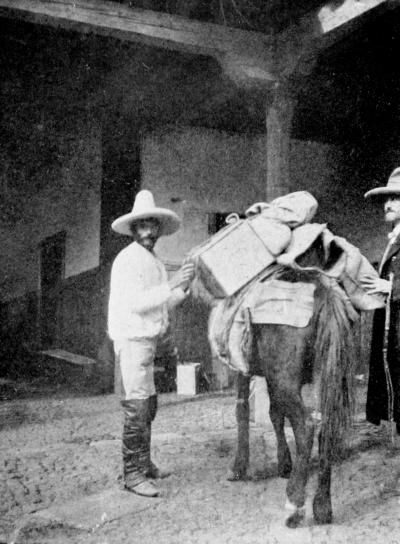
IZUS AND EL PADRE
Our coming being expected, arrangements had been made for our further journey to the South. Our mozo was awaiting us in the courtyard of the Fonda Diligencia with the four saddle-beasts and two pack animals, a black bronco and a stout white pack mule. We carried snug folding cots, which rolled up into compact bundles, and extra food against short rations, when we should reach the borders of Guerrero. We are provided with immense Mexican sombreros, of light woven straw, which cost us fifteen centavos apiece, the high, peaked crown and wide-reaching brim protecting head and neck completely from the sun.
We have with us heavy clothing and flannels for our journey along the highlands of the Tierra Fria and also the thinnest of linen and wool garments to save us from the scorching sun, when we descend into the hot levels of the Tierra Caliente. I have purchased a pair of immense Mexican spurs and my mule’s mouth is choked with a mass of wicked iron, calculated to break the jaw with little effort, should I pull hard enough on my rawhide bridle rein. A rawhide goad hangs upon one side of my saddle-pommel and my long barreled Colt’s revolver, loaded and ready for instant use, hangs on the other. We are all armed and our mozo has a formidable and ancient sword strapped along the left saddle-side beneath his leg.
We dined in the low-ceilinged eating hall of the Colonia, upon a well-served dinner of boiled rice, boiled chicken, yams and peppers, and cups of strong black coffee, drunk with sugar, but no milk. Our city clothes are left behind in a room, the rent of which we have paid a fortnight in advance, and the large iron key of which we take along.
Our foreign looks and ways attracted much attention in the town. A crowd gathered in the courtyard of the fonda to see us off. Our coming and our going were events. Nor was it altogether a simple matter to pack our equipment safely and balance it properly upon the beasts. But Izus was an expert, and with many yards of palmetto rope finally cinched fast the loads. At a word from him the pack animals trotted forth from the fonda’s court, he following behind, while we brought up the rear. “Adios, adios, señores,” shouted the crowd. “Adios, adios,” we replied.
Our animals knew the road perfectly. They had traveled it many a time before. We wound and twisted through narrow streets, we passed several wide plazas, and then turning up a street wider than the rest, began the ascent toward the hills which lie back of the city.
IX
A Journey Over Lofty Tablelands
Ario, Michoacan, Mexico,
November 26th.
As we wound higher and higher toward the summit of the hills, the town nestled below us half-hidden among umbrageous trees, and groves of orange and apricot and fig, while stretching beyond it, toward the northeast, lay the light green expanse of lovely Lake Patzcuaro. The panorama before me as I turned in my saddle to gaze upon it, presented a vista of wood and water, of fertile, cultivated, well populated country, delighting the eye on every hand. We were traversing a land enjoying one of the most salubrious climates of the world.
We had started about four o’clock in the afternoon, and before we had ridden many miles the shadows began to creep across the landscape, and then, sudden as the drop of a curtain, down fell the fullness of the night. This absence of twilight is always a perpetual surprise to me. I do not yet become used to this immediate extinction of the day. The sudden banishment of the sun did not cause me uneasiness, however, despite the frightful condition of the labyrinthine paths along which we threaded our way, for the moon was at its full. It shone with the splendor and potency which our altitude and tropical latitude assured. We were more than seven thousand feet above the sea and rising higher at every league. The thin, translucent atmosphere gave to the moon a wonderful quality of illumination. It shone white and radiant, with a brilliance which permitted the reading of a newspaper with ease. The landscape, the wide expanses of cultivated fields, the thousands of acres of corn and wheat and rolling grass land, the dense copses and thorny vine-woven thickets, the miles of maguey plantations, the orchards of apples, of apricots, of lemons and of limes, lay illuminated and distinct in the strange white light, revealed with almost the same vividness as in the day. Only the shadows were dark, were sharp and black and solid. For several miles we rode through forests of oaks and pines, our little caravan appearing and disappearing into the blackness of the shadow and then into the lightness of moonbeam, in perpetual hide and seek. We passed multitudes of pack beasts, in droves of a score or more, generally led by a bell-mare, and followed by two or three ’cherros in zerape and flapping sombrero, as well as many burros, these generally driven by Indians. Here and there, we came upon a blazing fire by the wayside, where were camping for the night the cargadores, roasting tortillas and boiling frijoles, or wrapped in their zerapes, their chins between their knees, asleep before the flickering embers.
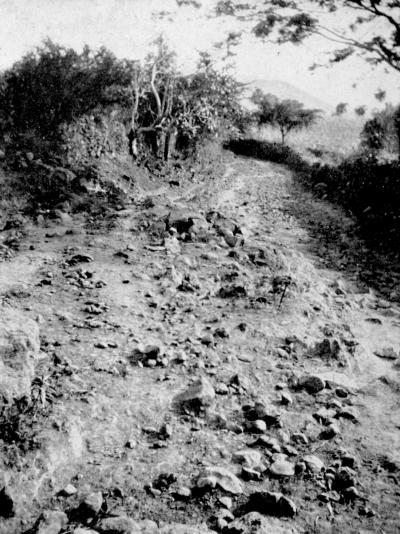
THE HIGHWAY TO THE PACIFIC
It was nine o’clock when the white walls of Santa Clara gleamed before us. We saw a long paved street, ending in a little plaza filled with great anciently-planted trees. Along the street were only high, bare, white, adoby walls, rarely the glimmer of a light shone through a small and high-up window. Midway along this street, we turned into a wide doorway and, passing through the low encircling building, entered a large stone-paved courtyard. The backs of thirty or forty pack mules, from the lowlands of the Pacific, were here being unloaded of cocoanuts, and salt and dried palm leaves for rope and mat-making. Drivers and stableboys were swearing melodiously in Spanish and Tarascon. There was everywhere great stir and nobody paid us the slightest heed. We halted and dismounted. Our mozo Izus, took charge of our animals. A swarthy, burly Mexican bade us put our personal belongings in a little room, where was also soon set our baggage. He then locked the door and gave us a big iron key as evidence of possession. In another house, further along the street, we found an old Indian dame who gave us boiled rice, peppers, and a dish of stewed chicken, setting before us cups of boiling hot water and a small earthen pitcher of black, strong essence of coffee. A couple of spoonfuls of this, put into the water, gave me a delightful cup of fragrant drink, and a lump of the brown native sugar sweetened it perfectly. This method of making coffee I commend. Every housewife in Mexico roasts, grinds and drips through little flannel bags her own coffee essence. She keeps it always on hand. There is always hot water simmering on the clay oven, and it is only a moment’s care to provide the traveler with as much of the fragrant, vivifying drink as he requires.
In another house, across the street, we were bedded for the night. A single, large, high-ceilinged room off a big, airy court was assigned to us. The iron bedsteads were narrow, each with one thin mattress and no springs, but there were home-woven blankets to roll ourselves in and in the morning basins of beaten copper were brought us to wash in, with water poured from graceful ewers of like metal; evidences of the survival yet of a native industry for which this region and town have been famous ever since the days of Tarascon dominion. I endeavored to buy these handsome copper utensils, but my hostess would take no price, although I really offered her a great sum in my eagerness to possess them. They were heirlooms, she said, and too precious for money to avail.
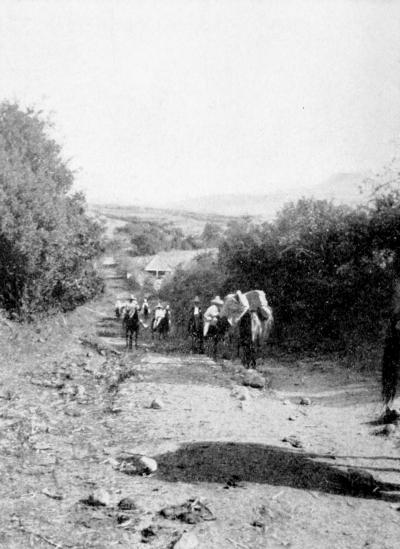
NEARING ARIO
The night was cold, almost frosty. On these high tablelands, a mile and a half above the sea, the radiation of the sun’s heat is rapid and, the year round, by morning the thermometer is usually close to thirty-nine degrees (Fahrenheit).
We were up betimes, out of the town, and among cultivated fields and orchards and pine and oak woods again, before the sun became at all oppressive.
As yet, I have not seen many birds in Mexico, only the waterfowl along the lakes and a few finches in the thickets along the way. To-day we have traveled in company with many ravens. Tame and companionable they are, so usual is the sight of mules and men along this frequented highway.
Santa Clara is close to the height of land. Seven thousand two hundred feet above the sea, my aneroid declared, and from that altitude we began to descend. The thirty miles to Ario is one steady decline, a gradual fall of twelve hundred feet.
This whole country hereabout is held in vast haciendas of thousands of acres, and is chiefly owned by nonresident landowners who rarely, if ever, visit their possessions, but trust entirely to overseers to manage and work them and wring an income from the hapless peon. It is a land of great fertility. Only the most primitive methods of agriculture are employed, and work is done in the most inefficient way. Yet huge incomes are withdrawn from the land, and spent by the distant haciendado in his city home in Mexico, or in Paris, or Madrid. These lands are said to be marketable (buyable) at about ten dollars (Mexican) per acre, say four dollars in United States money. As I have been riding along, viewing mile after mile of this superb fertility in a climate temperate all the year around, I have pondered much on what a garden it might have been, and it yet may be, if ever the thrifty American shall have it in possession.
Toward noon we began to gain a wider view of the landscape opening before us toward the south and west. Our altitude was steadily lessening and, many miles distant, seemingly, there was a sudden falling away of the land to profound and indefinite depths, whence came the impression of tropical verdure, the whole expanse backed on the horizon by blue and jagged lines of lofty mountain chains, peaks and summits which sometimes pierced the zenith, far to the southwest. They were the mighty Cordilleras of Guerrero, a hundred miles away and barring from view the Pacific Ocean just beyond. On a day wholly clear, it is said, the snow-capped cones of Colima may be seen, also, far to the northwest, but gaze as we might we could catch no glimpse of the mighty volcano.
Thousands of cattle are raised in Mexico, and we passed many extensive herds being driven toward Patzcuaro. They were urged on by vociferous vaqueros, swearing musically the immense and cumbrous Spanish oaths—yet have we seen almost no milch cows and the few we saw were those gathered in a corral hard by a wide thatched-roofed building, known as a “milk ranch,” an establishment where milk is gathered and shipped to nearby Ario, and butter and cheese are made for immediate sale. A cross upon the gable denoted it to be under the protection of the Virgin and I hope assured milk unadulterated to its patrons. From my saddle I caught a snap shot of the ranch and send you the pretty picture.
Our road now showed signs of being in better repair. Finally, the maze of intricate paths along which we had traveled, coalesced, and the ancient pavement now appeared intact. On either hand, tall wide-spreading ash trees arched over the perfect road, carven stone benches stood beneath them, and we found ourselves entering the important town of Ario. It is a place of more than five thousand inhabitants, the county seat of the District, the home of the Jefe Politico (the “political chief,” mayor, governor, boss and judge), through whose iron-handed rule the central government of Diaz maintains its firm control.
We passed an ancient church, turned to the right, entered a wide doorway and halted in a well-flagged court, in the center of which a fountain played amid many flowering plants and cages of gay-feathered birds. It was the hotel Morelos. We were at the end of our journey in the Highlands. We were come to the last town in the Tierra Fria. We were on the brink of the hot country, the Tierra Caliente, which lay stretched out beyond us, one short day’s ride and below us six thousand feet.
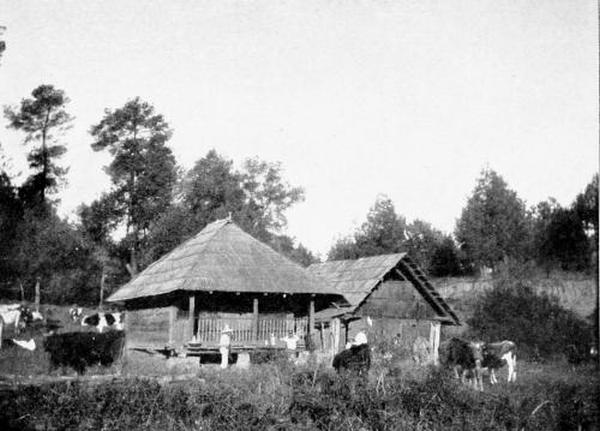
A MILK RANCH—NEAR ARIO
X
A Provincial Despot and His Residence
Cuyaco, Michoacan, Mexico,
November 28th.
Day before yesterday, I wrote to you from the curious and most ancient town of Ario, but did not tell you all I might, for lack of time. The city stands upon the verge of the highlands, the Tierra Fria. When the Spaniards founded it, several centuries ago, they placed it, with strategic judgment, at that point which would enable it to command the several trails which here descend to the lowland hot country and lead on to the Pacific. They placed it on a sloping hillside, as was their wont, the better to insure more perfect drainage, for, in those days, the sanitary engineers of old Spain knew better how to assure healthful cities than did the more barbarous English and the less civilized peoples of North Europe.
The streets of Ario, including every alleyway, are paved with sharp, flat stones, set on edge, wedged fast, the pavement running from wall to wall with a low stone gutter in the middle, into which open all the drains from the houses on either side. Along these central gutters are turned streams of ceaselessly flowing water, keeping the city constantly clean. This same sort of street paving and drainage prevails wherever possible in every Mexican city. To every town of consideration, water is carried, anciently, by substantial and often costly aqueducts; modernly, through pipe lines carefully laid. During the centuries of Spanish dominion these towns and cities have enjoyed a supply of water, pure, abundant and free to the poorest inhabitant. There are no water rates in Mexico. Water is regarded as one of the gifts of God to which every man and beast has an inalienable right. To charge for it, would be regarded as indecent and criminal. At the Rancho Tejemanil, I offered a boy a centavo for bringing me a cup of cold water. He refused to take the coin and let it drop upon the ground, rather than disgrace himself by so much as touching it. He turned away, the coin lying where it fell. I apologized to the master of the house for having done such a thing as offer money for a drink of water. He answered, saying, “Si, Si Señor!” “Water is indeed a gift of God, for which no man should be asked to pay.”
Although Ario is in the neighborhood of extensive forests of pine and oak, yet all the buildings are constructed of stone and cement, mortar and adoby sun-dried brick. Indeed, I have seen no wooden buildings in Mexico. Consequently, there pervades Mexican cities, towns and even villages an air of substantial solidity, quite lacking in American wooden towns.
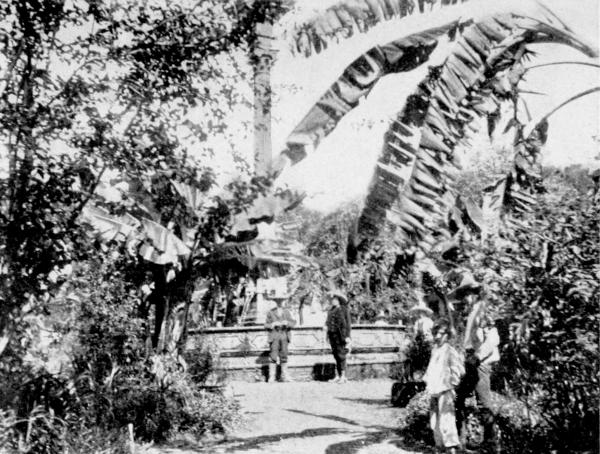
THE AUTHOR—PLAZA GRANDE—ARIO
We brought letters to the Jefe Politico, Señor Don Louis Salchaga, the despot of the county and governor of the iron hand. He was of large physique; tall, broad-shouldered, firmly knit, with strong, square chin and commanding eye. His hair was gray almost to whiteness; and a sweeping mustache, re-enforced the general impressiveness of his countenance. He was clad in a linen undress military uniform. He greeted us with courtly Spanish graciousness. He lives in a two-storied stone house at the intersection of two streets, one of which leads from the plaza. Entering through a narrow doorway, at the side, we found ourselves in a small, cement-paved room, whose stone walls perhaps, in years gone by, were white with lime. Don Louis sat at a table scrutinizing papers handed him by a dark-faced youth, who stood at his side. As we entered he hastily signed them, pushed them toward the clerk and rose to greet us. We learned afterwards what the documents were, one of them a decree settling a lawsuit, the
other an order that a prisoner be transferred from one jail to another some miles distant. Such an order is equivalent to a death warrant in this land of the iron hand. On the way, the prisoner is said to have “tried to escape.” Necessarily they have been forced to shoot him. He is buried where he falls.
Don Louis pressed us to dine with him that evening at seven o’clock, having first politely inquired of my Spanish-speaking friends whether “El Señor de Estados Unidos tiene dinero?” (Does the gentleman from the United States possess money?) My friends replied, “Si, Si, Señor, mucho dinero,” (“Yes, yes, sir, much money;”) so we were asked to dine! Probably, of all people upon this planet none are more expert in extracting the dinero from the American pocket than are the gracious Latins of the south. If you have money, the laws open wide their gates, and all government officials pat you on the back, meanwhile filching just a little from your unsuspecting pocket. Even the Padre and the Archbishop, for the proper toll of gold, will shove you through the quicker to the gates of Paradise.
At seven o’clock it was dark; the stars glowed big; the moon was not yet up. The city was ablaze with electric lights. On this second visit we did not go to the office door, but entered the wide-arched entrance for man and beast. We came into the usual square patio, where waters plashed and tropical plants, many of them in flower, were set about in pots. Don Louis greeted us as we entered. He shook hands twice all round. He led us across the court to the far side and into the dining room, a stone and cement-walled chamber with stone-flagged floor, wholly without adornments. No cloth covered the plain wooden table. There were wooden benches along the wall on either side. He introduced us to his wife, Doña Maria, and a little grandson of twelve years. The Doña was tall, for a Mexican woman, and stout. Her hair was white, parted in the middle and brushed smoothly back from her forehead. She wore a light muslin of white. She displayed no jewels, although undoubtedly possessing them. Don Louis wore an immense diamond on his left middle finger, while a heavy gold chain about his neck secured a big gold watch.
Our hostess could speak no English, but our host said he could read it and understood it “spoken very slow, a leetel;” “but the grandson,” he said, “had a tutor who was teaching him English,—a young man who had lived six months in Texas at San Antonio and there mastered the northern tongue!” The meal was simple. A very good soup, redolent of garlic and peppers, was followed with boiled rice and stewed chicken, a dulce, some really delicious preserved guavas, and cheese. Then cups of hot water and the small pot of coffee essence were set before us, and we “coffeed” the water to suit our taste. Just when I presumed we were at an end, a servant entered and set before each of us a soup plate of frijoles, with a big spoon. No Mexican considers a dinner properly concluded without frijoles. I had heard of frijoles. I had been told that tortillas and frijoles were the staff of Mexican life. Now the frijoles were before me. What were they? My plate contained nothing but large black beans floating in a thin soup. Perhaps the water should have been poured off, I do not know, but the beans floated and the liquor was thin. And Don Louis ladled them into his mouth with evident relish! Vivan frijoles!
Don Louis had resided in Ario three years. He came from the state of Toreon. How long would he remain in Ario? He did not know. Quien sabe? El Presidente Diaz sent him here and there, into such States and Districts as might be in need of a trusted lieutenant whose smile was beneficent, whose hand was proven steel.
In response to the letters we bore, Señor Don Louis gave us other letters to the chief men of the Distrito—a sort of circular blanket letter—and hinted that he would go part of the way with us next day, which, it came to pass he did.
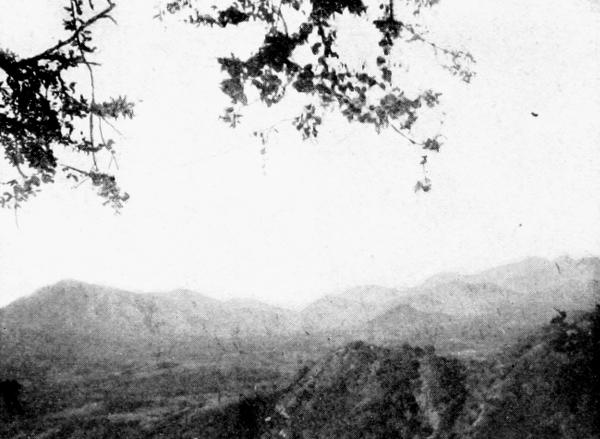
THE DISTANT CORDILLERA
Later in the evening, we also called upon Señor Don Juan Rodrigues Tarco, one of the leading citizens of Ario, a lawyer of distinction, and who gave us letters to the superintendent of the Mina El Puerto, at Churumuco, on the river Balsas. We met him at his house. Through an unpretentious doorway, which you might drive through, we came into a patio with many flowering plants and palms and a fountain. Near the entrance, on the left, we entered the reception room. This was a large high-ceilinged chamber with handsomely tiled floor, palmetto rugs, modern French furniture of cane, walls and ceiling frescoed in good taste. There were some good pictures on the walls, a new upright piano, and several mahogany book-cases, whose shelves were well filled with books, mostly in Spanish, a few in French and English. There were porcelain vases and handsome modern lamps. In any city, this would be regarded as a room of elegance, and to think that every luxury we looked upon had been carried more than fifty miles over frightful trails, upon the backs of men and mules!
El Señor was a small dark man, alert in his movements and quick of mind, a gentleman, having wide knowledge concerning the mineral wealth of Michoacan. He studied in the Universities at Morelia and Mexico City. He was a liberal in politics, and spoke with enthusiasm of modern Mexico, her mineral resources, the awakening of her industries, the growth of her commerce. He read French and English, but spoke only Spanish. His sons were away at school, in Toluca, and were learning English. It is the great desire of the young men of Mexico to learn to speak English, he said. The language is already taught in all the principal schools of Mexico. It is becoming the language of business and commerce. Before many years it will be the chief language of Mexico, and he regretted that he had not himself, while young, been able to master the difficulties of the tongue.
The ancient inn, the Hotel Morelos, where we put up, was built by the Spaniards more than two centuries ago. When we arrived we rode all our six mules and horses right through the big doorway into the interior paved court. Here we turned to the left and stopped at a flight of stone stairs, which went up to the second floor. All our baggage was carried up. A large square room was assigned to us. The walls and floor were of stone. Three narrow iron bedsteads were brought in, each having good woven wire springs, a thin mattress, a sheet, a blanket and a small pillow. Our baggage which the two pack mules had carried was piled in a corner. A table and three commodes, one next each bed, a basin and pitcher of enameled iron, and four chairs completed the furniture, all brought in after our arrival. Big double doors opened on the inner, tile-floored piazza, overlooking the patio, and casemented windows opened on the little balcony overlooking the street. On our left was another similar chamber, then round the corner, a dining room, then the kitchen, then another large room, the water-closet, with a dozen seats all in a row, used freely by both sexes and no lock to the door! A whole company might use it simultaneously. These places, in Mexico, are always close to the kitchen. I then understood the reason for constant yellow fever in less lofty altitudes.
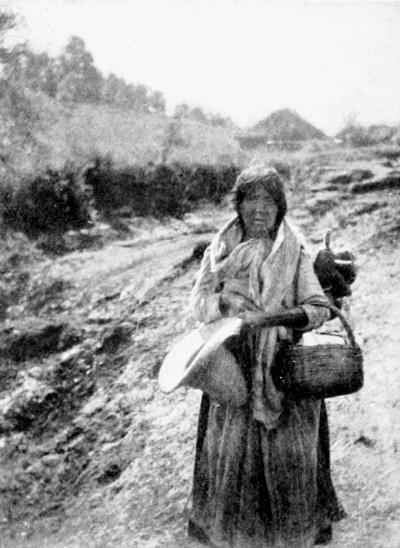
BEGGING A CENTAVO
In the town is a very old and large church with two towers and a great clock. Many women were kneeling along the dusty floor, saying their vespers, when we entered.
An artistic fountain (whose waters are said to be “Holy”) carved with lions’ heads, plays in the center of the plaza. From the plaza one can look over the lower town and far to the southwest, over and into La Tierra Caliente (the hot country) in which we now are. But Ario was cool, and at night I slept in flannel pajamas under two blankets.
We were early astir! and enjoyed an excellent breakfast of coffee, eggs, chicken, rice, tortillas—
in fact, I may remark that all meals I have thus far eaten off the beaten track of travel in Mexico, are quite as good as any I would get in the mountains of West Virginia. We had the two pack animals loaded, paid our bill, about forty cents each, (one dollar Mexican), mounted into our saddles and filed out of the patio into the street by seven-twenty o’clock. There we found El Jefe Politico superbly mounted, astride an elegant saddle with red trappings and tassels. He was accompanied by six cavalrymen on handsome black chargers, in white and blue uniforms, and a company of foot soldiers in white uniforms. With them was the prisoner, a tall dark man, his left hand in a sling and his right hand tied behind to the small of his back. All were lined up awaiting us, to be our escort till late in the day. So we left Ario with dignity and pomp. Whether the prisoner would reach the day’s end was an open question.
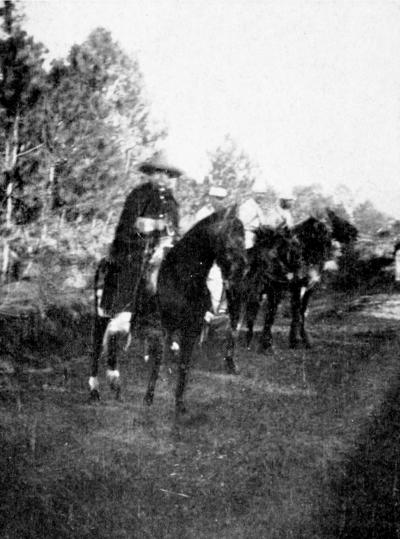
THE JEFE POLITICO AND SOLDIERS
XI
Inguran Mines—Five Thousand Six Hundred Feet Below Ario
Inguran Mines,
November 29th.
From Santa Clara to Ario we had descended one thousand two hundred feet in thirty miles. Now we were again going down. Each mile the country grew more tropical. A fine, rich, rolling land it was, a soil black and fertile; guavas, bananas, coffee, and other like trees began to be common along the road; long lines of monstrous century-plants (maguey), supplying an unfailing source of pulque, bordered the roadway on either hand, serving as impenetrable hedges. The camino (road) showed signs of having once been graded and on the slopes it had been paved from curb to curb. Now, as yesterday, all the road is gone, or nearly so. Chasm-like ruts, vast holes, diverse and many paths, give the traveler a varied choice.
Again we met hundreds of loaded horses, mules and burros and scores of men also, bearing crates and heavy burdens upon their backs. They were transporting cocoanuts, and sugar, and brown ocean salt, and palm leaves, and tropical products even from the distant Pacific shores, seven or eight days’ journey across the gigantic summits of the Cordilleras far to the southwest. Also, we met trains of pack mules loaded with bags of concentrated copper ore from the mines of this great mineral belt, wherein now I am.
I took many kodaks of these travelers as well as of passing incidents. The Jefe Politico stopped his whole “army,” or would have done so, if I had not waved him to come on, for the picture had been taken while he gave his order, “Instantemente,” greatly to his surprise.
By 11:00 A. M., we reached the Rancho Nuevo, and entered through the big white wall into an extensive courtyard. Here, were already several pack trains, some from the mines, one going on beyond the Balsas River into Guerrero. The journey is from dawn to midday. Then a halt is made, the packs are taken off, the animals cooled,—led slowly about by boys,—then later, the saddles and aparejos (Mexican substitute for pack-saddle) are taken off and, finally they are watered, and given “roughness” (the stripped dried leaves of maize) to munch, but are not fed with grain till night.
Nothing differentiates the Spanish-Indian civilization of the Mexican—mediæval and Roman as it is—from the twentieth century civilization of our own modern life, more than the attitude of the two peoples in regard to the suffering of dumb creatures. This I see everywhere and at all times. For example: The Spanish-Mexican knows no other bit to put upon his horse than a cruel combination of rough steel bars and pinching rings sufficient to break the jaw. No horse nor mule, nor burro, wearing this cruel device, will pretend to drink a drop of water, nor can he, until it is removed. When you would water your beast, you must dismount, take off the bridle and remove the harsh mass of iron from his mouth.
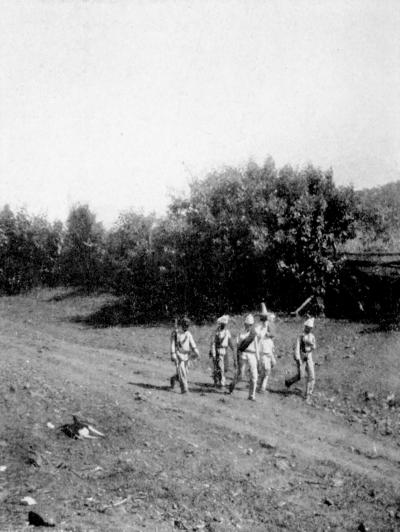
TRANSFERRING THE PRISONER
Pack-animals are rarely shod and are often driven until their hoofs are worn to the quick and their backs are raw and the flesh is chafed away even to the bone. When they can travel no further they are turned out to die or to get well as best they may, no one caring what may be their fate. Horsemen ride the ponderous leathern saddles of the country in the fierce heat of the Tierra Caliente as well as upon the highlands of the Tierra Fria. And no one would think, for a moment, of pausing in his journey for the mere reason that his horse’s back had become galled and sore, however grievous the wounds might be. The gigantic spurs with their big blunt points are perpetually rolled with pitiless insistence and an incessant jabbing heel motion along the animal’s bloody sides.
The same cruelty which we saw practiced in the bullring, where horses were ripped open, sewed up twice and thrice and ridden back into the arena to be ripped open just once more, amidst the plaudits of vociferating thousands, is equally apparent along this traveled highway where we constantly meet animals overloaded to their death, animals turned out to die, animals fallen beneath their loads and unable to rise.
At the Rancho Nuevo, the Spanish-Indian ladies of the kitchen promised us boiled chicken with our rice for the midday meal. One of the ladies, a stocky, swarthy Indian, with her agile son, started in hot chase after a long-legged active hen. The bird seemed to know its fate. Several short-haired dogs joining in the pursuit, the hen was captured. The mother brought it to me holding it up showing it to be fat and well-fed, and then, as she stood beside me, watching a caravan of pack animals on the moment just entering the courtyard, she calmly broke the thigh bone of each leg and the chief bone of each wing, so that escape became impossible, and proceeded right then and there to pick the chicken alive. She was evidently unconscious of any thought of cruelty. The legs and wings were broken in order that the bird might not run or fly away. It was picked alive as a matter of course. The sentiment of pity and tenderness for dumb things had never yet dawned upon her mind. The fowl destined for the pot, was as little considered as the wounded prisoner with his wrists tied tight to the neck and back, whom Don Louis’ soldiers that day were “transferring” to another jail.
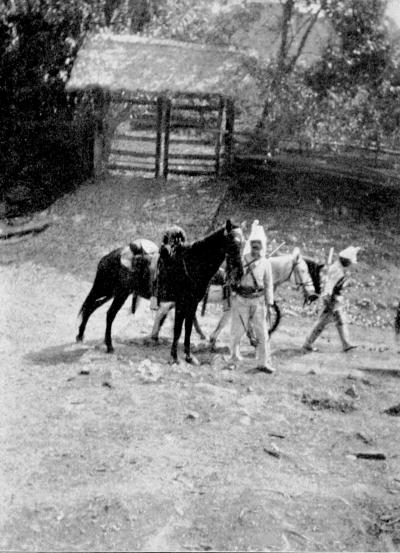
COOLING THE HORSES—RANCHO NUEVO
Our Jefe Politico had been joined by two Spanish (Mexican) gentlemen, managers (superintendentes) of haciendas and we all dined together. We had the hen cooked with rice and then frijoles, and I gave them of my precious old Bourbon, which—“La agua de los Estados Unidos”—they pronounced “mas excellentemente” than their own mescal.
Here we rested until about 3:00 P. M., when we got away for the final descent into La Tierra Caliente. We came down very gradually for about an hour and then found ourselves at Agua Sarpo, a collection of a few huts on the brink of the plateau, whence we looked out over an aggregation of mountain peaks and ridges, valleys and deep plains, much as though you stood at the “Hawk’s Nest” in West Virgina, and looked out for a hundred miles over a country five thousand feet below, all that distant region bathed in lurid heat, verdant and luxuriant with tropical vegetation.
The summits below me were volcanic and the flat cone of Mexico’s last created volcano, Jorullo, thrown up to a height of nearly two thousand feet in a single night, September 29, 1759, and so graphically described by Humboldt, stood at our very feet—the extraordinarily clear atmosphere making the volcano and neighboring peaks and ranges look as though crowded hard against each other, although they were many of them miles apart.
My first herald of the approaching tropics was a paraquita gorgeous in emerald and scarlet and gold, sitting on a stump watching me intently, and then I noticed a flock of parrots tumbling in the air.
The road, a mere trail, was as steep as some of those which lead down from our Kanawha mines. We let the Jefe and his soldiers follow us, we taking the lead. Down we went and down, and down, hour after hour. We passed palm trees, multitudes of bananas, and coffee trees. There were many Indian huts by the wayside,—for we were on a famous, much traveled thoroughfare,—and at most of them a bottle or gourd of pulque and fruit were set out to tempt the traveler to buy.
When almost down we came to the hacienda Tejemanil, a great sugar estate, with an ancient mill run by water conveyed many miles from the plateau. Here we rested half an hour, the Jefe transacted some business, and we ate delicious oranges, small, in color a light yellow, and bursting with slightly acid juice.
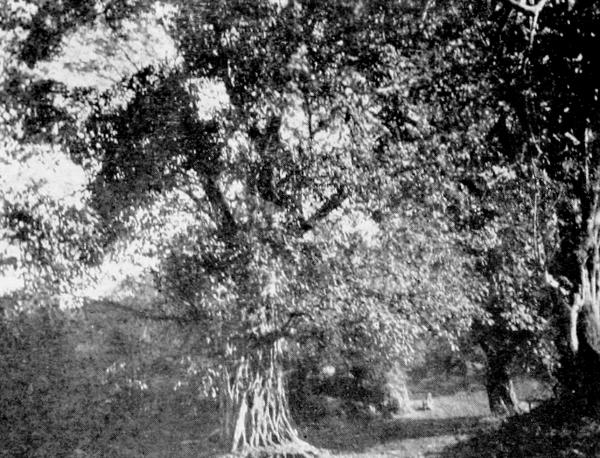
A WILD FIG TREE—LA PLAYA
We were now on a level of palm orchards, whence the dried palm leaves are shipped to the highlands in great bales. Then we came to another hacienda, a farm of a hundred thousand acres, La Playa, where the Jefe and his company with their doomed prisoner took the diverging road to La Huacana. Finally, we came to a broad valley, the valley of El Rio de la Playa, black with volcanic sand, called the mal pais (bad land), this being the immediate region once devastated by the terrible eruption of volcano Jorullo. Here were extensive banana groves, strange tropical trees quite new to me, orchids and palms and a stretch of several miles of indigo and watermelon cultivation. We then crossed another divide and came down again just as the big hot sun dove behind the mountains and precipitated the night. It was pitch dark when we entered the hacienda La Cuyaco and dismounted, four thousand eight hundred feet below Ario, six thousand feet below Santa Clara and yet some one thousand two hundred feet above the sea.
This night we slept on rawhide springs, a piece
of matting for a mattress. We were in the tropics. I was forbid to touch water, even to wash. Our supper was chocolate, (delicious), tortillas and eggs. Parrots and two large gray doves and a gold finch hung in cages in the patio where we ate. All were new to me. A baby swung in a cradle suspended from the ceiling and the father, Izus, the keeper of the courtyard, held another. He had thirteen children.
We took off our thick clothes—(it had been difficult to endure them all the afternoon)—I put on a gauze underwear and linen, and slept without the burden of a blanket. In the morning we set out early, but the sun was fiercely hot by nine o’clock. For some fifteen miles we now traversed a wide valley. We were away from the neighborhood of Jorullo and its scattered volcanic sands, and had entered the mineral belt. A ledge bearing copper and silver ran through the courtyard of the hacienda. I tripped against it when going to supper.
And thereby hangs a tale: Not long ago, it seems, an itinerant American—one of those casual countrymen of mine who now and then retreat to Mexico, when the law at home gives too hot chase—dropped in at the hacienda toward the close of a hot day and asked for lodging. He was hospitably received, as is the custom, and when the great bell clanged for supper, he left his sleeping room and made his way across the courtyard.
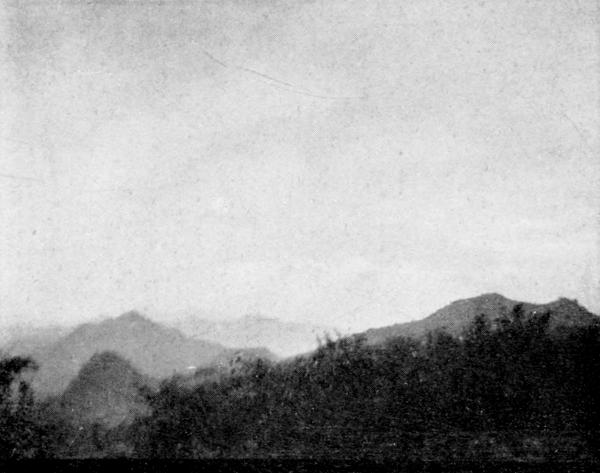
VOLCANO DE JORULLO
Walking carelessly, he stubbed his toe against the unruly ledge and limping into the dining room, his host apologized for the presence of so ill located a ledge of obtruding rock. The guest declared his hurt a trifling matter, and the incident was forgotten. The next morning, he was seen knocking the ledge with a hammer and he put samples of the rock in his pocket before he went away.
Many months passed by and all memory of the casual American had vanished from men’s minds. Recently, however, an officer connected with the Department de Mineria of the Mexican Government, dined at the hacienda and politely informed the superintendente, that an American had “denounced” (i. e. filed claim to) the ledge of mineral running through the courtyard, and had received title thereto along with the right to occupy as much of the adjacent surface as might be necessary to work the mine.
Thus are the proprietors of the hacienda most uneasy at the approach of any gringo (contemptuous term for American) lest the newcomer turn out to be their casual guest or his representative.
After leaving Cuyaco, we met constant indications of minerals along the road. I also noted
flocks of parrots, multitudes of jays, flycatchers, brown and black vultures and many Caracara eagles, all of these birds being new to me; and I saw also several fine butterflies, Papilios and Colias, small white and orange and yellow ones. But nowhere did I see any wild flowers—the season was now too hot for these.
Toward ten o’clock, we stopped at an hacienda, that of San Pedro de Castrejon, where the Castrejon brothers live, owners of copper properties near those we go to see. They are the grand señores of the Valley; they also gave us letters of introduction. Black birds, big boat-tailed grakles, grey and white jays, and scores of wild doves were here walking tamely among our horses. Swarms of parrots were clamoring in the trees. For a few centavos, we here bought delicious bananas, small finger size, and others three times as big, and oranges and cocoanuts.
By eleven o’clock we began to see the steam from the power house of the Inguran mines and were soon there. They are ancient copper mines, now being opened by the French Rothschilds, over four million francs having been thus far spent. Extensive copper deposits are here exposed. The managers are all Americans; one is from Virginia, one from California. There is not a Frenchman employed.
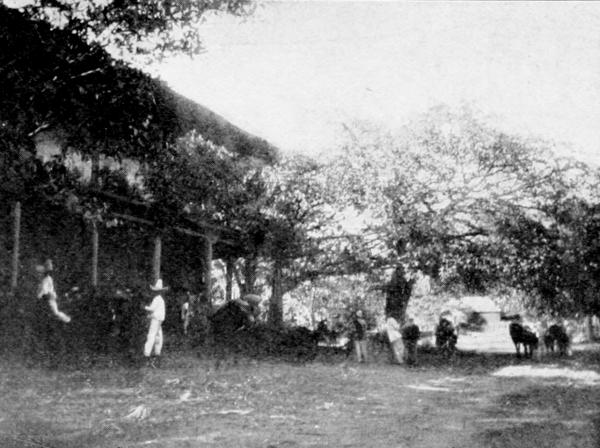
RANCHO DE SAN PEDRO
We are installed in the private bungalow of the general manager, of Mexico City, from whom we brought a letter of introduction. We are half way up the foothills; we have a superb view, the beds are comfortable and the fare is good.
This morning we have gone through the mines. Fuel and transportation are here the two problems. This whole region of several hundred miles square is rich in copper and silver, is full of ancient mines, once worked by Indian slaves but now abandoned, since Spanish expulsion and the dawn of liberty.
XII
Antique Methods of Mining
Mina la Noria, Michoacan, Mexico,
December 4th.
We left the mines of Inguran early Saturday morning. We were up at four-thirty, and by five-thirty had packed and breakfasted, desayuno, and almuerzo combined. The traveling Mexican eats early and, while he may take a midday snack, it rarely rises to the dignity of the comida, and when the day’s journey is over, like the two morning meals, the comida and cena, are united into one. Our breakfast consisted of fried chicken and rice—rice so delicately fried that each grain was encased in a crisp and dainty shell, and each mouthful cracked with relish between your teeth. Eggs are always to be had. In Spain and Cuba an egg is called huevo, in Mexico the refinement of language substitutes the word blanquillo (little whitey). It is a courtesy to ask your hostess for blanquillos. It would be ill-bred to ask her for huevos. It is also a courtesy, to say, when you address her, señorita. If she protests she is a señora, mother of a family and long past the age of a señorita, you exclaim “it is impossible,” for since she looks so young, she must be a señorita. The blunt American manner which calls an egg a huevo, and a dame a señora, is regarded as unpardonably rude.
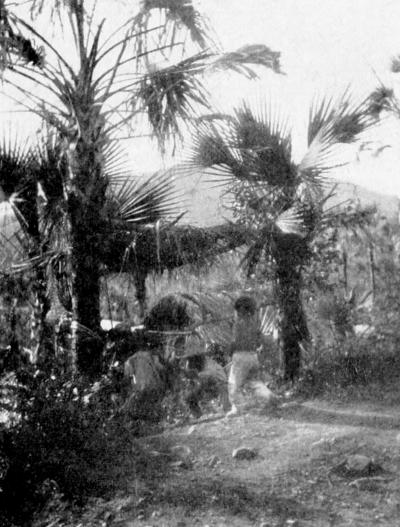
IN FLIGHT FROM MY KODAK
By 5:45 we were climbing down the three hundred feet of mountain side, through the mining village, over an ancient paved roadway about four feet wide, the paving stones set in so firmly between the curbs that the floods and wear of the centuries and seasons have left it as intact and solid as when first laid. The Spaniards built many such roadways to their mines, when they worked the Indians as slaves, centuries ago. The mining village was picturesque. The miner, when he goes to work, builds his own house and pays no rent. The walls are upright poles and the roof is a palm leaf thatch. When he quits his job he abandons his house, although he sometimes carries away the roof. Near each dwelling is built a sort of Dutch oven of clay, making an oven and stove combined. In it the bread is baked; upon it most of the cooking is carried on. Housekeeping is a simple process in this tropical land.
The mines of Inguran are situated at an altitude of about two thousand feet above the sea, and the dry air, not too light nor too heavy, seems to agree perfectly with the Americans there at work, and restored me to a vigor which the thin air of the highlands had partly relaxed. We were entertained, of an evening, at the delightful bungalow of the superintendent of the inside work, a Mr. O’Mahondra, a member of the distinguished family of that name of Richmond, Virginia. Originally he began the practice of law in Chicago, when, his wife being threatened with consumption, he fled with her to El Paso. There she gained nothing and he carried her further south and, abandoning the law, took this post at Inguran. She was tall, fine looking and the picture of robust health. A clever American woman, she had acquired the art of assaying and, as official assayer of the mines, received a handsome salary. “The only drawback to living in Inguran,” she said, “is that I am so delightfully healthy.”
Our way lay down and then across the San Pedro valley toward the southwest. The valley is a mile or two wide. The trail we followed ran through dense tropical foliage. The air in the early morning was cool almost to coldness. The birds were everywhere astir and all their notes were new to me. There were many doves, the little brown ground dove that merely stepped out of our way; a bigger dove, slate gray in color, which flew among the higher branches of the thickets. The large gray jay was numerous and there were many magpies and rusty and yellow-headed grakles. Along the watercourses we again came constantly upon bands of the big brown and small black vultures, as well as Caracara eagles which were fishing in the stream. Parakeets, resplendent in green and scarlet and gold, were abundant, and flocks of gray and green parrots tumbled clumsily in the air. I saw also my first big green Military macaws,—birds as large as chickens or small turkeys, the body a brilliant green, the head capped with red and yellow. I have never seen these splendid birds in captivity, nor among those brilliant macaws from the Amazon and from Australia which are so often exhibited in collections. These macaws were very tame, and a flock of them settled upon a mimosa tree under which we drew rein. I might have shot them with my pistol, and should have brought some of them home with me, if I had had any way to preserve the skins. In the thickets I also noticed flycatchers and several sparrows I did not know, but I saw no ravens as I did the other day upon the highlands.
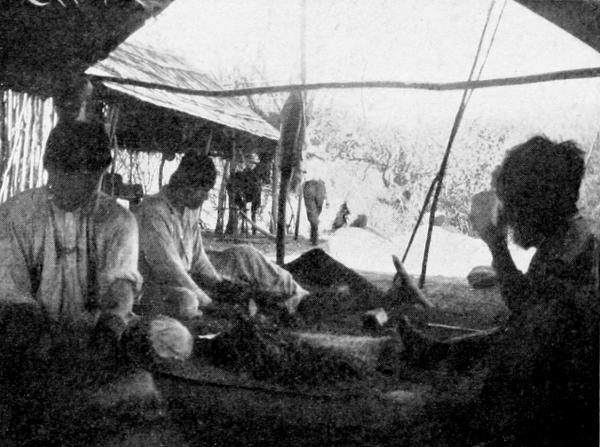
THE ANCIENT STAMP MILL
After five or ten miles down the valley, winding through the forest, crossing open clearings, passing here and there a native hut, frequently fording the river, we left the main trail and turned
up a shaded ravine, following it to its head, where we passed through a low gap with high mountains on either hand, and then descended toward the river again, thus cutting off a great bend and saving fifteen or twenty miles. As we came down toward the main valley, the timber grew smaller, the persistent mesquit more and more possessed the land, and the sun fell full upon us. The heat was intense. No living thing now seemed anywhere to exist; only the multitudes of little brown lizards, countless thousands of them scurrying on the sand; and iguanas, black as night, sleeping in the crotch of a tree, or on the heated top of a stone near the wayside. Nor did any sound now stir the midday silence except the hum of millions of cicadas, which the fierce sun rays seem only to nurse into active life.
Six hours in the forepart of the day brought us to the Hacienda de Oropeo, on the borders of the Rio de San Pedro. Here we halted for the noontime rest, lying-by beneath an Indian shelter, a wide-thatched roof of palm leaves, under which we could tie our horses, and where we might ourselves repose. Here an old Indian woman cooked for us tortillas and frijoles. We watched her make the tortillas, little cakes of corn meal as thin as sheets of paper. The dry kernels of the corn are first soaked in lime water until the enveloping shell readily comes off. It is then much like samp. The swelled and softened grain is then rubbed to a pulp between two stones, the moistened pulp is patted between the hands to the thinnest sort of a wafer, and these thin wafers are laid upon the top of the clay oven to be slowly dried. The tortilla is said to be the most nutritious of all foods prepared from maize. It is the staff of life of the Mexican peon, and the making of tortillas is the chief vocation in life of his wife and daughters. As soon as the little girls are big enough they begin to pat tortillas, and they continue to pat tortillas throughout their lives. If you travel through an Indian village your ear will be struck by the pat, pat, pat, of hundreds of pairs of hands. The Indian women are patting tortillas. They are always patting tortillas, when not specially occupied in other toils.
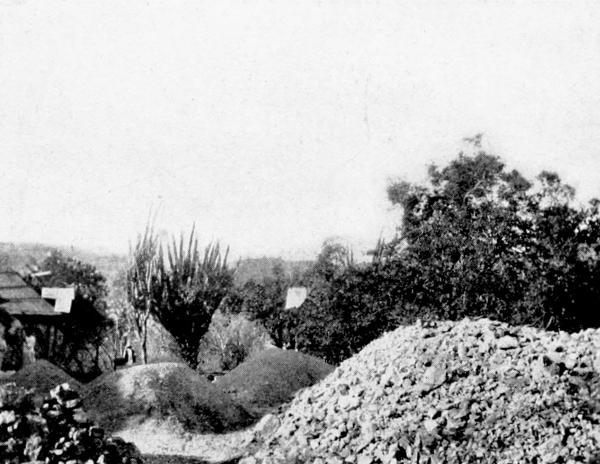
COPPER ORE DUMPS—LA CHINA MINES
Toward 4:00 P. M. Izus, our mozo, repacked the loads, again we mounted, and in an hour were across the river, where we ascended a small creek a couple of miles to these ancient mines. It was while resting at noontime, that we noticed a group of thirty or forty men bearing on their shoulders the palm-thatched roof of a moving mansion. Later, we rode past the new domicile, the roof was already set upon the corner posts, and the family were already moved into their habitation.
We are bivouacked in a building where once lived the lord of the mines,—mines now filled with water and abandoned, although none of the workings go down more than one hundred feet. The building is chiefly constructed, both the floor and walls, of sun-baked clay. High above the walls rests the palm-thatched roof. There are no frames in the window openings, no frames in the doorways. Walls and roof being only a protection from the sun heat, the air may blow through where it listeth. Our cots are taken from the back of “Old Blacky,” unrolled and set in the breezy chamber; upon them we sit and sleep.
Our only terrors are the ants, but we set the legs of the cots in little earthenware pans of water and are safe. An Indian family, living in the distant end of the rambling, abandoned buildings across the courtyard, provides us with boiled rice and stewed chicken. Izus has brought us an abundance of bananas and oranges, fresh, fragrant, and luscious. We buy several oranges for a centavo, and a centavo is worth less than half an American cent. The Indian keeps poultry and also gamecocks. These latter are tied by the leg near his door. They are his pride, and he fights them on Sunday after church. When the priest has closed the services the neighbors, who have all brought their chickens, form in a circle, and there the week’s wages are staked and lost upon the issue of the fights. I send you a snap shot of a battle.
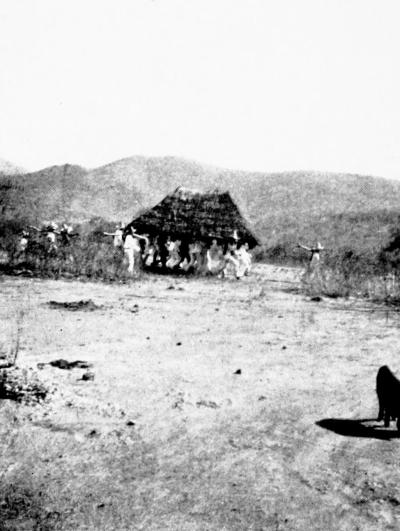
MOVING A MANSION
When dining, we sit on improvised stools around a homemade table and just back of us crouch a group of attentive admirers—the famished family dogs, rough-haired, cadaverous, wolf-eyed, silent dogs they are. They watch with furtive intentness each morsel we put into our mouths, they instantly pounce upon each crumb and bone which falls within their reach. They never bark—only a shrill melancholy howl I sometimes hear breaking the stillness of the night; they never wag their tails, for these are always tucked between their legs. When we have finished, we toss to these wistful watchers the refuse of our meal. There is a silent scuffle, a hasty crunching and then each dog sits up as hungry and observant as before. Thus our friends breakfast and dine and sup with us, and so filled with suspicion and fear of man are they, that they never by any chance allow us to approach. “Veni aqui perro” (come here, dog) an Indian boy calls out, and immediately perro slinks out of sight. Descended originally from the wild coyote, which they much resemble, these dogs seem to have acquired little taming by contact with man.
Next up the creek above us lie the Azteca mines, long since abandoned, and then come the China (pronounced cheena) mines, the only group now being worked, the present superintendente being a member of the Castrejon family to whom they belong. The vein is a porphyry-and-quartz carrying copper, and is about three hundred feet wide and almost vertical. It is nearly with the watercourse, about one degree to the west, and how deep it may go no one knows. This whole region is full of holes, generally, say, four feet to six feet square, from which for centuries the copper ore has been taken. The rich pieces were carried away and the balance was thrown upon the ground. The entire country is filled with innumerable piles of this abandoned copper ore carrying two and three per cent of copper, and waiting for that distant day when railroads, modern machinery and efficient labor shall make this natural wealth profitable to modern enterprise. As it is, the present primitive Indian methods of mining and transportation on mules, unventilated pits, and awful trails climbing stupendous heights, destroy the possibility of profit even in working the richest ores.
Sunday we spent in riding over the hills which rise from three to five hundred feet above the stream. Up their easy, rounded slopes a horse can clamber almost anywhere. It is a country where cattle roam and where the Mexican vaqueros (cowboys) are the only human beings. In the afternoon, we went down to the San Pedro River, now a small stream, and bathed in the tepid water, where I surprised an old familiar friend, also watching the limpid water, a Belted Kingfisher.
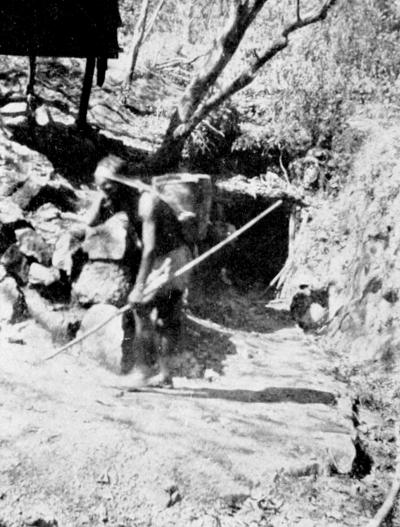
BRINGING OUT THE ORE LA CHINA MINES
Monday, we spent from seven o’clock to ten, going through the China mines, which are worked by the Mexicans in the old primitive way. We went into the side of the hill by a short tunnel, which led to a black hole up out of which stuck a slippery pole. On one side of this pole notches are cut, and into these notches, if you want to descend, you must sidewise set your feet. Our guide clasped the pole with one arm, holding aloft his flickering light with the other, and slowly sank from sight into the blackness below. We all went down, not knowing what might be beneath us. At first, my feet would not hold in the notches, but it was a matter of setting in my feet or falling into unlimited darkness, so I clung tight and came slowly down. The distance was only about twenty feet. Here there was an off-set of eight or ten feet, and then another pole and more notches, blackness above as well as below, and the notches had grown slick through years of contact with shoeless Indian feet. Thus we went down and down, descending some two hundred feet to where the air lay hot and heavy and our breathing became stertorous and slow. We then followed a long narrow tunnel, and came to where naked Indians with steel wedges were sledging out the ore. The Indians descend in the morning, they work as long as the foul air permits, then they gather up all the rock they have dislodged, put it into a bull hide sack, load this on their backs and climb up the notched poles again to daylight. On issuing from the mines they stagger to an ore pile, under a thatched roof set on high poles, and dump their loads. Around this pile of ore squat twenty or thirty Indians, each holding a stone in his hand. Each has before him a large flat piece of rock. He reaches for the ore pile, takes from it a lump which looks fairly good and cracks it to powder between the two stones. The mean ore is thrown on a dump pile, the rich ore is all cracked up. This is the original of the modern stamp mill, and it is the only stamp mill the Indian-Mexican will probably ever know. The ore, after it is pulverized in this way by hand, is put into a wooden trough into which water is poured which has been carried up in bull hide sacks from the stream below, and the ore is thus washed and concentrated. It is afterwards put into sacks, about two hundred pounds to the sack, and taken fifty or sixty miles, over the frightful precipitous trails, to the railroad at Patzcuaro, whence it is shipped to the smelter.
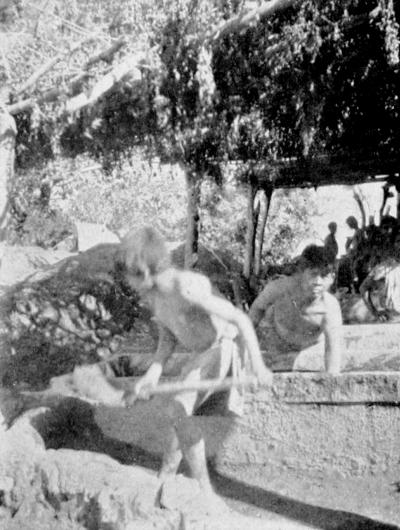
WASHING COPPER ORE
It is a wonder that even the Mexicans can thus work these mines, year after year, and make the smallest profit. The most efficient American manager would find this to be impossible. The Mexican superintendente lives on nothing and his Mexican employes live on less. Eighteen to twenty cents a day Mexican (less than ten cents a day in American) is the miner’s pay. On this amount he must support himself and often a large family. The Mexicans follow the old Spanish theory, that human labor is cheaper than machinery, if you can crush down the human labor to a sufficiently low wage. Hence, the Mexican employing classes discourage both the use of machinery and the education of the peon. Ignorance and the abject poverty of the working class is the Spanish-American ideal. The day laborer in Mexico is little better than a slave. The wealthy mine owner, who lives in luxury in the distant Capital, or in Paris, or Madrid, may exhibit the evidences of culture and refinement, but Mexico can never greatly advance until the masses of the common people shall be enlightened and by modern statesmanship be lifted from this condition of industrial servitude.
Some of the types among these Indians are curious. One man has a head that runs up straight behind his ears, nor has he much brain in front. Another looks like a Japanese. These Indians—they are called Indians, but are many of them half-breeds, for there is much Spanish blood mixed in among them—are pitifully poor and are hopeless in their poverty. They have been hammered and battered for so many centuries by the merciless Spanish overlord, that they have had all spirit long ago knocked out of them. They seem to be unable now to rise. Nor are they a hardy race. When sickness prevails they are too poor to employ a doctor, but rely upon charms and religious rites. I have just acted the part of a physician. I have brought with me a small box of selected medicines sufficient for the common ailments of this land of semitropics. I am now prescribing quinine for Doña Caldina, calomel for Señor Perez. I hear that a crippled man is coming to-morrow to see me and ask whether the white señor can cure him and make him walk. There is a certain childlike quality about these peones. How humbly they accept the superiority of the white man, whom they do not love!
I see many instances of what might be called degenerates, misshapen heads, ill-shaped and deformed bodies, signs of a race too much inbred. They wear white cotton clothes, peaked straw hats and rawhide sandals. The men generally carry blankets (zerapes) folded across the shoulder which they wrap up in, as do their brothers on the highlands, when the air grows cold.
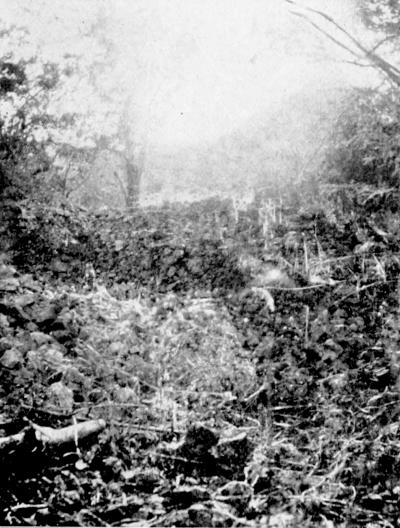
AN ANCIENT DUMP OF COPPER ORE
The coldness of the nights and the burning heat of the day are strange. I slept last night in flannel underwear, a woolen jersey over that and flannel pajamas still outside; then two thick wool blankets and a rubber poncho over all. Early, toward one or two o’clock I woke up chilled to the bone. I put on my corduroy coat. I was just warm, for an icy wind was blowing down from the lofty altitudes of the Tierra Fria. This morning when the sun rose about six o’clock, the air was still cold. In an hour it was pleasantly warm, birds were singing and flying from tree to tree. By nine o’clock the sun blazed like a ball of fire. I am now, at half past nine, going about in slippers, in linen trousers and my thin pajama coat, and even then I hide from the sun. By ten o’clock a silence lies upon the land profound and overwhelming, not a living thing is astir, except only the lizards and the cicadas. The daylight ends precipitately. The day lasts only as long as the sun is up. By half past five the sun hangs above the mountains on the west. Suddenly it is gone. In fifteen minutes it is dark, the stars are out, and such white stars they are! The cold air of the highlands then settles down upon us for the night.
XIII
Some Tropical Financial Morality
Churumuco, Mina el Puerto, On the Rio de las Balsas,
December 6th.
We were up before the day, our horses and mules having been fed with grain a little after midnight. Thus the food is digested before the journey of the day is begun. It was dazzling starlight with a gleaming streak of white moon. Our two pack beasts had been loaded, we had breakfasted and were in the saddles a little after four. A keen wind which cut like a knife-edge blew steadily down from the highlands behind us. I had kept on my warm clothes of the night. We traveled rapidly by the brilliant starlight and passing down the aroyo along which we camped, turned down the San Pedro River toward the south. We crossed the stream frequently, traveling in single file. By seven o’clock the sun was peering over the hills and I began to shed my clothes. By half past eight I retained only my thinnest underwear, my pajama coat, my linen trousers and slippers. By ten o’clock the sun was scorching, our great Mexican sombreros alone saving us from its fierce rays. Our way lay for twenty miles almost due south down the valley of the San Pedro, then turning to our left, we followed a slightly-traveled trail, crossing a succession of low hills, until after four long hours we came to immense plains or llanos stretching flat as a table for twenty miles toward the Balsas River. The streams were dry, the leaves were falling from shrubs and trees. It was the dry season. Mesquit and cactus and mimosa were the only vegetation, except the blistered stalks of the sun-dried grasses. No water was visible anywhere. The ground was parched and cracked. A light breeze which followed us all day and a few highflying clouds, which now and then hid the sun, alone saved us from being almost broiled alive. The watch in my pocket became burning hot, I could scarcely hold it in my hand; the metal buttons on my clothes almost burned themselves loose; only the dryness of the atmosphere made it possible to have made this journey during the day.
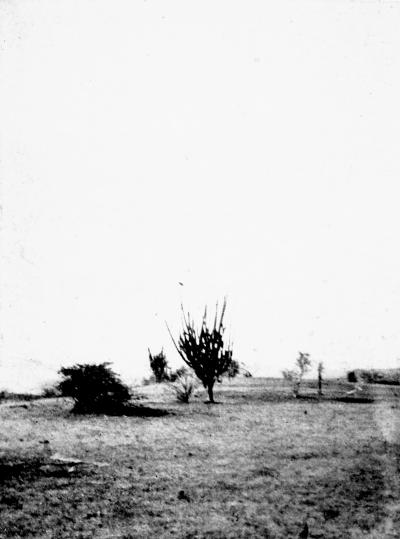
THE LLANOS. HAWK POISED UPON AN ORGAN CACTUS
The great llanos, stretching south and southwest, were crossed by many well-beaten trails, where the horses and cattle, which roam here in thousands, have worn the paths they take to reach the distant water. It is said that these animals,
which wander at large, have schooled themselves to cross the wide plains beneath the stars in the cool of the night.
We reached the mines of El Puerto about half past one o’clock, crossing the plain for several hours toward the mountain on whose side the mines are perched. The only living things we met upon these llanos were the jack rabbits and an occasional roadrunner, which birds were very tame. Although his rabbitship has attained a reputation for lightning leg-velocity upon the sagebrush plains of our own far-west, yet surely his Mexican cousin has him outclassed. A vaquero, followed by a couple of lean and seasoned hounds, had met us on the borders of the llanos and kept with us almost across the plain. The dogs, despite the fact that they must well have known the power of the jack rabbit, would often come upon one crouched in the grass, and so nearly within their reach that they quite forgot their lessons of the past, and started full cry upon his trail. It was almost laughable to see the hounds’ despair, so quickly did the rabbits shoot out of sight, quite beyond all dog power to keep the pace. The pair would regularly return with their tails between their legs, the picture of disorganized defeat.
We have climbed three hundred feet up the side of the mountain to a group of open sheds, thatched with palm leaves, while above us volcanic rock masses tower more than two thousand feet. Across the river Balsas, apparently rising from the water’s edge, are the tremendous heights of the Cordillera, lifting themselves twelve to thirteen thousand feet above the level of the sea.
The Mina el Puerto is an ancient mine, now nearly exhausted; for it has been worked almost two hundred years, all through a single doorway cut into the rock, barred by a great wooden door, fastened by a ponderous lock with a ponderous iron key. Each morning, for many decades, the owner has taken the key from his belt, unlocked the big door and sent fifteen to twenty naked Indians down the “chicken ladders” four hundred feet into the hot mines below. There is no ventilation, there are no pumps, there is no other way to go in or out. Two or three hours is the longest time a man can work at the bottom of this hole; when the Indian can stand it no longer he climbs up bringing on his back the ore which he has been able to dislodge, or a bag of water, if any shall have leaked in. By three or four o’clock in the afternoon, those who went down have all come out again. The ore they have dug is thrown upon a pile beneath the palm-thatched roof; the owner of the mines then locks the door. When the ore pile has been reduced to powder by the hammering of many dusky hands, it is concentrated in the wooden troughs, washed with water from the river Balsas, three miles away, brought up in bullskin sacks upon the backs of mules; and when a sufficient number of two-hundred-pound bags of concentrated ore have been accumulated, forty or fifty mules are tied together neck to tail, loaded with the bags and driven almost one hundred miles up to the plateau. These ores have always been particularly rich, the gold and silver in them having been sufficient to pay the cost of transportation to and charges of the smelter, leaving the copper for net profit.
The Mexican owners have lived well from the fortune of their mines. In fact, to them copper ore in the ground has been equivalent of cash in the bank. When they have wanted money they have dug into their ore bed. They generally smelted it themselves in crude clay furnaces, using charcoal burned near at hand. What of gold and silver there might be was also run into the copper bars and the bars were currency. A pile of bars meant rollicking jaunts and roystering junkets. The family and friends, the servants and retainers were gathered together, muskets and swords, horns and mandolins were assembled, horses and pack animals were loaded and bestridden, and a tour of the surrounding countryside was made. Bullfights, cockfights, balls and fandangoes were gloriously enjoyed, duels were fought, hearts were stormed and the copper ingots were blown in even to the last ounce. Then the company would return, the fast-locked door would again be opened and a new supply of copper extracted from the mine. Like princes lived these Señores de las Minas, so long as the earth yielded up her hidden treasure.
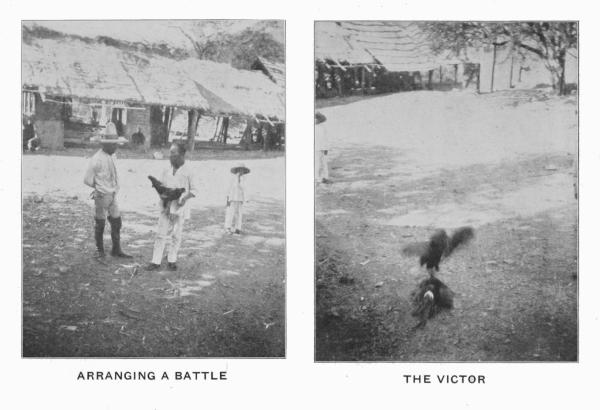
ARRANGING A BATTLE & THE VICTOR
At this particular mine, this sort of thing has been going on for a hundred years. Generations have come and gone and come again, and the ore has not yet given out. But the thrifty ancestors so managed it as to pay only the smallest taxes to the government. Why should they pay good money into the itching palm of the distant despots, who might for the moment hold supreme power in the far-off capital! The first owner had “denounced,” (i. e. taken up), only half an acre. In the middle of this he cut the doorway to the mine. His descendants have always paid taxes on that half acre! The government never asked for more. Even Diaz was content. So the workings went on, and spread and ramified into the many acres surrounding the single so well-guarded entrance. The original half-acre had long years ago been mined out. And no one ever entered the mine or knew of its depth or latitude except the owner, who took the
big key from his belt each workday morning and opened the ponderous wooden door. The Indians dug and sweated and smothered in the hot depths, even as their forbears had done. The Castrejon family held fast to the big key and enjoyed their credit for unbounded riches. La Mina el Puerto was a busy place, and its hospitality was equal to its wealth.
Thus it might have continued to this day, but for an accident which happened two or three years ago. One stormy night two travelers sought shelter beneath the Castrejon thatch. In crossing the llanos they lost their way and their horse cast his shoe. They discerned the light on the mountain side and came to it. The courteous lord of the mine gave them true Spanish welcome. “All that he had was theirs!” They slept in his biggest hammocks and ate his fattest poios (chickens). The strangers were gringos (Americans) and “missionaries” and one spoke excellent Spanish and the other smiled. El Señor told them how many years he had worked the mine, he and his ancestors, and he boasted, just a little, of its wealth. In the morning, rested, fed and smiling, they bade their gracious host a parting adios as they followed his superintendente, who rode with them to the main road from which they had strayed. The mine as usual worked on. The incident was forgotten. A few months later, one sultry evening, the gringos returned and with them a mining inspector of the Mexican government and a company of rurales. The Fomento (Department of the Interior) had granted to them all of the mineral rights surrounding and outside of the half acre which contained the big door. Los Señores de Castrejon had never had legal title to any mineral, but what lay under that half acre. If ore had been taken from outside of that half acre, it had been stolen from the government and dire are the penalties for theft in this land of the iron hand. And what ore had been taken from the outside of that half acre now belonged to the two strangers. They might sue in the courts and recover the full value of it and all legal costs. The two Americans were very courteous as they explained these matters to El Señor. The mining inspector was there to examine the mine and the rurales held in their hands repeating rifles of the latest pattern. El Señor was a discreet man. He accepted the courteous offer of the smiling Americans that they would not prosecute, provided he made them a deed for all claim he had to the half acre, the big door and whatever else he might possess. He was pleased to sign the deed. He then mounted his horse—they gave him back his horse—and rode away a beggar. Next morning the Americans put the big key in the door, unlocked it and sent the Indians down to their daily toil. The mining inspector received liberal recompense for his trouble and rode contentedly back to the Tierra Fria. The rurales were induced to remain yet a little while, as a sort of protection against unforeseen mishap.
The new owners remained long enough to place a new native superintendente in charge at increased salary, and then accompanied the rurales upon their return. But los Americanos were themselves gentlemen who had had to leave the States in rather hasty flight, and soon fell into feud among themselves. One, I learn, is now residing in a Mexican penitentiary for robbing a brother missionary, and the other, having sold his own interest as well as that of his partner to uninitiated purchasers in Kansas, has also disappeared. At the time of our visit the mines are in the hands of a receiver of the courts, and the Kansas people are endeavoring to ascertain just “where they are at.” Do you wonder, when I tell you that I find throughout all this ancient mining region a certain suspicion of visiting Americans, even on the part of Mexican owners whose titles are beyond a flaw?
Saturday.
Early this morning Tio and I mounted into our saddles and with an Indian-Mexican guide crossed the llanos to see two quartz veins showing copper. The veins are “undenounced,” open to whosoever may care to take them up. We did the unusual thing of going out in the middle of the day, and before we returned the fierce sun’s heat burned almost like flames of fire. I have never known anything but fire so to scorch. Even in this great heat we passed a hawk poised upon a cactus top watching for his prey and seemingly wholly unmindful of the terror of the sun.
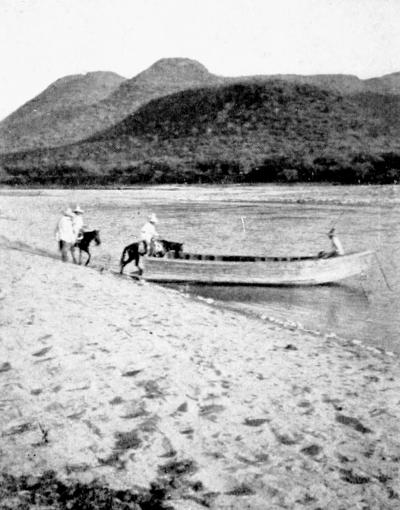
VAQUEROS CROSSING THE RIO DE LAS BALSAS
After our siesta, we loaded the two pack beasts, saddled our riding animals and, about four o’clock in the afternoon, set out for the river Balsas, two miles to the south, and to the little town of Churmuco on its banks. From the mountain side we took a last look over the wide expanse of the llanos, extending twenty or thirty miles toward the west, as level as a floor, the blue line of the Cordilleras marking the horizon far beyond.
We passed through several prehistoric, Indian towns. Their streets were laid out with regularity, generally at right angles, the foundations of the ancient houses still plainly showing. In many places, the base walls were intact and constructed of rounded bowlders laid carefully, in a row, upon one another in substantial tiers.
The rich bottom land along the river, wholly uncultivated, much impressed me. The soil, a black and chocolate loam, is capable of bearing any crop, and is twenty to thirty feet in thickness. There was no cultivation anywhere. These lands belong to some mighty hacienda (a hacienda contains often from one hundred thousand to two million acres) owned by some absentee haciendado. It is said to be worth about ten cents (Mexican) per acre!
The river Balsas looks as broad as Elk River in West Virginia, where it enters the Kanawha (four or five hundred feet in width). It is now the dry season, but, nevertheless, the river is swift and deep, a tide of clear blue water too swift and too deep to ford or swim. In the rainy season it must be a boisterous mighty stream, for its fall is rapid. In the dry season it is fed by the melting snow fields of Popocatepetl and Ixtaccihuatl far to the east. The stream is said to afford good fishing, and in it veritable crocodiles (Cayman) abound.
Approaching the river, we found ourselves at a primitive ferry where two wild-looking vaqueros were about to cross. Availing ourselves of this opportunity to voyage upon the Balsas—Mexico’s greatest river—we tied our horses in the shade of a friendly mimosa and climbed aboard the craft used as a ferryboat—a sharp pointed scow which is entered at the stern. The two Indian boatmen pulled each a ponderous blade, but despite their most strenuous efforts, the powerful current carried us down quite half a mile before we landed upon the farther shore—a wide bar of sand and pebbles. Our fellow passengers eyed us in suspicious silence, each holding fast his broncho lest it should jump out, their wild dark glances betokening little friendliness. Reaching the shore each silently swung into his saddle and galloped off toward the not far distant Cordillera. These silent, untamed men traverse this desolate country everywhere, keeping constant track of the thousands of cattle and horses which roam their wastes; and the Indians of Guerrero bear the name of being the most turbulent and treacherous of all Mexico.
Recrossing, we traveled for an hour through rich and uncultivated bottom lands along the river’s course, until we came to the primitive town of Churumuco, a hamlet occupied by Indians only, an Indian priest gazing out of the dilapidated church as we rode by. Here we found a fonda (inn) with ample corral. A half-caste Spanish-Indian woman, “Señora Doña Faustina,” cooked us a supper of potatoes, rice, tortillas, and chilis (peppers) stewed in cheese, substantials which were washed down with clear hot coffee. Here, in the intense heat, the burning peppers were vivifying and we ate them greedily.
We slept on native mats set on frames three feet above the adoby floor in the open patio. Pigs, cats, chickens, dogs and children scrambled beneath.
We were just rolling up in our blankets, when Doña Faustina excitedly addressed my companions, Tio and El Padre, and I gathered from her speech that chinchas, as long as your hand, had a habit of crawling along the rafters and dropping upon the unsuspecting sleeper, while, unless your shoes were hung above the floor, tiernanes (scorpions) were likely to camp in them until dislodged. I hung my slippers above the tiernanes stinging reach and lay awake apprehending the chinchas’ descent, but the fatigue and heat of the day, the soporific influences of chilis and cheese, soon wrapped me in a slumber from which only the braying of our white pack mule at last aroused me, as Izus cinched upon him the burden for another day. The night was warm and close, the first dull, heavy air I have known in Mexico. We were now actually in the Tierra Caliente—where, the saying is, “the inhabitants of Churmuco need never go to hell since they already live there.”
It was not yet three o’clock in the morning and still dark. Ros and poios and coffee were already prepared for us. “Adios, Doña Faustina!” “Adios, Señorita!” “Adios, Señores!” “Adios, adios!” and we trotted out of the corral and, turning northward, moved up a deeply-cut baranca over a more generally traveled trail than that by which we had come. The coldness of night no longer chilled us, the air was almost warm, while no sign of day made mark upon the heavens above us; the black spaces of the night were yet ablaze with great white stars. The constellations to the northward I well knew, but to the south there were many wholly new and, supremest of them all, just clinging along the gigantic mountain summits, shone the splendid constellation of the Southern Cross, my first glimpse of it. We reined in our horses, turned and watched the big lustrous stars descend and disappear behind the impenetrable curtain of the Cordillera’s towering chain.
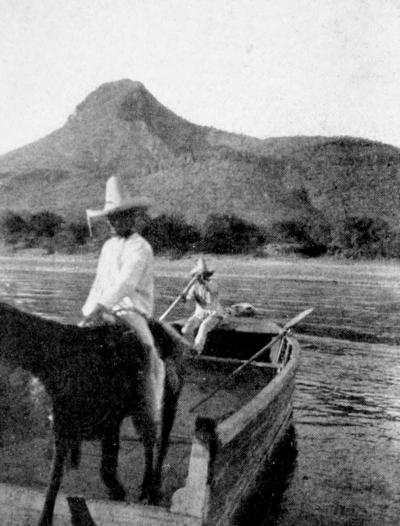
THE LANDING, RIO DE LAS BALSAS
The Balsas River was now behind us. The baranca we ascended widened out. We were upon the well-beaten track of travel from Guerrero, and even Acapulco, to the north. Ere the sun came blazing up, we were many miles on our way. And well for us it was so, for the day’s heat has been the most terrible I have yet endured. The animals did not sweat, nor did we, the air was too dry for that, but my blood boiled, my bones baked, and my skin parched from the fierce hotness of the sun. Even the cowboys we here and there encountered sat silent in their saddles beneath the mimosa’s and mesquit’s thickest shade.
The land was desolate, with no habitations save here and there a solitary rancho or wayside resting place, where passing travelers might find rough lodgment and perhaps food for themselves and beasts. The only sound was the droning whir of millions of cicadas.
It was nearly midday when we reached the grateful shelter of La Mina Noria, there to tarry and revive until we should fare on in the cooler evening hours.
XIV
Wayside Incidents in the Land of Heat
Mina Noria to Patzcuaro,
December 8th-10th.
Later in the day we were ascending the San Pedro valley toward the Hacienda Cuyaco. It was just growing dusk when we heard the music of violins. We came upon an Indian habitation of two buildings connected by a wide, thatched veranda. Here, upon the veranda, several dark-faced youths were playing a slow-timed Spanish fandango, and twenty or more young girls, arranged in rows of fours, were taking steps to the music, swaying their bodies and shaking small gourds, filled with pebbles, for castanets. The enthusiasm of the musicians, the soberness and gravity and grace of the dancers, as they stepped and postured, made a charming picture. They were gowned in white, with flowers in their black hair, and they danced with easy dignity. We halted our horses and watched the grave company, no one paying the slightest heed to our presence, otherwise than to acknowledge our “Buenas Dias” and parting “Adios.”
By the time the night came down upon us, we were far upon the road. Just at the moment of the falling darkness, we met a band of Indians with their burros. They had halted. Each Indian had doffed his sombrero. One Indian kneeling, was crossing himself. They were facing a small rough cross rising from a pile of stones. Each threw one more stone upon the pile, crossed himself, bent his knee, and moved on. It was a spot where death has met some traveler. The cross sanctifies the place. The stones permanently mark it and, year by year, the pile grows bigger from the constant contribution of the one stone added by each passing traveler.
The night found us at a primitive Indian shelter; a thatched roof above an earthern clay stove. In the corral several droves of pack mules had already been unburdened for the night. Beneath the thatch the drivers were wrapped in their zerapes and slept profoundly. We unrolled our cots, set them out beneath the stars and fell asleep, even as we were. By two o’clock we were awakened before the others were astir. We made cups of coffee from the hot water on the stove where the smouldering fire lingered through the night, and were in our saddles before the Southern Cross had sunk from view. We were to make a great day’s ride, pressing on even to Ario, if that were possible, twenty-four leagues away (sixty miles) and five thousand feet above us in the air. Should we be able to do it?
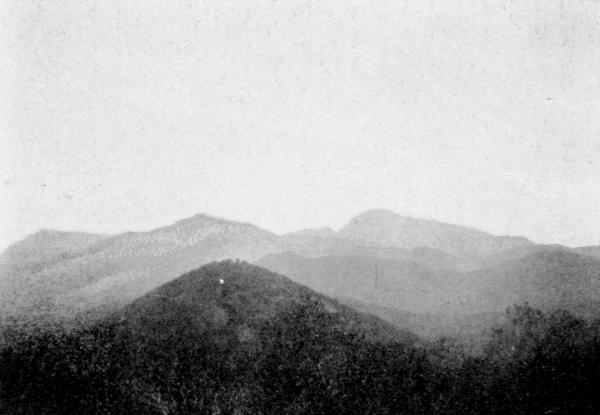
THE MIGHTY CORDILLERAS
By eight o’clock we reached the Rancho Cuyaco and stopped to obtain delicious cups of chocolate and all the oranges and bananas we could eat. The cup of chocolate prepared by the Mexican is a delightful drink. Each cup is made separately. The chocolate bean is pounded in a mortar and just enough of the vanilla bean, which here grows abundantly, is compounded with it to give it an exquisite flavor. The chocolate is thick and creamy, and if you would have your cup replenished, another ten minutes must elapse before you get it. No beverage is so refreshing to the traveler as a cup of this delicious chocolate.
By nine o’clock we crossed again the river La Playa, passed the Rancho of that name and began the great ascent toward the Tierra Fria. I started in slippers and linen trousers and thin pajama coat. Half way up the five thousand feet, I put on my woolen jersey; by noon we were traversing the forests of pine and oak near Rancho Nuevo and shivering from cold. There, heavy shoes and warm corduroys were donned. We forgot that five hours before we were burning and baking in the torrid heats a mile below.
At Rancho Nuevo we found ourselves preceded by an aristocratic company of ladies and gentlemen from the distant region of La Union, near the Pacific,—three señores and two señoras, with a number of Indian attendants. They rode fine horses, and their saddles and trappings were of the most sumptuous Mexican make. The head of the company was an elderly man with white hair and white beard, an haciendado of importance. He wore narrow-pointed, tan-leather shoes; his legs were encased in high leathern leggings reaching above the knees; his trousers were tight-fitting, laced with silver cords and marked with silver buttons along the sides; a soft white linen shirt was fastened loosely at the throat with a black silk scarf, and a short black velvet vest and a velvet jacket with silver buttons and much silver braid, completed the costume. His high felt sombrero, gray in color, bore upon the right side a big silver monogram. About his waist a leathern belt supported pistols, and great spurs clanked at either heel. The other two caballeros were clad and armed in like fashion. The ladies wore long riding habits which they held up with both hands when they walked about. There were some fine rings on the fingers of the elder woman, the younger one wearing large hoop-rings in her ears, while a diamond flashed upon her left hand. Their saddles were like chairs, upon which they sat sidewise, resting both feet upon a wooden rail. I did not make out whether they themselves guided their animals with the reins, or whether these were led by the long halter lines with which the bridles were fitted out. When we arrived, the kitchen was astir preparing dinner for these guests. Meantime, the ladies stretched themselves out upon the wooden benches for their noon siesta and the men stood about in groups watching us with suspicious mien. The truth is, the Mexicans of the better class look upon Americans with great doubt. So many Americans have left their native country, for their country’s good; so many American scoundrels have preyed upon the hospitality of Mexican hosts, that the Mexican of to-day has learned to require letters of introduction before he shows the stranger American the courtesy, which it is racially instinctive for him to bestow.
The company first arrived, ate, repacked, mounted and fared on some time ahead of us, although we hastened our own departure, cutting short the midday interval of rest, in order that we might reach Ario ere night should fall.
During the last few days I have ridden my mule without the incumbrance of the frightful bit and bridle, with which he was at start equipped, guiding him with halter alone, and I have found him all the better pace maker. He is black in color, above the average in size, and of that superior strain for which Spain and Mexico have long been famous, the high-bred riding mule. He has proved worthy of his trust, for during this entire journey he has never once stumbled nor made one false step, however rough the way or precipitous the declivity along which we have passed. To-day, near the journey’s end, he is the superior beast of the whole company, although at the start I was doubtful of my mount. This afternoon I have lent him to Tio, whose heavy bulk has galled the back of his mare. I have exchanged my lighter weight to this unhappy animal, whose sores will never be allowed to heal, and which will be ridden by successive travelers until wearied and harried to its death.
It was barely day-end when the white walls of Ario looked down upon us from the slopes above, and we were welcomed by our host of the Hotel Morelos with the warmth of an old friend. He was particularly cordial toward Tio, and I now witnessed, in all its perfection, the embrace of old acquaintance, which is the particular mark of regard among the Mexicans. Our host and Tio grasped their right hands and shook them cordially, then with hands still clasped each drew toward the other, looked over the other’s left shoulder and clapped him several percussive slaps upon the back. This process was repeated at intervals several times until finally the two fell apart with many bows of profound esteem. I sat one morning on the Plaza Grande, before the great cathedral in Mexico City, and watched two casual acquaintance thus greet each other; first, they shook hands, then they embraced, then they shook hands again, and every few minutes repeated the handshake and embrace during the lengthy conversation, each thereby seeming to assure the other that he was really the friend he made himself out to be.
We had indeed arrived at Ario. We had made a great ride since early dawn, had been more than ten hours in the saddle, traveling some sixty miles and ascending five thousand and four hundred feet! El Padre and myself first entered the narrow streets, a little later came our mozo, Izus, driving before him our pack animals, and half an hour behind him came Tio and my mule. He declared the animal to be almost dead and we feared it might be so, but the next morning, when we made ready to start out again, we found his mule-ship, as also the horses, in perfect fettle, as though no long sweltering journey and monstrous climb had been the toil of the yesterday.
The air of the highlands was fresh and keen. Its tonic was so invigorating that we forgot fatigue, and made the journey to Santa Clara and Patzcuaro as easily as when we first set out.
On these highlands thousands of sheep are raised, and I was interested to note that of the considerable flocks we saw grazing upon the wide pasture lands along our road, the majority were black. This is said to be the result of Mexican neglect. The white sheep is the work of art. Flocks are kept white by weeding out the black, but just as hogs when let run wild will revert to the stronger color, so, too, the flocks of Mexico, inasmuch as they have been wholly neglected from the day when Spanish mastership was destroyed, have reverted to the hardier hue, until to-day the larger percentage are black. To destroy these black sheep now would bring too great a loss.
In a land like this, where the horse and the mule and the burro, as well as man, are the chief means of transport, one is continually surprised at the heavy burdens borne, and the skill and care with which the loads are carried. A piano is taken apart, packed upon a train of mules and taken to a distant village or hacienda. Elegant and fragile furniture, made in France or other continental countries, is thus conveyed. In every community there are expert cabinetmakers, who can repair and put together the most expensive furniture, and who do the work so deftly that it is even stronger than when originally made.
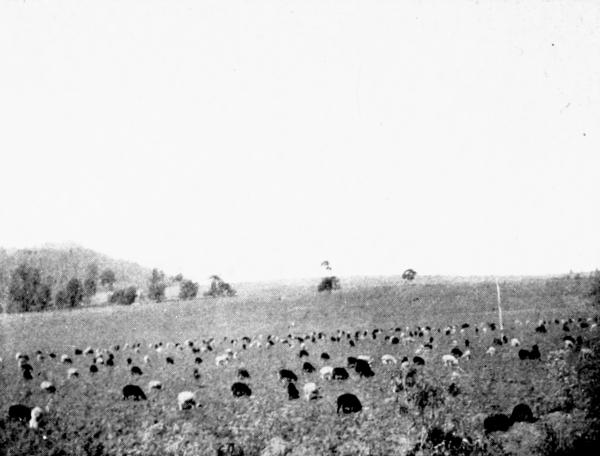
A FLOCK OF SHEEP, NEAR ARIO
There is no burden that a single Indian, or a couple of Indians, or a dozen Indians, will not bear upon their shoulders to any point or any distance you may name. These loads and burdens are carried with a care and safety that might be a lesson to the baggage-smashers and freight-breakers of our modern railways.
When we drew near Patzcuaro, we overtook multitudes of Indians, men, women and children, all journeying in the same direction as ourselves. Upon inquiry, we learned that they were traveling to Patzcuaro there to take part in the fiesta celebration held in honor of Our Lady of Guadaloupe, the patron-saint of Mexico, the Indian Madonna, whom the swarthy citizens of the republic adore. The nearer we approached the city, the greater the press of peones filling the roadways which lead to it. In the town the streets were thronged with these strange, wild people—Tarascon Indians most of them—many having saved up through all the year for this occasion, and now come here to blow in their scanty hoards in one single week. A thousand games of chance were in full blast. All sorts of schemes were being cried, every one of them calculated to rob the pious Indian of his uttermost centavo. Along the curbs hundreds of little charcoal fires were lit, where food was roasting over braziers. Men were walking through the streets with pigskin sacks of pulque on their backs and a gourd cup in hand, crying “only a centavo for a drink!” Dulce boys were carrying upon their heads large baskets of guava sweetmeats and candied fruits. Bakers went by with rings of bread about their necks and small rings of bread braceleted upon their arms. In the churches a continuous service is kept going all through the day and night, and the pious gambler of the plaza has full opportunity to rob the peon and enrich the church. Along the wayside, groups of Indians are squatting, exchanging gossip; hundreds of men are leaning against the walls, wherever the shade gives refuge from the sun, silent and wrapped in bright-hued zerapes, seeing all, but saying never a word. At the Fonda Diligencia, next the big church, a company of gentlemen of fortune from Mexico City, clad in dress suits and stovepipe hats, have opened handsome games of Caballos and Rouge et Noir, and about these are gathered the Dons and Doñas of the town. I see a priest step to the table, put down his money and make a win; a venturesome Indian, who has eyed the padre questioningly, now reassured, also steps up, puts down a few centavos and loses all!
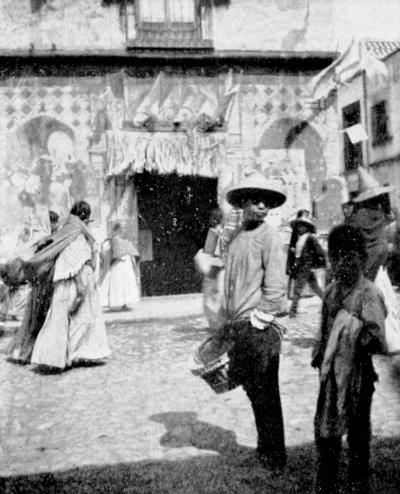
STREET SCENE—PATZCUARO
We rest again at the Hotel Concordia. We find our room where our baggage has been safely stored. We take off our corduroys and put on fresh linen and appear again dressed just as we might be when at home. Izus is sorry to say good-bye. We add one half to his pay for his efficient service, and I present him with my large bowie knife to his delight. I offer him a double price for the fine fighting cock he has brought from Noria, but this he will not give up. He has a neighbor whose chicken killed his own some months ago. He has now found a bird which will give him sweet revenge and as to selling it, money has no value in his eyes!
XV
Morelia—The Capital of the State of Michoacan—Her Streets—Her Parks—Her Churches—Her Music
Morelia, State of Michoacan, Mexico,
December 12th.
The Congress of the great State of Michoacan, as big a state as ten West Virginias, with a population of six hundred and fifty thousand, is in session at the State capital, Morelia. It meets three times a week in the Palace. A learned member of the bar and a member of Congress, escorted me to the dignified body, and formally introduced me as “Señor Licénciado Eduardos, del Estado de ‘Quest Verhinia,’ de los Estados Unidos del Norte.” All the members arose to receive me. There is only one chamber. Its fourteen members make all the laws for Michoacan, always subject to the approval of President Diaz in Mexico City. Diaz decides who shall be the fourteen members. He instructs the Governor of the State to have elected the fourteen men whom he names, and those fourteen are always chosen, and no others. President Diaz also says who shall be elected Governors of the different States, and they are always elected.
After this Congress had saluted me and I had bowed in response, we all sat down in the handsome room. The fourteen were mostly small dark men with good heads. The President of the Congress was an old man with white hair, a wrinkled face and long white mustachios. He did most of the talking on all measures. He kept his seat while he talked. The first business before the Congress was “Reports of Committees.” Each member was a whole committee. Each committee made a report, and stood up, facing the President to make it. The chief matter under consideration was a railroad concession to Americans, involving a land grant of thousands of acres. The Congress will grant it because President Diaz says the railroad should have it. After an hour or more of talking, the Congress adjourned. The members came up and were introduced. I shook hands several times with each member and still more often with the President.
Adjoining the hall of Congress were several large rooms, the walls hung with portraits of the great men of Michoacan, who helped to make Mexico free, and who helped to destroy Maximilian. This fine city of thirty-five thousand people was formerly called Valladolid. But when the Spaniards shot the patriot, Morelos, ignominiously in the back, the people changed its name to Morelia,—for Morelos was their fellow-townsman,—and they clanged the church bells and made bonfires and illuminated their houses when the last Spanish Viceroy was driven from the land.
The señor by whom I had the honor of being introduced to the Congress, I afterward had the pleasure of meeting more intimately in his law office, Señor Don Licénciado Vicente Garcia, Senator, Judge, Counselor of State, and Lawyer profoundly versed in the curious learning of Spanish-Mexican law. He is a gentleman of the Old School, a cultivated Mexican of that small class among whom have been continuously preserved scholarship and learning, since the earliest advent of the few Doctors of the Law, who accompanied the first Viceroys to New Spain. Men ripe in mediæval scholarship, apart from the teachings and doctrines of the Canon Law, they have always formed a distinct class in Mexico, even as in Old Spain, and have jealously cherished that seed of intellectual independence from which has successfully developed the opposition of the State to the incessant and covert encroachment of the Roman Church.
In Señor Garcia’s library of well stored shelves I noted many curious and ancient vellum-leaved tomes, containing some of the earliest printed codes of Mexican law, as well as treatises in French upon the Napoleonic Code, and there were some few decisions, in French, of the Courts of Louisiana. There was also a Blackstone in English and a few newly bound law treatises in that tongue,—volumes belonging to his son, he said, who was taking a special course in English in the University of the State.
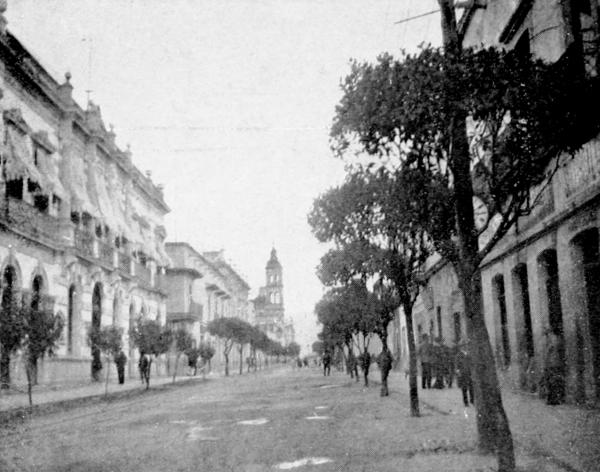
A VISTA IN MORELIA
Don Licénciado Garcia is a short-set man with whitening hair and gray moustache and intellectual face. You at once know him to be the student and the scholar, although with dark glasses screening his eyes, he pathetically informed us that he was fast growing blind. Indeed, he can no longer see to write or read, but employs a reader and trusts to his son for all correspondence, thus conducting his large practice with eyes and hands other than his own. We found him a busy man, for in Mexico the courts are perpetually in session, and a case once on the docket is liable to be called at any time.
There are many such men in the Mexican Republic as Señor Garcia, and to them must really be credited much of the conservative disposition of the government. They are the conservators of scholarly liberalism, and form a community of intelligence and learning upon whom President Diaz
can always rely to give assistance and direction in sustaining and preserving the stability of the Republic.
Morelia is a city older than any city of the United States. Its streets were paved before Boston was out of the swamps, and before Richmond was thought of. All Mexican cities are paved, every street, every alley. A great aqueduct, built on immense arches, brings an abundant supply of sweet, fresh water. There are many beautiful parks in these Mexican cities, all kept in perfect order at municipal expense. In them, flowering shrubs, roses, geraniums and heliotropes, grown to veritable trees, are ever in bloom; there are orange and lemon, pomegranate and fig, palm and banana trees; there are statues and flowing fountains, and great carved stone seats, all free to the people.
There is plenty of flowing water on these high tablelands, and already its power, harnessed to the turbine and dynamo, is giving the people free electric lights. The Mexican towns and the city governments are run for the benefit of the people. There are no monopolies. If President Diaz hears that a mayor, a city council, or a Congress is not running things as he judges they should, he just hints to the gentleman to resign. If he does not comply, a polite invitation requests him to come to the Capital and dine with the President. If he is not hungry and fails to come, then a few soldiers (numbering in one case a small army), come down and politely escort the gentleman to the dinner. He may be shot, he may be permitted to live quietly somewhere in the President’s city with a soldier for a life companion,—but he never goes home. An Ex-governor of the State of Guerrero has been living in Mexico City, with a soldier for a chum, these twenty years!
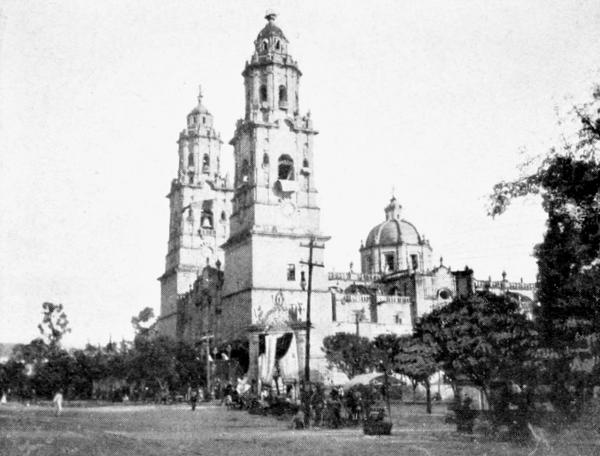
THE CATHEDRAL—MORELIA
Mexican cities are clean. A man who doesn’t sweep his sidewalk, who disobeys a notice to keep it clean, may wake up in jail. There is no “habeas corpus” in Mexico. Once in jail, a man may stay there a lifetime. And Mexican jails are not pleasant places wherein long to abide.
Each State is divided into Distritos, corresponding to our counties. Each Distrito, instead of having a county court as do our West Virginia counties, has a Jefe Politico (Political Chief) appointed by the Governor. He keeps the peace, he runs the county. If he is a bad man, the Governor with the approval of President Diaz, may have the Jefe removed or shot. The Jefe (“Hefy”) within his Distrito has the power of life and death. If a citizen raises “too much hell” in his precinct, the first thing he knows he is taken out in the woods by a band of rurales—(rural police)—and promptly shot, and he is buried where he falls. A man thus arrested and shot is said to have “tried to escape and been shot while escaping.” No questions are asked. The Jefe rules his Distrito with a hand of steel in a glove of velvet, just as President Diaz rules the nation.
Mexico has an able, intelligent, if arbitrary government. She is awake. She is progressive. I have been amazed at the wealth and beauty, the cleanliness and comfort of her towns and cities, at the splendor of her capital, at the fertility and variety of her soils and climates,—the perpetual spring of Ario and Morelia and Toluca and Mexico City,—the eternal summer and tropical heats of the lowlands of the Tierra Caliente, while between the lofty highlands and the lowlands lie the temperate levels, the Tierra Templada, where are climates ranging from those of Cuba to Quebec.
Three hundred years ago Spanish civilization was ahead of that of England and Germany. But Spain and her colonies stood still. To-day our Teutonic peoples are in the lead. Progressive Mexicans, who have no love for Spain, know this, and are fast learning what we have to teach.
No one thing has pleased me more in this splendid, opulent country than to discover that everywhere men are eager to learn the American tongue. That language is taught in all public schools, in all the colleges. It is the hope and pride of every man of means to have his son able to speak English. In fifty years, or less, English will have largely driven out the Spanish speech, and none are more eager for this result than the progressive ruling men of Mexico.
Morelia has much civic pride, and above all else she is proud of her music; proud of her bands. Once a year the musical Morelianos have a competition among themselves, and the band declared the winner is sent to Mexico City to contest with bands from other cities for the musical pre-eminence of the Republic. Great interest is taken in these musical contests. For several years the champion band of Morelia has carried off the national prize. To play in the band is a mark of distinction, and the band leader is a local dignitary. The chief band plays in the plaza throughout each afternoon. This park is filled with fine trees, with many flowers, and has several fountains and comfortable seats, where you may sit and listen to the plash of the tinkling waters and the moving melodies of the band. These seats are free to all. Then, too, there are chairs for which the city sells the privilege, and the chairs are rented for cinco centavos (five cents Mexican, equal to about two cents United States) per hour, for a plain rough-bottom chair; vicenti-cinco centavos (twenty-five cents Mexican) for a big chair with arms. You pay your money, you sit in your chair and enjoy the music as long as you care to listen. Poor peones sit on the free benches; those who have the few centavos to spare rent a plain chair. The rich merchants and haciendados rent the big chairs, and sit there with their families gossiping and applauding the music and watching the circling throngs who walk around the square. The señoritas, three or four abreast, with chaperons, walk on the inside of the broad pavement. The dashing caballeros and rancherros, the dudes and the beaux, in their bravest adornment, walk three or four abreast in the other direction on the outside. Young gentlemen may never speak to young ladies upon the streets, but they dart burning glances at them, and the black eyes of the señoritas are not slow in their response.
I spent one morning viewing the markets and watching the city life on the streets. In Mexico your social standing is marked by the shoeing of your feet, the covering of your head; your boots and your hats are the two things a Mexican first looks at when approaching you. The Mexican loves to thrust his feet into long, narrow toothpick-pointed shoes; the smaller and daintier the happier he is. For a hat, the costly sombrero, for which fifty to one hundred dollars are often paid, covers the man of means; sometimes a hat may cost twice this sum. It may be of felt, or of expensive braided straw with a band of woven gold or silver threads about the crown. Generally, a large gold or silver monogram several inches high is on one side. I wore a pair of broad-soled, oil-dressed walking shoes, with big eyelet holes for the laces. Substantial and comfortable, they would have been quite correct in the States, but the passing throngs upon the streets stared with frank perplexity at these, to them, extraordinary shoes. My sturdy foot gear became the comment of the town. As I sat in the park in the afternoon, several groups of the young and fashionable came up, and pausing, gazed intently at my novel footwear. My hat, a comfortable slouch of the trooper type, also seemed to them of wonderfully little cost—“Only five dollars for a hat!” “Ciertamente! El Señor must have paid more than that!” The American trousers, not fitting tightly to the leg, were also remarked. It is complained, that the young men of wealthy Mexican families, who are now attending Cornell and Harvard and Yale, instead of going to old Spain or to France, return in these American clothes, and insist upon wearing these loose American trousers to the scandal of conservative fashion. Among the ladies, however, the American hat has not yet conquered the mantilla, and for this I have been thankful. The graceful mantilla is so attractive and sits so daintily about the black-braided brow of the señora and the señorita who pass you by!
It is against the laws of Mexico for the religious orders any longer to live within the Republic, but at Morelia there are said to be several of these orders existing clandestinely. A group of ladies, whom we met at the station of departure, all quietly gowned in black, wearing black tapalos—like a reboso but of more costly material—about their heads, were pointed out to me as a subrosa company of nuns.
Morelia is the seat of an Archbishop. The cathedral is a beautiful duplicate of that of Valladolid, in old Spain. It is kept in perfect repair. Within, it is resplendent with gold and silver and richly colored walls and roof. It possesses many beautiful statues of the saints and one of the finest organs in the world. The rich Archbishop is said to be worth more than six millions of dollars (Mexican). He is said to own thousands of fertile acres of the best lands in the State of Michoacan. (All of this worldly wealth the Archbishop holds subrosa, contrary to the letter of the law.)
There are several hundred churches in Morelia. Here Roman Ecclesiasticism looms large and makes itself attractive to the people. We attended a night special celebration of the Mass in a fine, large church, dedicated to Nuestra Señora de Guadeloupe. The church within and without was illuminated with thousands of electric lights. A full orchestra was employed, violins, cellos and mandolins, flutes, cornets, horns and trombones, a fine organ as well as a piano, while several hundred men and boys cassock-clad, chanted and sang in wonderful harmony with the exquisite orchestral music. Many of the voices revealed the highest cultivation, and some of the male sopranos rose strong and sweet and clear as the tones of a Nordica.
As we stood near the portal of the church, listening to the music and watching the multitude of worshipers, an Indian, wild as the Cordilleras of Guerrero, whence he came, timidly entered and paused in the marble portal as one transfixed. His hard, rough feet were without sandals. His red zerape hung in shreds over his tattered, once white garments. His shock of black hair had never known a comb; and even though at last he doffed his sombrero, it was some moments before he pulled it off. He came from the outer darkness. He stood in the blazing glare of the thousand lights, forgetting to cross himself, listening to the mighty melody of the great chorus and many instruments, staring at the brilliant scene. His eyes grew large, his face stiffened, his breast heaved. He conceived himself transported to Paradise! My Protestant missionary friend watched him as did I, and then turning to me, observed, “Can you wonder that the Protestant missionary is not in it, when he undertakes to compete with the sumptuous splendor and organized magnificence of ritual and edifice in the Roman Church? Our only chance is to open schools for the children, take them young and instruct them early, and then, perhaps, when they grow up, some few of them may have learned to adhere to the simple doctrine and plain practice of our Protestant teaching.”
The Jesuits here sustain the fine college of San Nicholas for men, where Hidalgo once taught and Morelos learned, and which, founded in 1540, boasts that it is the oldest institution of learning in the Americas. The Jesuits also maintain a large school for young women. They are endeavoring to resist the tide of progress which is so fast Americanizing the land. But even here the upgrowing generations are giving steadily increasing support to the policies of the enlightened and liberal men now guiding the destinies of the Republic.
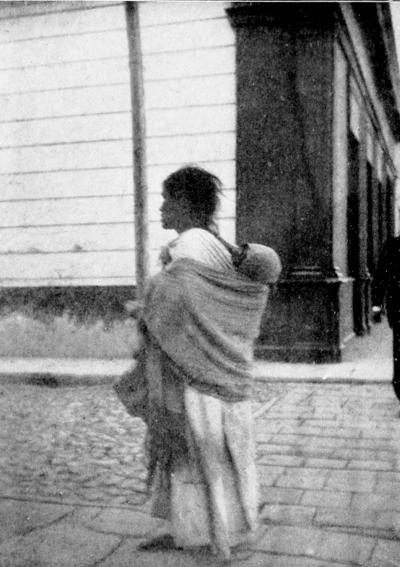
A WILD OTOME IN FLIGHT FROM MY KODAK
XVI
Morelia and Toluca—The Markets—The Colleges—The Schools—The Ancient and the Modern Spirit
Toluca, Estado de Mexico, Mexico,
December 14th.
Yesterday afternoon at four o’clock I left Morelia by the National Railroad and reached here at three o’clock in the morning. Tio continued on to Mexico City, but I stopped over to spend the day with my friend, El Padre, the missionary, who has been one of our party to the Tierra Caliente.
From my hotel Jardin, in Morelia, I rode down to the station in a most ancient little car pulled by a single mule; the electric tramway has not yet arrived at that capital.
It was yet dark when I was awakened for Toluca. When I left the train the air was cold, frosty. The city was silent, but it was well lighted with electricity, and a modern electric tram car awaited me at the station. Toluca thus gave me at the hour of my night arrival the impression of being more modern than Morelia, and this impression was borne out upon later acquaintance.
Toluca is one of the more vigorous of the growing cities of the republic. It is a community of some twenty-five thousand people, the capital of the State of Mexico, and lies one thousand feet higher in the air than Mexico City. It is near the center of a fertile valley, forty or fifty miles in length, and ten to twenty broad, while ten miles to the southwest towers the snow-capped Volcano de Toluca, lifting its gleaming cone fifteen thousand feet into the heavens, its melting snows giving an abundant supply of pure water to the town.
The religious differentiation between Toluca and Morelia is marked. Morelia is one of the six cathedral cities of Mexico, and is the seat of one of the six Archbishops. Morelia is also the center of Jesuit activity in Mexico. In Morelia, the Spanish-Mexican takes off his sombrero when he passes the cathedral; the Indian kneels down in the street and crosses himself. The several hundred churches are kept in excellent repair. Ecclesiasticism dominates, the layman is subordinate. In Toluca, on the contrary, Church rule is pushed aside; while there are a number of churches, they are old and most of them dilapidated. The foundations of a great cathedral, laid many years ago, are now overgrown with grass and bushes. No money has been forthcoming from Tolucan pockets to build it up. The governor of Toluca is among the most progressive and liberal men of the republic. His administration maintains large schools and academies for the instruction of young men and women, where the sciences are taught, where enlightened thought rules, and where particular attention is paid to the English language and literature. Several of the instructors are from Chicago.
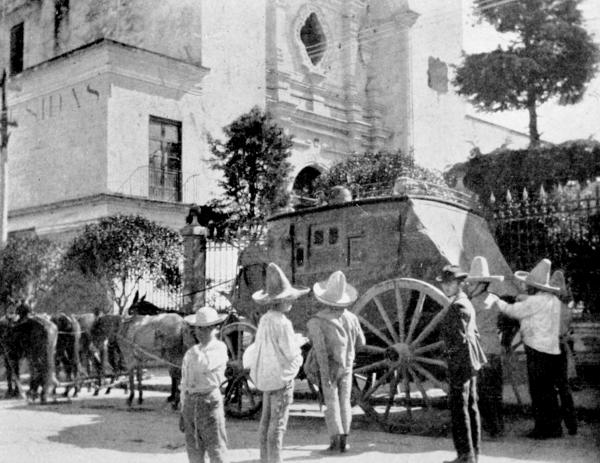
A DILIGENCIA—TOLUCA
There are many fine residences in Toluca, with handsome private grounds. The public buildings are new and imposing; the Alameda Park, with its groves and gardens and multitudes of birds, is as beautiful as Chapultepec.
There is also great business activity in Toluca and a number of successful manufactures.
The morning of my visit, I noticed an unusual crowd upon the streets. It surged toward me. It was respectful and quiet. The swarthy company were pressing to look wonderingly upon two little Swedish girls, with the bluest eyes and pinkest cheeks, and braids of the most golden hair—perfect types of the Scandinavian North. They were the children of workmen imported from Sweden and now teaching Tolucans the skilled manufacture of iron.
The rich valley, with its climate of perpetual spring, is the home of a large Aztec and Otomy Indian population. These live in many towns built of stone and adoby, containing two and three thousand souls, even yet speaking their ancient Aztec tongue, knowing only Spanish enough to trade. They are mostly agriculturists, and raise large crops of wheat and corn, which are borne to market upon the backs of men and mules and burros. We met many such burden-bearing cavalcades entering the city, and generally driven by Indians of the wildest types we yet have seen. The sturdy and rugged men are of a stronger race than the inhabitants of the Tierra Caliente along the valley of the Balsas. These Indians run, not a man of them walks. They take a quick, short step, a sort of jog-trot, which carries them forward a great many miles a day.
The climate of Toluca is colder and drier than that of Mexico City, the town being so much higher above the sea. The temperature at night, all the year round, is said to be nearly at frost, falling as low as thirty-nine degrees (Fahrenheit). In the markets to-day I have seen oranges, limes, tamarinds, apples, guavas, hawberries, three sorts of bananas, strawberries, and several other fruits I did not know, as well as fresh peas, beans, lettuce, turnips, beets, potatoes, sweet potatoes, yams, and several other edible tubers. I have also just purchased some of the celebrated Toluca lace, made by the Indians, and some pretty head shawls, (tapalos), of native make. An Indian pottery, made here, is also attractive—a brown and yellow ware, made into jars and water jugs, some of which I am sending to Kanawha.
What a land this country of temperate highlands would have become if only our Puritan and Cavalier ancestors had discovered and taken it! But the descendants of Puritan and Cavalier have at last found out the charm and richness of this great country and, little by little, are beginning to come into it, sympathetically collaborating with its people. Mexico will yet become a most potent factor in the world’s affairs. Progressive Mexicans hope for the day when Mexico will become even more closely knit to the great Republic of the North. Reactionary Mexicans, the conservatives of the Roman Church, dread and deprecate the impending change. El Mundo, chief newspaper of the ecclesiastical party, continually declaims against what it denounces as the “Peaceful Conquest,” of Los Americanos.
In Toluca there was no extensive celebration of the twelfth of December, “The Coronation day of the Virgin of Guadalupe, the Indian Madonna,” to every Indian the greatest festival of the year. In Morelia, on the contrary, just as in Patzcuaro, the town was lit up from one end to the other with electricity, with gas jets, with lanterns, with multitudes of candles, with torches. The cathedral and the many churches were trimmed with bands of fire along each cornice, up and down each belfry and tower, and all the hundreds of bells were clanged discordantly. The bells of the churches of Mexico are not swung and rung, nor have they any clappers hanging in their throats. The bells are made fast in one position, are struck with a ponderous hammer, and distract the stranger with their incessant dissonance.
The illumination of Morelia is said to be paid for from the Archbishop’s chest, although each layman is expected to set out his own candles before his door. In front of the cathedral a company of priests touched off elaborate fireworks. During the day, hundreds of Indians came into the city, even as I saw them entering Patzcuaro. They camped along the streets, cooked at little fires along the curbs, and slept wherever they happened to be. These Indians were chiefly afoot, the women brought their babies upon their backs, even the old folks were sometimes being carried along upon the shoulders of the younger men. The thronged and excited city was early awake. In fact, it never slept. And there were not only the swarms of Indians, but also groups of dashing haciendados in their high sombreros, short velvet jackets, and tight-fitting, silver-laced and buttoned pantaloones, all mingling and promenading and celebrating the fiesta of Mexico’s patron saint.
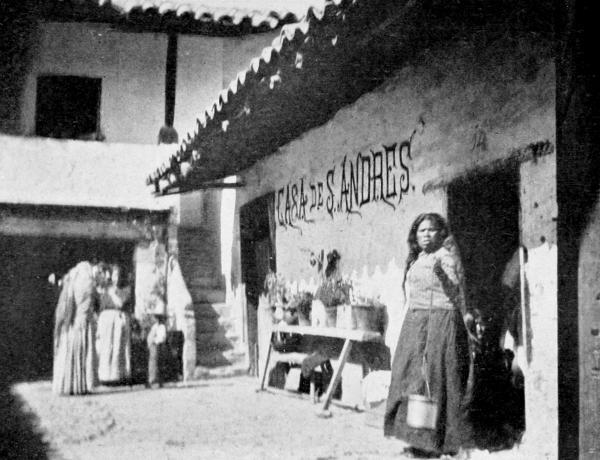
A SNAP-SHOT THROUGH A DOORWAY—TOLUCA
In Morelia no one has yet dared to sell a foot of ground to the Protestant missionaries. To do so would mean the seller’s ruin.
In Toluca the Protestant Church (the Baptists) have purchased buildings and opened a fine school for boys and girls, which is become the pride and life work of El Padre.
So many smooth and cunning scoundrels have fled to Mexico, there to hide from American justice, that the Mexican has begun to doubt us all. Hence it is doubly gratifying when one finds here honored and esteemed the better type of our enlightened citizenship like El Padre, and some others whom I have met.
XVII
Cuernavaca—The County Seat of Montezuma, of Cortez and Spanish Viceroys, of Maximilian—A Pleasant Watering Place of Modern Mexico
Hotel Iturbide, Mexico City,
December 17th.
This is my last night in Mexico City. I shall leave here to-morrow, Wednesday, at 9.30 P. M., by the Mexican Railway for Vera Cruz. I will reach there in time for breakfast, board the Ward Line’s steamer, Monterey, and sail about noon for Havana, via Progresso, Yucatan.
I delayed my departure until the evening, in order that I might visit Cuernavaca and have a glimpse of that famous watering place and the rich valley wherein it lies—where Montezuma and his nobles held luxurious court, where Cortez made his winter residence, and Maximilian erected a lovely villa for his Empress Carlotta; and which is, to-day, the favorite resort of fashionable Mexico. My passes would have taken me a hundred and fifty miles further along the river Balsas—two hundred miles above where I saw it at Churumuco—but limited time prevented my going so far, and I contented myself with the lesser journey.
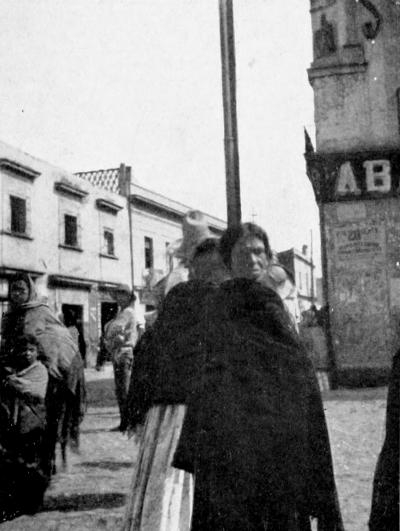
SUSPICIOUS OF MY CAMERA
I took the train this morning for Cuernavaca, at the large station of the Mexican Central Railway. I sat in a drawing-room car, as new and comfortable as though just leaving Chicago or New York. Quite a party of the ladies of the American Colony went down with me; along with them were several gentlemen, who seemed to belong to the diplomatic corps, and among these was the Swedish Consul, with whom I made conversation in German and French.
The railway leaves the city on the east side, curves to the north, and circles around the northern suburbs, until it begins to climb toward the southwest.
As we rise—a four per cent. grade—the fertile and beautiful valley of Anahuac, in which Mexico City is situated, spreads out before me. The big white city, its red and black-tiled roofs, its many domed and towered churches; the numerous lesser towns and villages scattering out into the bowl-like valley; the shimmering surfaces of lakes Tezcoco, Xochimilco, and Chalco, and bordering ponds; the plantations of dark maguey; the orchards of citrous fruits; the innumerable gardens, floating gardens some of them, from which are gathered the fresh
vegetables daily displayed in the city’s several markets; the dark green groves of the splendid cypress of the Alameda and of Chapultepec, as well as the palace itself, perched high upon its rocky base; the circling ranges of lofty mountains, and, in the far southern distance, the mighty volcanoes of Popocatepetl and Iztaccihuatl, snow-crowned and glittering with dazzling refulgence in the light of the morning sun,—all these made a picture as grand and imposing as any landscape I have seen or may ever see, and as astonishing in its contrasts of light and shadow, of green semitropical valley and icebound heights.
For several hours we crept slowly upward,—the views and vistas ever changing. Everywhere there were plantations of maguey, and everywhere at the stations Indian women were selling fresh pulque to the thirsty travelers of the train. Then, little by little, as we were lifted above the warmer airs, we came into the altitude of the oaks, extensive forests of well-grown oaks, and then yet higher we came into splendid forests of pine. The mountains now lost the smoothness of surface, which marked the lower slopes. We came into wide reaches of volcanic ash, tufa, beds of lava, all rough and sharp pointed, with deep cavernous clefts between, apparently lying just as they fell and flowed and hardened uncounted centuries ago.
Upon reaching the summit, attaining an altitude of over ten thousand feet above the level of the sea, we traversed for many miles a grassy tableland, where were herds of the long-horned cattle, and flocks of the thin-wooled sheep with their keepers. Running parallel to our track extended the ancient Royal Turnpike, built long ago by Montezuma and maintained by Cortez with the labor of his conquered Aztec slaves, and still called “El Camino Real del Rey.” On the very summit of the height of land stood the ruins of an old roadhouse and towered fortress. Here Cortez placed his soldiers, and here garrisons of troops have ever since remained to guard the public, to protect the royal mails, to preserve the dignity of the Republic, and even to-day to save the railroad trains from being held up by modern bandits as bold and merciless as their predecessors of bygone centuries. It is the tradition concerning these heights that they have always been the rendezvous of tribes and bands, whose immemorial privilege and occupation it has been to kill and rob. Gruesome are the tales to-day related of the murders and plunderings which once were of almost daily occurrence, and sometimes do yet occur along this famous road. Even now, I notice the camp of soldiers in permanent quarters beneath the shadow of the crumbling tower. Diaz, of the iron hand, takes no chances with the turbulent residents of these mountain solitudes! All along we are among the ancient lava beds, while always lifting into the deep azure sky far out to the left, glitter the snow-clad summits of Iztaccihuatl (Ista-se-wahtl) and Popocatepetl. They appeared to be close to us, and yet we never came any nearer to them,—although we steamed toward them almost half a day.
The descent was rapid—we came down nearly five thousand feet in an hour and a half—into a most lovely verdant valley, two thousand feet lower than Lake Tezcoco. Here grew great crops of sugar cane, bananas, coffee, and oranges, limes and pomegranates—a profuse verdure. The valley, from ten to twenty miles in width, stretched away in broad sweeping curves both east and west, while through it flowed the upper waters of the River Balsas. Here the river takes its rise from the fountains of the melting snowfields upon the volcano’s distant flanks. The valley is one of the most fertile and salubrious in all Mexico. Cortez seized upon it almost as soon as he had wrested Tenochtitlan from Montezuma’s grasp. What he did not take for himself, he divided out in liberal gifts among the great captains in his train, granting to them immense haciendas, farms fifty miles across, embracing lands of unbounded fertility, even then smiling beneath the care of skillful tillers of the soil. The best of these monstrous estates are still owned by families descended from the Conquestadores. The lands originally were all subject to the law of entail, and the laws are still upon the statute books. Here are famous prehistoric ruins, among them those of the ancient pyramid and temple of Xochicalco and many hieroglyphics dating back to an antiquity more remote than the memory of even the Aztec people. Here also are the caves of Cacahuamilpa, equally famous. The great ruins, lying a day’s journey from the city, I did not have a chance to see.
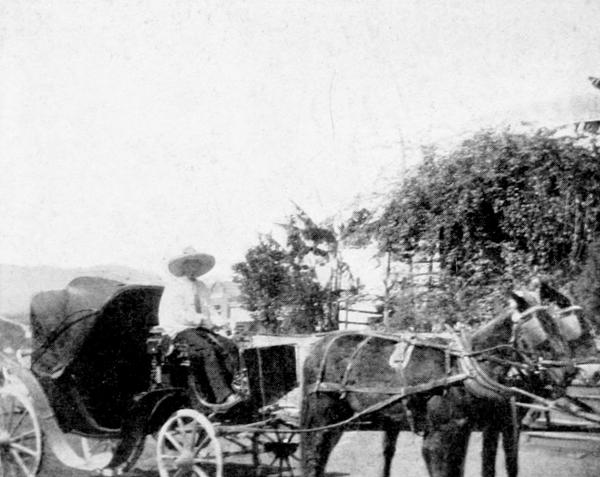
MY COCHA—CUERNAVACA
My glimpses of the town of Cuernavaca were but flashlight peeps. The station, where we finally arrived, after descending by a long series of zig-zags and sweeping curves, lies a good mile outside the city. Here a motley assemblage were gathered to greet our advent, an array of cochas, voitures, and cabriolets, drawn by dusty, uncurried mules and horses. Remembering my experience, when last arriving in Mexico City, I hurried to an antique vehicle, drawn by a pair of mules, and bargained with the young cochero that he should drive me to and about the city of Cuernavaca and bring me back to the station. This after some haggling, he agreed to do, all for one peso (Mexican silver dollar). I climbed into the dusty equipage. The cochero swore at his mules in sonorous Spanish, and cracking his long-lashed whip, started them on a full run down the wide camino, amidst a cloud of white dust. Thus we entered the city and thus we proceeded through streets narrow and broad, until we had traversed and circled and driven through the chiefer part of it. He never stopped his swearing, he continually cracked his whip, and the mules never slackened in their wild gallop throughout the happy hour he was in my employ. There are no sidewalks in these Spanish towns. Men and women bolted from our onward coming, children fled into open doorways, and dogs and chickens and lank hogs scattered before us as chaff before the wind. We rattled past the one-time palace of Cortez, afterward of Carlotta, Maximilian’s ill-fated mate, and now used as the State Capitol. We circled the pretty plaza with its flowers and palms and tropical gardens and splashing fountains. We viewed the monstrous cathedral, all dilapidated. We drew rein a moment before the shrine of the Virgin of Guadeloupe, kodaked it, and swung along in front of the old church of the Franciscans.
My cochero seemed to gain enthusiasm with each bounce of the cocha. He clamored continually in voluble and quite incomprehensible Indian-Spanish. The narrower and more ill-paved the street the more violently did he lash the mules like one possessed. A pair of pretty señoritas, on their balcony smiled upon me as we passed, and I kodaked them in courteous acknowledgment of their good will; we beheld where the famous baths of Cuernavaca have for centuries been taken, and I had pointed out to me the magnificent and extensive Borda Gardens, where flowers and fruits, fountains and cascades, marble basins and miniature lakes express in utter riot the prodigal and exuberant fancies of an ancient half-mad millionaire; and still proceeding, never stopping, we at last whirled back amidst even greater clouds of dust to the railway station, just in time to catch the train. Another motley throng was gathered there. Half of the town seemed to have turned out to see the other half depart. Along the platform were many Indians selling fruit and compounding those curious peppered sandwiches, which so delight the seasoned palate of the Mexican. By this time the lining of my own mouth having become somewhat inured to these fierce foods, I let an old Indian crone make for me a particular combination of bread and oil and pepper and cucumbers and highly-seasoned and minced meat, only daring to eat it, however, when I had entered my car again, so that I might be in close neighborhood to copious supplies of water. The Mexican delights in this sort of burning sustenance, and for him it can never be made too spiced and too hot. On the platform of the station there were also many Mexican ladies of quality, come to say good-bye to husbands and brothers, who were returning to the capital. None of them wore hats, but the graceful mantillas were universally in use, and, generally, the gowns were black.
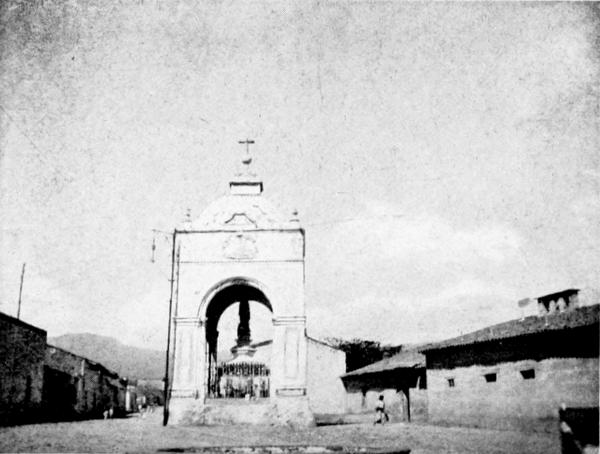
SHRINE OF THE VIRGIN OF GUADELOUPE—CUERNAVACA
Cuernavaca with its baths and mineral waters is the favorite of all the resorts, easily accessible to the fashionable Mexican. Here also almost continually resides a large colony of the European ladies whose husbands do business in Mexico City, the high altitude, thin air, and chilly temperature of which rarely agree with the health of the women who come there from the lower sea levels. The men can stand it from the first, if their hearts and lungs are sound, but the women are often sent to Cuernavaca, there to sojourn until they become acclimated to the conditions of these highland plateaus. The harsh climate of Mexico City is particularly cruel to all convalescents; hence invalids also come here to regain their strength. Thus, there is much travel upon the railway between the capital of the republic and its most salubrious, nearby resort.
It was afternoon when we drew out of Cuernavaca for the long climb to the height of land. As we ascended, the evening shadows were lengthening and creeping out from every cleft and hollow along the mountain sides; and toward the east, splitting the blue sky, towered Popocatepetl. The most profound impression of my sojourn in Mexico, a memory which will follow me through life, is that of the mighty, glittering, distant, yet ever-present, snow-bound cone of Popocatepetl.
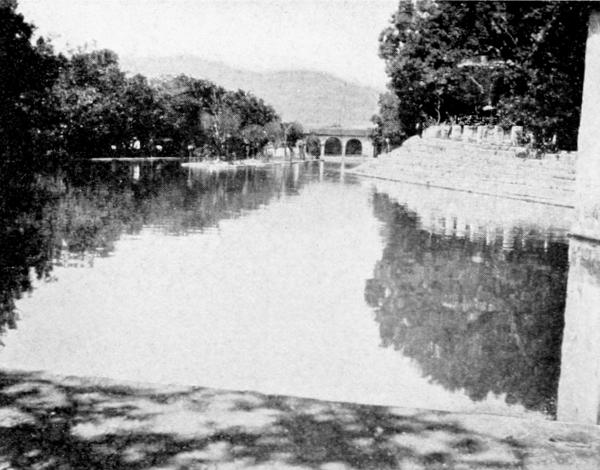
THE BORDA GARDENS—CUERNAVACA
As we crossed the height of land and began our descent, the long evening shadows filled the great valley of Anahuac, while forth from every vale and hollow crept little bunches of cloudlike mist, until at last, with strange and weird effect, the assembled vapors shut from my vision the whole extent of the valley beneath, and made it seem as though we were plunging into the unfathomable depths of a white sea. The land, the lakes, the towns, the villages, and the city were hid beneath the impenetrable, fleecy cloud-billows.
It was dark when we entered the city. I took a cocha, and I am here again in my stone-walled chamber of the hotel. I entered the city from the north, I now leave it by the east, along the route which was traversed by the invading conquerors from old Spain, when four hundred years ago they came up from the placid waters of the sea, a dreadful apparition, bringing death in their mailed fists, and pestilence and cruel enslavement to a proud and ruling race.
XVIII
The Journey by Night from Mexico City—Over the Mountains to the Sea Coast—The Ancient City of Vera Cruz
Vera Cruz, Mexico,
December 19th.
Last night was to be my final one in Mexico, and as a troupe of Spanish actors was billed at one of the larger theaters, I went to see the play. There are a number of playhouses in the city, and paternal government is laying the foundation for an opera-house which, it is announced, will be one of the most “magnifico” in the world. The theater we attended was one of the largest, and the actors, Spaniards from Barcelona, were filling a season’s engagement. In purchasing tickets, the first novelty was the separate coupons which are issued for each act. You buy for one act or another as you prefer. The Mexicans rarely stay the play out, but linger for an act or two and then depart. There are tiers of boxes around the sides, in which were many men and ladies in evening dress, the belles and beaux of the city. We sat among the occupants of the seats upon the floor, the greater part of whom were men. The first noticeable difference between the audience here and that at home is that every man keeps on his hat except when occupying a box. It is bad enough, we think, for a woman to retain her hat or bonnet, but imagine how it is when you are confronted by multitudinous high-peaked broad-brimmed sombreros of the most obtrusive type. The excuse for the wearing of these great hats upon all occasions is, that in the chilly air of these high altitudes, it becomes a necessary protection.
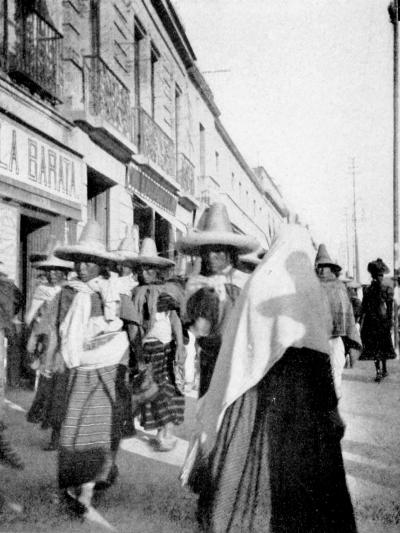
AZTEC INDIANS—MEXICO CITY
The faces about me were dark; even the men in the boxes were of darker color than would be those of the pure Spanish blood. The women are also dark, their color much darker than that of the usual mulatto in the States. This is due to the large infusion of Indian blood among the Mexican people, even among the leisure classes.
The actors were of the Spanish swarthy type, but among the actresses, there were, as always, two or three with conspicuously red heads, the Venetian red so pronounced and popular among the London shopgirls. These red headed belles received the entire attention and applause of the male portion of the audience. The audience also smoked incessantly, the gentlemen large Mexican cigars, the ladies their cigarettes. The right to smoke is an inalienable privilege of both sexes in Mexico, the women using tobacco almost as freely and constantly as do the men. The acting was good, and some of the fandango dances brought thunders of bravos. The pauses between acts were long. In one of the intervals we sauntered out upon the streets, where a mob of ticket brokers so assailed us and bargained so successfully for our remaining coupons, that we sold them at an advance over the figure we had paid. The plays begin early, about seven o’clock, and the doors stay open until midnight, the constantly changing audiences giving to the actors fresh support.
On a previous night we visited another theater, where a more fashionable company gathered to see the well-known Frenchman, Frijoli, in his clever impersonations of character. Here were assembled Mexico’s most fashionable set, among them a party of distinguished South Americans attending the Pan-American Congress, the ladies from Brazil, Argentina, and Chili wearing costly diamonds, and being in full decollete attire.
Here also the sombrero reigned supreme in dress circle and on parquet floor, and smoking was everywhere indulged in.
Yesterday was to be my last day in Mexico. I started out in the morning to lay hold of a good opal and try my luck in buying mantillas. From the young woman in the shop where I had had my kodak films prepared, I learned the location of an establishment where mantillas were sold. She could not talk to me in my own tongue. I was puzzled what to do, then an idea came to me. I took out a pencil and paper. I handed them to her. I indicated by signs that I would have her make a picture. Quick as a flash she interpreted my thought. She laughed, and drew for me a perfect little map, showing the shop wherein I stood, the street it opened out upon, the streets and blocks I should follow until I came to the place where the mantillas were, and she marked my final corner with an “X.” I bowed to her profoundly, saying, many times, “Muchas gracias, mil gracias, señorita,” and, with paper in hand, started on my quest. I had no trouble in finding my way. I finally halted before a big French retail dry goods store. All dry goods establishments here are either French or Spanish, just as the hardware and drug stores are all German; the native Mexican is not keen in trade, and but few business houses are his.
It was a large concern, and many customers were passing in and out. A number of clerks, all men,—I have seen no woman clerks anywhere—were standing behind long tables, while the public moved up and down between. I repeated the word mantilla, and was shown to where were many shelves filled with flat pasteboard boxes. Several of these were taken down and the beautiful pieces of lace shown me. As I stood there, in a quandary what to select, a pleasant-faced, short, stout man with a dark-haired woman approached me. As they neared the table, she turned to him and said in good United States, “O, here are the mantillas we are looking for.” Her appearance attracted me, and so, turning to her and lifting my hat, I bowed and begged her aid. He and I then exchanged cards. He was a Dr. S., of Washington, for many years physician to Mrs. T., whose wedding I attended two years ago, making geological studies in Mexico, and soon going to Central America. We were at once friends. He was gathering information for the Smithsonian Institution. The lady was his wife. She aided me in selecting two lovely mantillas of black silk. Later, they accompanied me in my search for opals, and helped me choose several fine stones. Afterward, at their hotel, the Jardin, they showed me their collection of photographs, and many of the mementoes and curios they were collecting. In the afternoon we dined together at my Creole restaurant. At last, we parted, with mutual regret.
The train which bore me from the city left the station of the Mexican Railway (“The Queen’s Own”), about nine o’clock P. M. It is a standard gauge railroad. I had a comfortable lower berth in the Pullman. The car was crowded. Several young officers in their smartest uniforms were saying adios to a number of black-eyed señoritas and their mammas. The young men at parting, wrapped wide scarfs about their mouths, almost hiding their faces up to their eyes, a common practice used against pneumonia. The night air was cold. I wore my overcoat, and shivered where I stood upon the rear platform of the car watching through many miles the city’s receding lights. We traversed the valley toward the east, and then began to climb the lower slopes of the mountain range we must cross before we should finally descend to Vera Cruz.
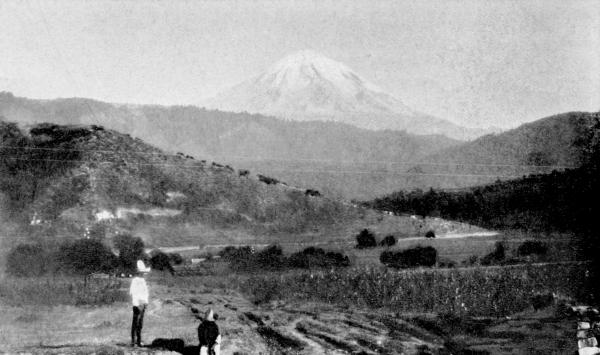
VOLCANO DE ORIZABA
When I awoke in the morning we were yet three hours from the Gulf. We had crossed the mountains in the night; we had ascended three thousand feet, and come down eleven thousand feet, through wild and beautiful scenery; a journey never to be taken by night, unless necessity demands. We were more than two hours late, having been detained at Orizaba, while we slept. This was fortunate for me, for it gave me the daylight hours to view the lowlands through which the road passes from the mountains to the sea.
Back of us, high, high into the cloudless blue
sky, glittered the snowy peak of Mexico’s greatest volcano, the lofty, mighty Orizaba, now known to be higher than Popocatepetl, and much like it in the contour of its cone; a most imposing sight as it shone in the light of the rising sun. Wherever we turned, wherever we went, mighty Orizaba followed us. We never lost sight of it, we could not escape its stupendous bulk. I am fortunate to have seen four of the chief snow-capped volcanoes of Mexico, and to have fine photographs of them all—Popocatepetl, Ixtaccihautl, Nevada de Toluca, and Orizaba.
The lowlands we were traversing are wholly tropical; we were among extensive plantations of bananas, palms of many sorts, coffee orchards, and impenetrable jungles. The sun was as hot as upon the llanos along the river Balsas in Michoacan.
It was half-past nine when the train pulled into the station at Vera Cruz. A big negro, black as night, dressed in immaculate white duck, collared me the very instant my feet touched the ground. He spoke in soft, smooth English, with marked British accent. He introduced himself as “Mr. Sam.” “I am a British subject from Jamaica,” he said, “and representative of the Hotel Metropolitán.” He offered to conduct me to that institution. He assured me it was “the finest establishment upon the coast.” As that was my predetermined destination, I permitted him to precede me there, carrying my bags. The sun was fierce, the atmosphere dull and heavy. We walked through filthy streets, streets never yet cleaned in all the four-centuries’ life of Vera Cruz. The ill-paved and stinking gutters were filled with slime. The streets were bordered with low-built stucco houses. We entered an ill-kept plaza where grew lank bananas and cocoanut palms, a low government building with a graceful tower bounding its eastern side. Here we came to the hotel, an old stone edifice two stories high, with a loggia overspreading the sidewalk, and a curtain hung between the pillars and the street to keep the hot sun from the footway which ran beneath. “Mr. Sam” instructed me in what I should have to do. First, I must follow him to the American doctor, and in the presence of the American Consul, procure a certificate of health. Then he would take me to the “Fumigation Office” of the Mexican government to have my baggage examined and certified as free from yellow fever and contagious disease. Then he would take me to the office of the Ward Line Steamship Company to have my ticket, which I had bought the day before in the office of the company in Mexico City, examined and certified, and then he would arrange that “The Express Company,” for a stiff fee, should convey my through
baggage from the station of the railway to the steamer Monterey, lying at anchor out in the open Gulf, although the day previous it had all been checked through from Mexico City to Havana. Later, he himself would row me out to the vessel and put me in my stateroom, free from further molestation of red tape. “Mr. Sam” proved himself true, extracting from me, however, sundry centavos along the way. He did not intend me at any time to escape. Nevertheless, I did shake myself free from his superintendence for one short hour, and strolled alone about the ancient town. It is a city of filth, stinks, and squalor—just the home for the perpetual breeding of pestilence. It is no wonder that the plague of yellow fever has for centuries stalked remorselessly in its midst. But the Mexican Government, stimulated by the example of the scientific cleanliness of Cuba, is now laying a modern sewer system, and has employed English engineers to construct extensive dock facilities, and is transforming Vera Cruz into a clean and modern city. There is thus hope for both the health and the commerce of Vera Cruz.
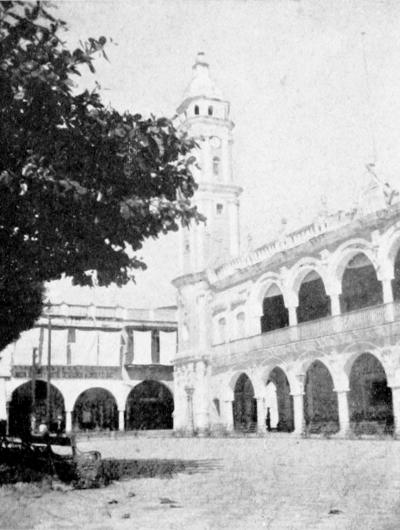
THE MUNICIPAL PALACE—VERA CRUZ
I visited the famous cocoanut palm grove in the Alameda Park, and seating myself upon one of the stone benches, watched the flocks of tame vultures which abound in Vera Cruz, and are the regular street scavengers of the town. Protected as they are by city ordinance, they run about like flocks of chickens. They scarcely move aside for the passer-by. There is not much of interest in Vera Cruz, although the city contains several ancient churches, Spanish towers, and one mediæval fortress, built in the early period of the Conquest.
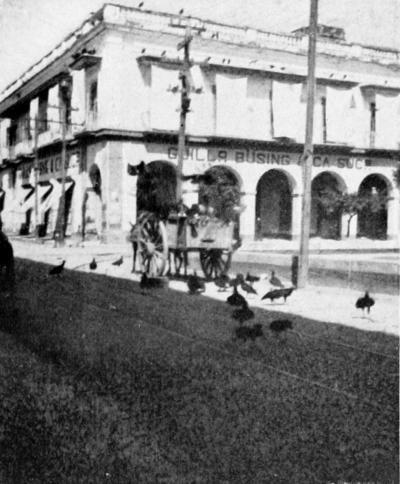
THE TAME VULTURES OF VERA CRUZ
After lunch at the hotel, where I was sadly overcharged, “Mr. Sam” rowed me a quarter of a mile to the steamship Monterey. My baggage was brought out by the “express company” in a lighter along with that of other fellow-travelers of my train, and although we were through passengers from Mexico City to Cuba and New York, yet extra charges were made for this necessary service, an evident extortion.
I had reached my ship about half-past three in the afternoon; we were scheduled to leave at four; we did not sail until long after the appointed hour, so slow is the “lighterage” process of taking on cargo. The largest vessels can lie at the new piers, but either to save port charges, or, as they claim, “to avoid the possibility of yellow fever,” these boats anchor far out in the harbor and compel all passengers and freight to be brought on board.
Our motley cargo included sheep and cattle for Havana; a menagerie, lions, tigers, monkeys, and an elephant carefully hoisted and standing in a specially constructed crate in the forward hold, un
easy and swaying his body in great terror; and also many and divers crates and bales of merchandise.
We carry a large company of cabin passengers for Progresso, the chief port of Merida, in Yucatan. Among them I have noticed a group of gentlemen who upon the train seemed to be suffering greatly from the cold. I learned that they are rich planters from Merida. One is a senator in the Mexican National Congress. He is a large, thick-set man, with high cheek bones, blue eyes, light-brown hair, a white man much burned and browned by tropical suns. I thought he might possibly be a German or Scandinavian. Imagine my astonishment when I am advised that he is a full-blooded “Yucataka Indian!” He is one of that strange tribe of blue-eyed, light-haired people, whom the Spaniards never conquered, and whom the Mexican government have never yet been able to subdue, and in recent years have only been won over through Diaz’s subtle diplomacy. Whence came this tribe is one of the unsolved riddles of history. Possibly some Viking crew, drifted far out of their northern waters, may have been the forefathers of this blue-eyed, unconquerable race.
We are weighing anchor. The propeller blade begins to turn. On our port side rise the white walls of San Juan de Ulloa, the famous fortress and now state prison of Mexico,—an island of itself,—within the cells and dungeons of which yellow fever perpetually removes the imprisoned wretches sent there to die.
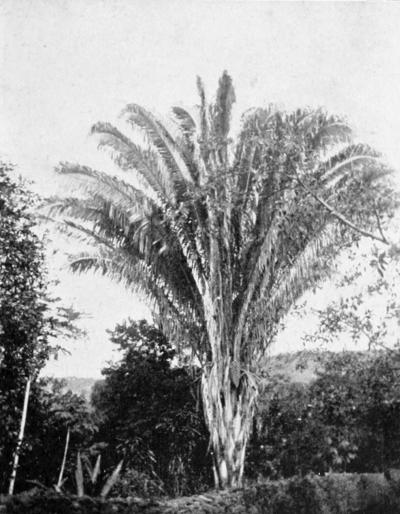
A NOBLE PALM
To starboard lies at anchor the Mexican navy—a small-sized tug. Our voyage to Cuba is begun.
XIX
Voyaging Across the Gulf of Mexico and Straits of Yucatan from Vera Cruz to Progresso and Havana
Steamship Monterey, at Sea,
December 21st-24th.
It was late in the day when we set sail from Vera Cruz. The shoreland faded; the grove of cocoanut palms in the Alameda with their feathery tops waving in the evening breeze, were the last green things I saw. As the sun sank suddenly behind the great volcano, the western horizon was filled with golden and scarlet and purple coloring, and Orizaba’s summit was flooded with roseate splendor. The stars burst out, the moon crept up from the dark waters. We were on the Mexican Gulf, and the tropical heavens glowed and burned with a brilliance unknown to the latitudes of the middle north. The waters, churning in our wake, flashed and glowed with the phosphorescence characteristic of tropic seas. The wind freshened and, by the middle of the night, the knowing ones hinted that more than the usual commotion of the sea might be expected before the dawn. In fact, a cablegram had been received, sent from Galveston, warning us that a “Norther” was on its way.
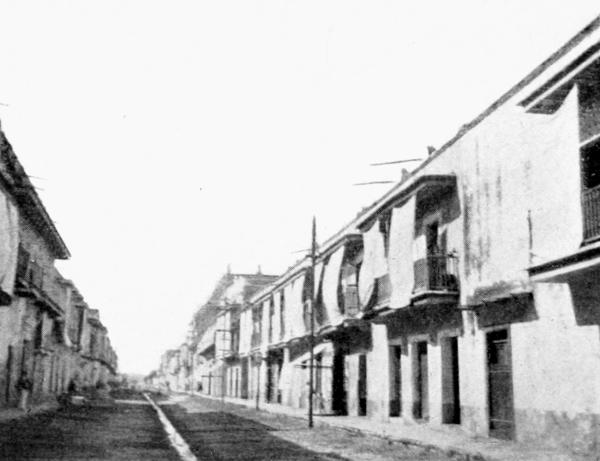
A STREET OF VERA CRUZ
I sat up till late, enjoying the rising gale and drinking in the delicious air.
After so long a sojourn upon high, dry, parched land, it was a delight to be again upon the sea. The restless waters tossed our sturdy boat as though it were a cork. I slept soundly, despite the rolling of the ship and the hammering of the surging billows against the shell of my cabin, and I was among the first to respond to the six o’clock bells summoning the hungry to their desayuno. These vessels follow the customs of the majority of their passengers and serve meals in Spanish fashion—desayuno from six to seven—coffee and rolls to whosoever may care to partake of them—and, about ten o’clock the almuerzo, the regular breakfast, a hearty meal; then the comida, the middle of the afternoon; while later between seven and eight o’clock cena is served, a light repast, a cross betwixt the English tea and supper.
All day the wind blew steadily from the northwest, and the Mexican travelers spent most of their time doubled above the rails like bended hairpins. During the afternoon the gale increased. Great banks of cloud, black and ominous, rolled down upon us, and, toward the close of the day, torrents of rain descended. Few passengers, by this time, remained upon the decks, and the group who gathered with the captain at the evening meal could be counted on the hand. As night drew on the winds boomed louder and terror took possession of the unseasoned landsmen from Yucatan. But I felt no symptoms of seasickness, and the splendid sea-strength of this vessel gave me a sense of safety and repose. I wedged myself into my berth, so that I might not be thrown out, and lulled by the roaring of the storm and the rolling and plunging of the ship, fell peacefully asleep. When I at last awoke, the sun was long up, and the clouds were mostly drifted to the south. We were double-anchored in the open roadstead off Progresso, four miles from the shore. South of us, all along the coast, we could see the crests of the gigantic surf beating upon the sandy marge of Yucatan. No boat of less strength than our own, might dare to ride out such a storm; no vessels can venture to us from the shore until the waters subside. There are no harbors along the entire coast of the Yucatan peninsula. The only ports are Campeche and Progresso, and ships must lie three or four miles out in the open sea and passengers and freight must be taken on and off in lighters, greatly to the disadvantage of commerce. Above the white lines of the foaming breakers, we can see the tops of the waving cocoanut and royal palms, and between them the white buildings of Progresso. Back of Progresso, some thirty miles, lies the city of Merida, but a few feet above the level of the sea, the commercial center of the world’s heniquen or sisal grass trade. An enormous export business in this grass has sprung up since the beginning of the Philippine war, when the Manila hemp trade fell away. Natural conditions here favor the growth of the fiber, it increasing with little cultivation and great crops being raised. Millions of dollars have been accumulated in late years by the fortunate planters of Merida, and no city in Mexico has so suddenly advanced in wealth.
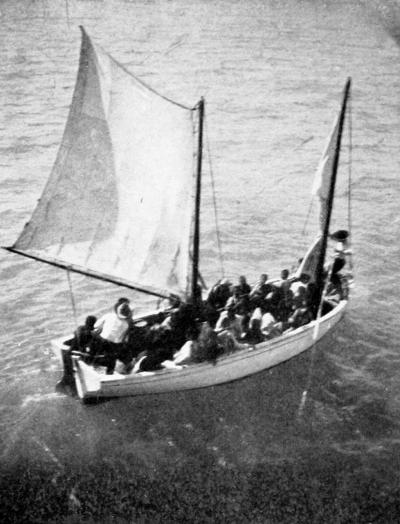
THE LITTLE BOYS LEAVING OUR SHIP
During the afternoon we saw our first shore-boats, and we are promised that to-morrow, even though it be Sunday, the cargo shall be taken off. Two small boats have ventured out, and into one of them have been thrown the mails which an awaiting train will quickly take to Merida, but until morning no passengers will be permitted to go ashore, nor will any freight be landed.
To-day we have seen our first sea birds, and a very few flying fish, while, since early dawn, there has traveled around the ship a continuous procession of sharks, their sharp dorsal fins constantly showing above the waters. Some of the passengers have been fishing for them, but as yet none have been caught and, I am told, they are very shy. While they will accompany a ship all the way to Havana, yet so suspicious are they of the fisherman’s line that they are rarely captured.
This morning I stood looking down upon the deck next below me, watching a company of thirty or forty little boys aged from ten to twelve and fourteen years, one little girl among them, seemingly sister to one of the younger boys. They were mostly sitting in groups of four and five tossing centavos and shouting with delight. They were gambling away the few coins in their possession. A couple of sailors came up, seized two of the little boys and stood them up in front of each other. The prisoners seemed to comprehend the intention of their captors, and immediately fell to fighting desperately, until one knocked out the other, just as a couple of game cocks will go to fighting when placed in opposition. As soon as one of them had been vanquished, his sailor patron shoved him to one side, as something now quite useless, and grabbing another boy, set him in front of the victor. Then, at it they went again, and many of the children stopped their play to look on. The Mexicans about me were betting on the fights and apparently enjoying the pastime. I inquired who were these children, and learned them to be a company, who had mostly been stolen from the streets of Mexico and neighboring towns, and was told some had been bought from the state orphan asylums, at ten dollars a head, upon the payment of the price no questions being asked as to their destination. They are being taken into practical slavery to be speedily worked to death by the heniquen planters of Yucatan. They are delivered to the plantations and there perish rapidly from poor food, harsh treatment, yellow fever, and the bites of insects which burrow into their unprotected legs and arms. They are said to die off like flies, the effort of the buyer being to get out of them his money’s worth in work before they die. The children know nothing of their fate, until they are delivered to their death. The little fellows before me were in great glee through all the voyage; each had been presented with a few silver coins, the first many of them had seen in all their lives, and the joy of possession set them to gambling merrily all the day through. This traffic in children is said to have been long established and to be winked at by the Mexican authorities. Later on, we watched them climb down the side of the ship and enter the lighters, shouting with glee at the prospect of going to “the lovely new homes in the country,” where their captors pretended, would be their journey’s end.
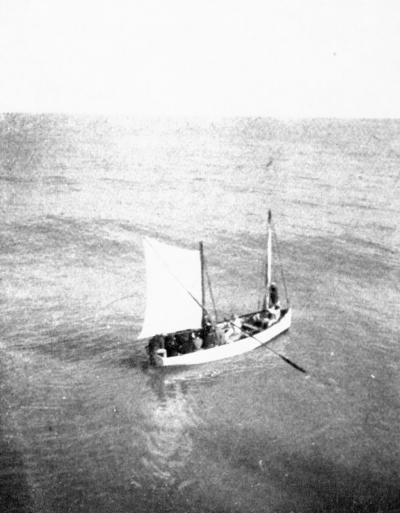
OFF FOR PROGRESSO
It was late Monday evening when we set sail from Progresso. All day long we were discharging cargo into the lighters, which swarmed around us, while after the passengers and cargo departed larger vessels brought out bales of heniquen, which were quickly stowed below.
Among the passengers who left the ship, were several Americans. One, a large, redheaded, heavy-set man, with genial face and friendly manner, from Mississippi, was a timberman, out buying mahogany in the forests of Yucatan. He told me that Americans are purchasing all the available mahogany now standing in the accessible Mexican forests, and he seemed to regard the mahogany of Yucatan as of especial value. Another of the passengers leaving the ship was a man of small stature and clean shaven. He early attracted our attention by his sanctimonious air, and the frightfully fluent American oaths with which he spiced his games of poker in the smoking room, where in company with a group of flashily dressed and bediamonded Mexicans, he played apparently for the highest stakes. The contrast between his smooth exterior and the noisome contents of his mind, as well as the fact that the two or three hard-faced Mexicans who seemed to have in charge the company of little boys, constantly sought him out in consultation, led to the suspicion that he was the chief trafficker in this death trade. In response to our questioning as to his antecedents and business, he became abusive, and upon my taking his picture with my kodak, he grew angry and afterwards fought shy of all intercourse with his fellow-countrymen. As to who he may really be we know not. When the little boys departed from the ship, we noticed that he also sailed away.
The sun was just sinking, like a ball of fire, into the margin of the western sea, when we weighed anchor and steamed eastward to cross the Strait of Yucatan. The surface of the waters lay calm and quiet as a sheet of glass. We were two nights and a day in reaching Havana, and the one day was spent in crossing the Strait.
Most of the afternoon I have sat or lain upon the forward deck watching the waters and observing the sea life everywhere about me. We have passed innumerable flocks of flying fish. Here and there a few porpoises have tumbled and wheeled about us, but the sharks have disappeared. Also, I have caught sight of my first nautilus, so daintily sailing its convoluted shallop upon the sea. These exquisite shell-fish I have never before seen alive, and I have watched them with keenest interest. They appear only when perfect calm prevails. At the least roughness of the sea, they instantly sink from view. We have also all day been passing through extensive masses of yellow gulf weed, such as I have noticed when traversing the Gulf Stream on transatlantic voyages, only here the weed was in great masses, not yet having been broken up by the tempestuous ocean tides. But we have been accompanied by no birds.
As we drew further eastward the air grew more soft and balmy. We were utterly alone, no craft other than our own appeared anywhere upon the waters.
I fell asleep watching the big stars and dreaming of Spanish galleons and British buccaneers, of Portuguese pirates and French marauders, whose adventurous sails have in the centuries gone by whitened in countless multitudes these now silent seas.
When morning broke, the shores of Cuba bounded the horizon on the south, ten or fifteen miles away. Low sandy reaches stretched along the sea; palms, tall and feathery, were waving in the morning breeze behind the white ribbon of the strand, a faint blue line of mountains lying yet beyond. As we approached the island there seemed to be no break in the coast line, but farther on we discovered a narrow channel, between the fortress of El Moro and the city of Havana and, entering it, came into a harbor, landlocked and storm free, one of the securest in the world. We cast anchor near the projecting rusted wreck of the United States Steamship Maine. I had finished my voyage. I was here to go ashore, while a few hours later the Monterey would turn northward and sail on to New York.
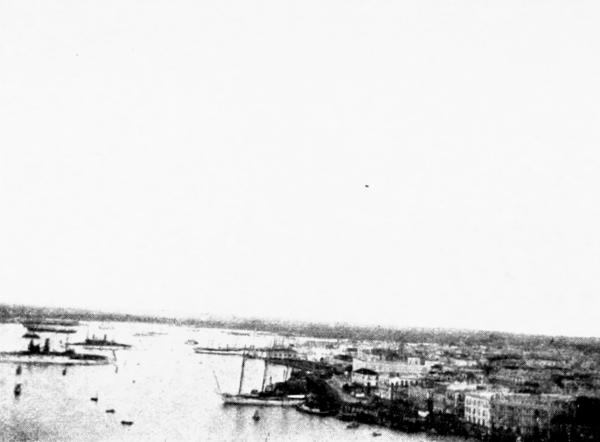
THE HARBOR OF HAVANA
XX
The City of “Habana”—Incidents of a Day’s Sojourn in the Cuban Capital
Habana, Cuba,
December 5th.
“Habana,” says the Cuban and Spanish mouth, and the b is so gently uttered that you cannot tell it from a v.
Yesterday morning, Tuesday, we cast anchor beneath the ramparts of the great fortress of La Cabaña (Cabanya) in the wide landlocked bay; many other ships swung to their moorings in the quiet waters, among these the battleship Massachusetts and two cruisers, Kentucky and Kearsarge, of the navy of the United States.
The harbor of Habana, you will remember, is a mile or more wide and nine or ten miles long, capable of accommodating an extensive shipping. Now, since it has been dredged and cleaned of the accumulated filth of centuries, the largest boats may come up to the docks and sea wall along the city’s marge. The larger vessels, however, just as at Vera Cruz, still prefer to anchor out in the bay, and send passengers and freight ashore by means of tugs and lighters.
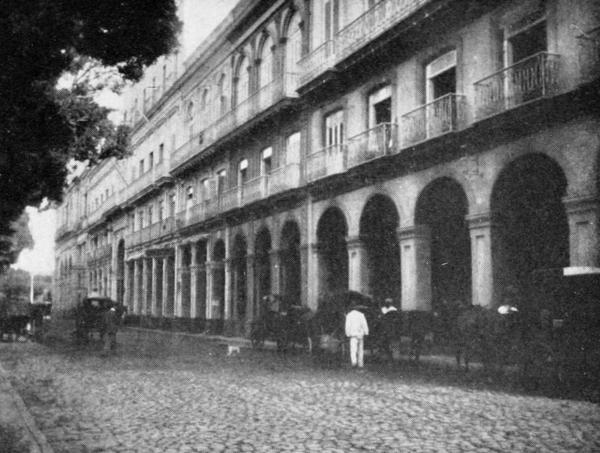
A SPANISH HOTEL—HAVANA
We were scarcely moored, when a multitude of small boats surrounded us, all apparently offering to ferry us to the city. We ignored their clamor and clambered aboard the large steam tug to which our baggage was also transferred, and were quickly landed at the customshouse.
My two steamer trunks and big basket of Mexican pottery I left in care of the customs officers, and came up into the city with only a valise. The customshouse is a long, low, stone building, with an iron fence shutting it in and enclosing also an extensive paved storage yard. The Cuban officers, who were very polite, are yet under the military control of the United States and of General Wood, and they all spoke English fluently.
Passing out through the great iron gates, we signalled for a cochero, when half a dozen galloped up gesticulating and vociferating eagerly. We choose the cleanest-looking cocha of the lot, a curious ancient vehicle, which seemed to be a cross between the German fiacre and a Parisian voiture. Into this three of us climbed, when we set off on a gallop through narrow streets up into the city, halting at last before the Spanish-kept Hotel Pasaje. It is big and airy, and I have a room at the top where I can catch any breeze which may be blowing. The floor of my chamber is tiled; it is fitted with an iron bedstead with wire
mattress, and neat American cottage furniture. An electric incandescent lamp dangles from the ceiling, and there are two large sashless windows with slatted Venetian curtains which may be let down to shut out wind and light. My first view of Habana was from one of these windows. I looked out over a city of flat roofs, where much domestic labor was carried on, and then beyond, across the palm-ornamented plaza and along the beautiful Prado to the sea.
My first commercial transaction was the purchase of really fine cigars at a most reasonable figure; and then a packet of postal cards illustrated with views of Cuba. Down in the corner of each card was the legend, “Made in Detroit.” When I called the attention of the Spanish salesman to this fact, he declared “there is no such place as Detroit,” and “undoubtedly the words are the name of the Spanish artist who designed the cards!”
Leaving the hotel, I sauntered toward the Plaza Grande, an open square of several acres, traversed by gravel walks, and shaded by many Royal and other graceful palms; and then crossing it I came to the Prado. “Muy bonita esta el Prado,” (very lovely is the Prado), is the common phrase of every Habanista; and rightfully are the Habanese proud of their splendid parklike boulevard.
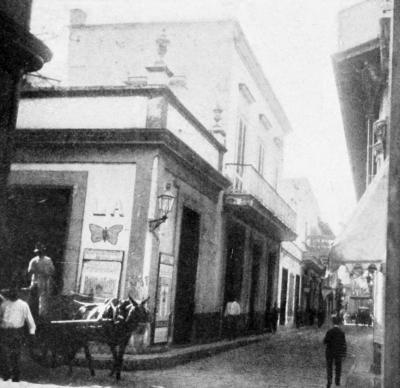
CALLE OBISPO—HAVANA
Habana is built upon a low, broad-topped hill, which descends gently to the water side. On the flattened crest of this hill is the Plaza Grande, and from the Plaza down to the sea, a mile or two in length, stretches the Prado;—a wide boulevard on either side of a broad green strip of park, where a walk-way passes beneath a double row of ancient and umbrageous trees, and comfortable seats are placed at intervals.
It is on the Prado that the fashion and beauty of Habana drives and promenades and lingers to see and be seen of all the world. Along its borders, on either hand, are built many of the noblest mansions of her merchant and planter magnates. To have a residence upon the Prado is to command respect.
The Spaniard and Cuban cared little for his streets, but he devoted himself with lavish attention to beautifying the interior of his home. Hence, in the Cuban as in the Mexican cities, you often pass along between bare uninteresting walls, while the costliest marbles, the richest fabrics, the rarest paintings within, quite hidden from all curious eyes, may be collected.
Later in the day I wandered through the shopping districts along the famous Calles Obispo and O’Rielly, streets so narrow that during the heat of the day they are wholly overspread with awnings while wheel traffic must go down O’Rielly and up Obispo. Here are gathered in plain unpretentious buildings many sumptuous shops. The Cuban has not yet learned the art of window display; he is not up even to the Mexican in that. But once you are within and know what to ask for, beautiful fabrics and expensive goods are shown you without stint. Among other shops, the hat store holds an important place in Cuban as well as Mexican life. In Mexico, the sombrero, costly or cheap, marks the social status of the wearer and, just so, here in Cuba the quality of your panama determines the amount of consideration which you receive. I entered the Hotel Pasaje wearing a modern American felt hat, and when I bloomed out in a really good panama, the clerks and servants treated me with markedly increased respect. In the same way, when you enter a shop, the clerk sizes up your hat and treats you accordingly.
A noteworthy thing about Habana is the great number of cigar stores. No city in the world possesses so many. Nor are the cigars there purchased to be surpassed. Every one smokes cigars in Habana. The cigarette holds the inferior place. The men smoke cigars; the boys smoke cigars; even many of the women smoke cigars. In Mexico, in the hotels and railway cars, the ladies were usually smoking cigarettes. Here in Habana delicate feminine lips close tenderly upon el segaro.
There is also much fruit sold at little stands along the street curbs and at the corners, but in nothing like the quantity or profusion seen in the Mexican cities, nor have I met any dulce boys with trays of candied fruits upon their heads.
There are two chief markets in Habana; one is by the water side, where the fishermen come and where I was greatly interested. There were the splendid red-snapper—which I saw in the markets of Mexico fresh from the sea,—a large handsome fish of deep-red color, weighing five or six pounds; and multitudes of sorts I did not know. The other, a large market where flowers and fruits and vegetables are sold is on the hill a mile or two from the sea.
The vegetable gardens in the outskirts of the city, are in the hands of the Chinese, who bring the vegetables to the markets where they are sold by the Cubans. They work the gardens just as they would in Shanghai, in Canton, in Pekin; they have come over from China direct; they already control the greengrocer trade of Habana, and are said to be fast growing rich.
The markets are neither so large, nor so abundantly supplied as those of Mexico City, where the fruits and vegetables of the temperate highlands, and also those of the tropics are offered in the same stall.
It was the day before Christmas when I visited the larger market, and the chief interest of the buyers seemed to be centered in the display of live and suckling pigs. It is the custom of the Cuban to celebrate his Christmas with a royal banquet of roast pig. So the housewife selects a “live and squealing dinner,” ties him together by his four legs and with a cord slung across her shoulder, carries him home, lustily vociferating beneath her arm. I saw few pigs in Mexico, only an occasional hog or shoat, lean and wild, scampering along the wayside in Michoacan; but here, in Cuba, the pig is el gran Señor.
The crowds gathering in these markets were in strong contrast to those of Mexico. Here, were none of the warm brown Indian tints, but instead the yellow mulatto and the very dark Spaniard or negro. The curious thing about these Cuban crowds is that the Spanish mulatto, instead of carrying the white man’s color with the negro’s features, bears, on the contrary, the white man’s features with the darker color of his African blood, and hence, the impression created by a Cuban crowd is rather that of men having Caucasian features shaded in color from the paler to the darker hues. It is also said, that many of the darker faces have in them no negro blood at all, but are those of the descendants of the ancient Moors, who, once the lords of old Spain, have left as legacy a proud lineage and swarthy skin. To the unpracticed eye, it is almost impossible to distinguish between the Spanish negro and the “Black Spaniard.” Thus in Cuba the color line of race distinction, as drawn in the United States, becomes almost impossible. Nor does it exist. Men of all shades mingle and mix in social functions, for who can tell whether the dark face is shaded by the infused blood of the lowly negro or the haughty Moor?
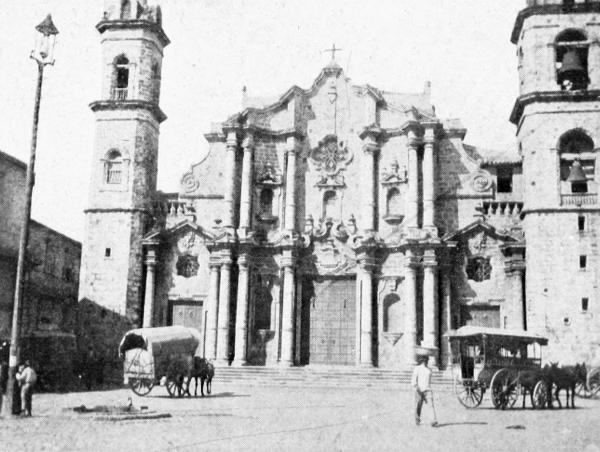
THE CATHEDRAL—HAVANA
In the late afternoon I took my way down along the Prado, and, stopping before No. 55, touched an electric bell. The door opened and I entered a spacious patio; on one side stood a modern automobile,—on the other, pots of flowering plants, and I entered a large and airy drawing room.
I might have been in my own country, for it bore the marks of modern taste. It was the drawing room of Señora —— who as Miss ——, I had known and admired in the United States. She expressed delight at seeing me, greeting me with the cordiality of an old friend. She at once insisted that I accompany her that evening to Mrs. General Wood’s private box at the dinner to be given by the citizens of Havana to the United States naval officers now here with the squadron. The dinner was to be held in the Opera House. It would be the most notable function of the year; all that was distinguished in Cuban, Spanish, and American social, military and naval life would be there assembled. I was a passing traveler, and my white duck trousers and blue flannel coat were scarcely the costume to wear among so brilliant a company; but it was the best I had and what better could I do than accept? My hostess’ husband, as one of the receiving committee, must be separated from her and my escort would stand her in good stead.
A few hours later we were ushered into the big theater, and shown with much ceremony to the private box of the wife of Cuba’s Military Governor. Here were gathered Mrs. Wood herself, the wife of Admiral Converse, and the ladies of their entourage. The scene was splendid. The spacious Opera House, built by the Spaniards with their appreciation of pomp and ceremony and brilliant functions, was filled with a distinguished assemblage; from floor to lofty roof were tiers of boxes, and these boxes were occupied with the beauty and fashion of Cuba. The great parquet of the theater was floored over and upon this space were set long tables. The dinner had already some time ago begun. The company there gathered were nearing the hour when toasts are offered. Young Señor Garcia, son of the Cuban General, was Toast Master of the occasion. On his right sat General Wood; upon his left the Archbishop of Santiago, in rich and gorgeous robes, the first native Cuban priest to reach that high dignity. The American naval and military officers were in full dress uniform, and the Cuban Generals were brilliant in warlike trappings and gold lace. The civilians wore dress suits, and I was conspicuous as the only guest of the evening in white duck and blue flannel.
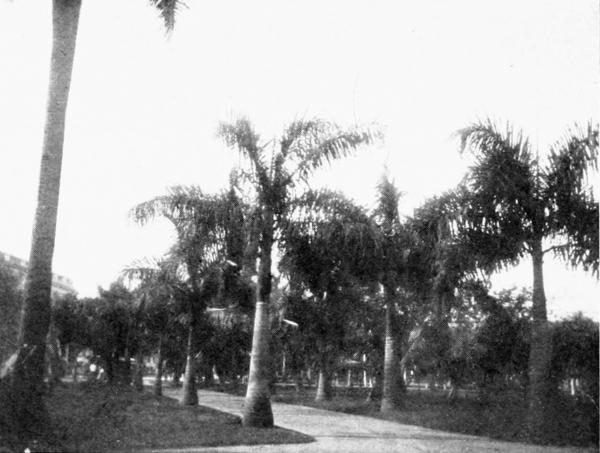
THE FIRST GREENSWORD—HAVANA
The speeches were in Spanish and English, and great enthusiasm and good fellowship prevailed. In the course of the evening, most of the gentlemen present came to pay their respects to the wife of Cuba’s Governor, and I had the good fortune to be introduced to the greater part of them.
The sentiment between the Cubans and the Americans is now most cordial, or, perhaps I should say, between the governing and more cultivated Cubans and ourselves; for among those whose knowledge of the United States is gathered chiefly from contact with a soldiery, not altogether courteous in enforcing order, there is little good feeling, but rather a sense of sharp antagonism, which, though usually suppressed, nevertheless now and then crops out.
After the dinner and the closing of the function, I wandered out beneath the stars along the Prado and through the Plaza Grande to my hotel. The streets were yet alive with people, although it was late. In the great square the band had not finished its nightly concert, and the chairs which, in Havana as in Mexico, are rented to the public, were yet well-filled with those who lingered to enjoy the music and the cool night air.
Continuing my way homeward, I caught the distant hum of voices and an occasional shout. The sounds grew nearer. Looking down the Prado, I beheld many moving lights. Then a band began to play. A procession was approaching. I paused to watch. First came a band, men in smart uniforms; following these were men on horseback, some in uniform, some in civilian dress. Then came several other bands, and men and boys on foot carrying banners and lanterns and illuminations. A multitude was marching through the streets. Every now and then they shouted the name “Masso, Masso,” and broke into vivas and bravos. At the Hotel Pasaje they halted and renewed their cheers and cries, the wide street becoming packed with the pressing mob, a cheering crowd, mostly dark-faced. The procession was a demonstration in behalf of Masso by the followers of the “Massoista” party. He is the candidate they would elect to the Presidency of the Cuban Republic in opposition to Estrada Palma.
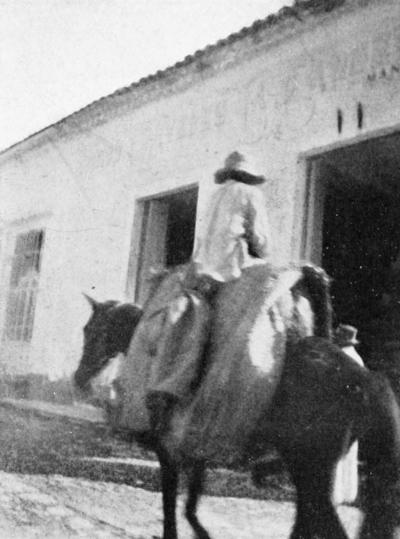
SELLING VEGETABLES—HAVANA
On the afternoon of the following day, I was riding on the tramway in company with a friend, toward the suburbs on the hill, when a tall and courtly Cuban came toward us. He took a seat next to my friend and after a few moments’ conversation, turned to me and said in perfect English that he had noticed me the night before in the box of “Señora General Wood,” and, “that he had remarked me for a stranger in Habana.” He said that he was shortly to leave the car, and asked whether we would not like to visit an old Cuban mansion, in order to see how people in Cuba lived in the style of the old regime.
Knowing the gracious manner of compliment habitual among the Spanish peoples, I was going to thank him for the proffered courtesy and decline; but my American friend, to my surprise, promptly accepted the invitation. We left the car in company with our guide, Señor ——, who belongs to one of the oldest Cuban families of French descent,—and is a lawyer of distinction.
We approached a stately residence built of white marble, a series of high marble pillars before a marble portico running along the front. We passed through a small gate within a larger one in a high, wrought iron fence, through a small glazed door in a large doorway and came into a high, wide drawing room, extending across the front of the house. All was white marble,—the floors, the wainscoting, the doorways;—there was no woodwork anywhere. Handsome rugs lay upon the floor and French rattan furniture of easy shapes was scattered about the room. At one side we entered another lofty chamber, similarly floored and wainscoted, used as a ladies’ boudoir, and thence passed out across a wide piazza, into a beautiful and well-kept Spanish garden. The walks were carefully laid out, the beds were full of blooming plants—there were many palms of different varieties, and a marble bath house with running water and a large swimming pool. Beyond the flower garden, we entered a vegetable garden, close to which stood a commodious stable; then returning to the house El Señor asked whether we would like also to see the kitchen. We were shown into a big square room, in the center of which stood an octagonal blue-tiled “stove,” about ten feet across at the top, and four feet high, a sort of porcelain table, containing many niches wherein to build small charcoal fires, a single fire to cook each separate dish. An old negro servant, a freed slave, was preparing the evening meal. We next entered the large dining room, with old mahogany furniture, a long table for banquets, and at one side a small table already set for the evening meal. There was much handsome silver and cut glass upon the high, old-fashioned mahogany sideboard. From the dining room we passed into a library, the shelves filled with French and Spanish and German and English books. Here the father of my host, an eminent judge, had gathered about him much of the world’s choicest literature. Then we came out into the wide patio, square and open to the sky, a fountain playing in the middle, and many potted palms and flowering plants set round about. The great house was of one story, and all rooms opened upon the central court. None of the windows were sashed with glass, and Venetian blinds kept out the light and too much air.
Here, in this sumptuous home lived for half a century one of the distinguished families of Havana; here now were living the grandchildren of those who built it.
Our host then led us up to the wide flat roof, whence stretched out before us a panorama of the city, the bay and the open sea.
My friend, who had long lived in Havana, holding a prominent post in government employ, had never before enjoyed the privilege of inspecting so beautiful a Cuban home. As we parted that evening he turned to me and said, “Perhaps the white duck trousers and blue flannel coat, which were so conspicuous last night in the box of Cuba’s Governor General, are to be thanked for this opportunity now come to both of us.” El Señor had been pleased to show a courtesy to the guest of the first lady of the Island.
Neither the great cathedral of Havana, nor any of her churches, nor the honored chapel where Columbus’ bones are supposed to have lain, nor any of her public buildings, not even the “Palace” of the Spanish Captain Generals, are of so striking and splendid architecture as one sees generally in Mexico. The allurement and dazzling fame of the Empire of Montezuma attracted thither all that was daring and forceful and brilliant in old Spain. Even the wonders of Cuba and the Antilles paled before the tales of fabulous wealth and treasure of the conquest of Cortez. The noble churches and architecture of Mexico have no rivals among the Cuban cities. Nor is there among the Cubans that picturesqueness in garb, that striking brilliancy of coloring, which one sees upon the streets of the Mexican cities. In Cuba you see no scarlet and green and blue zerapes; no purple and blue and pink rebozos; no rancherros and caballeros in velvet jackets and tight-fitting trousers, laced and spangled and buttoned with threads of silver and gold; none of the splendor in coloring and dress of the sixteenth century, which still clings to the street scene in Mexico. Cuba in its outward aspects is distinctly, unromantically modern. The black coat is de rigueur; the black hat or the panama is the only covering for the head, and even conventional millinery has begun to drive away the graceful mantilla from the brows of las señoras. There is no poetry, no artistic coloring in the life scheme of the Cuban. His face and movements lack the vivacity and alertness inspired by the keen, quickening air of the Mexican Highlands. Even the clothes he wears and the way he wears them bespeak the heavy, sea level atmosphere he breathes. Nor has the language of the Cuban preserved the ancient grace and forcefulness which distinguish the almost classic Spanish of the Mexican. The Spanish spoken in Cuba has added to its vocabulary a multitude of words from the French and English of its neighbors, and from the provincial patois of the formerly numerous Spanish soldiery.
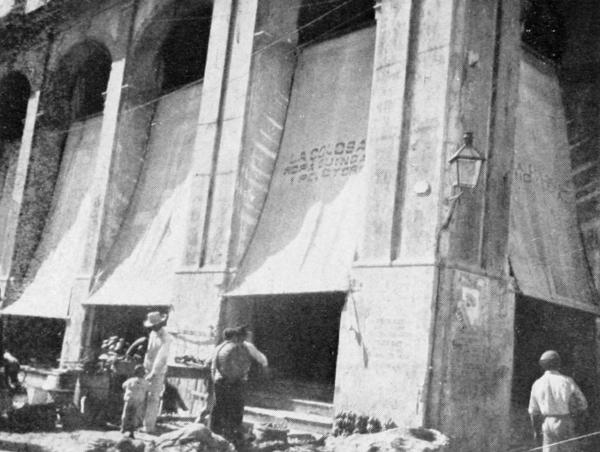
A CORNER OF THE MARKET—HAVANA
Another time we rode out to the attractive suburbs of Vendado, where are many fine houses and extensive gardens, the greater part of them built in the old Spanish style, but some of the newer buildings after the fashion of modern American architecture. These last are less attractive than those which the Spaniard has evolved from his centuries of living in the latitudes of the tropics.
XXI
Cuba—The Fortress of La Cabaña
Havana,
December 2nd.
The candle end Captain MacIrvine held in his hand had burned so low that his fingers were scorching. My last match was burned up. We should have to grope our way out. Just at that moment a dim flicker of a distant light gleamed far down the low, narrow tunnelway. It came nearer, it grew larger; a man was there,—a soldier—yes, a Cuban officer, a lieutenant of infantry. With him were two ladies; one older than he, whose face, sweet, but oh, so sad! was furrowed with deep lines. Her hand trembled on her escort’s arm. The other woman was younger, quite as young as the lieutenant, and comely to look upon. “Si, Señor,” replied the lieutenant to a query, “I do have one box of the match. Take of them one half. Take of them all. I do know the way out.” He handed MacIrvine a box of small wax tapers. Tears were streaming down the elder woman’s face; the younger gave a sob. The three passed on and turned up the steep ascent to the left. We were in the pitch dark again.
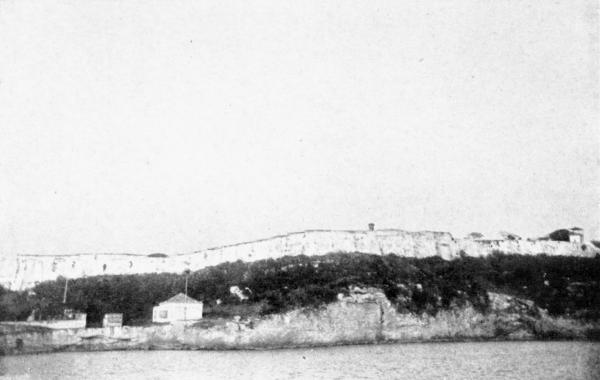
FORTRESS OF LA CABAÑA
“Who is he? Who are they?” I asked. “He is the officer now in command of this fortification; they are his mother and sister,” MacIrvine replied, half divining my question. “He is of a prominent Cuban family. They were people of wealth. The family were at dinner one evening. A Spanish guard called at the house, sent in a card to the father, who was an eminent judge. He left the table and went to the door. He was arrested and brought here, hatless and in his slippers. When the family went to ascertain why he did not come back to finish his coffee, they learned that he had been taken to La Cabaña. They never saw him again. The Spanish authorities reported that he had ‘escaped.’ In fact, he was brought down here into one of these dungeons, and was walled up alive. These loose rock walls you are now looking at, filling these low arches along this passageway, all tell the same tale. Behind every one of these walls, one or more Cubans have been immured alive. Their bones still rot there.”
When a man was walled in, no record was kept of the dungeon; the guards were subsequently changed and often sent to another fortress. No one might know the victim’s burial place, where he was immured with only a jug of water, a loaf of
bread; and the rats robbed him of half of these. Oblivion in life, oblivion in death.
We were in the deepest, darkest dungeonway of the gigantic fortress, La Cabaña, which crowns the height across the bay from Havana. The passage was about four feet wide. Along one side were narrow, low arches, some three feet in span. Most of these arches were wholly filled with a wall of large loose rock. Air might pass through between the chinks, and the rats and lizards could crawl through; an empty rat, not one full-fattened on the dead within. A few of these walls had been torn down, and the scattered bones which sharp teeth had not destroyed had been utterly gathered together and buried in the beautiful cemetery of the city. But most of these walls were yet untouched, the story of their unknown dead forever lost. My foot hit something, I bent down and picked up the tibia of a human arm; the rats had dragged it through the wall. I laid it back gently on a projecting shelf of rock, my soul filled with horror, at the tale of Spanish cruelty it told.
We were a long way from daylight. We had crossed a moat within the giant fortress. We had passed many cave-like chambers built into the massive masonry—the casemates where soldiers and officers had lived in ease. We had entered a small room with stone seats on either hand. It was the outer guardroom of the series of dungeons behind. We had pushed open an immense iron grating which swung on rusty hinges like a door. We had come into a vast vaulted chamber, flagged with huge stones, the center of the floor being lower than the sides, making the drain. Along the walls on either hand, all the way, at a height of about seven feet, were heavy iron rings. To these rings the prisoners had been chained. Sometimes the chains were riveted to iron collars welded about the neck. A man might stand on tiptoe in comfort. When his toes gave out the collar pinched his neck; he sometimes died overnight before the jail guard discovered that his toes were weak. Into this great chamber hundreds of Cuban patriots had been crowded. No air could enter but through the narrow grated door,—no light could penetrate but the faint glimmering that drifted in through the small outer doorway. Those who might die were brought to the grating by any of their fellow-prisoners whose fetters enabled them to move. The great chamber still stank with the reek of blasted mortality. But this was not all. At the far end of the vast room was yet another grated door, now swung open upon rusting hinges. We passed into a second chamber, lower and longer than the first, obscure with perpetual gloom. The faintest gleam of God’s sweet day could be scarcely discerned through the dis
tant door-grating of the first chamber. Here, too, men had been chained to iron rings at intervals along either side. With our lighted candle end, we scanned the massive walls and tried here and there to make out the faintly remaining legend, in faulty Spanish script, of the hapless creature who had graven here his dying word. In this remote dungeon, men were pent up to die of meagre food, of putrid water, of perpetual darkness, and of the foul hot air that crept in from the outer dungeon.
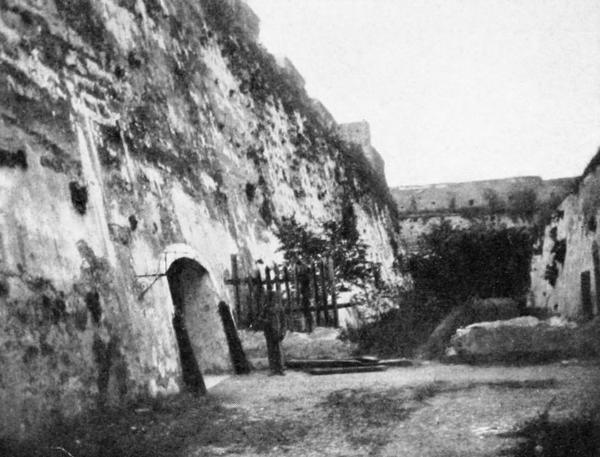
THE ENTRANCE TO LA CABAÑA
I thought surely we should have no further horrors yet to see. But Captain MacIrvine knew the way. He had been among the first American soldiers to enter La Cabaña and to discover the mysteries of these unknown and sometime forgotten dungeons. At the far end of the second chamber, he pushed open a heavy solid iron door. He entered a narrow passage barely three feet wide and so low that I had to stoop. “Mind where you set your foot. Take care of your head. Go slow,” he cried warningly; and we found ourselves going down a steep decline. The air was dank and fetid. My throbbing head was dull and heavy. Before our approach scurried a too venturesome rat. I stepped upon the slimy body of a lizard. My ear detected the retreat of hosts of scorpions as they clicked their cumbrous claws, but I heard the dismal winging of no bats; here was too deadly an atmosphere for even these to live. We came abruptly to a rock-wall, loose, but firmly set in a low arched depression. The passage widened and turned at right angles, both right and left. It was here we saw the approaching light and met the Cuban officer and the ladies.
When we found our way out to the clear, sweet sunshine again, and I looked into the blue sky arching over my head, and scented in my nostrils the fragrant breeze which swept up from the sea, and then looked up and beheld floating spotless and resplendent, above me and above La Cabaña and above Cuba, now free, my beloved flag, the flag of my own free land, the Stars and Stripes, my heart quickened. I choked a little, and I knew what Cuba and the world had gained through the blood and tears poured out by my country in order that Spanish tyranny should be forever expelled from its last stronghold this side the sea.
Captain MacIrvine and I had met that afternoon near the gateway of the customshouse in Havana, by the water side. We had taken one of the curious, blunt-ended, awning-covered rowboats, which will hold a dozen passengers, and which everywhere crowd along the quays. We had hired the old Cuban waterman for the afternoon, and bade him row us to the water stage of La Cabaña, set us ashore and then meet us at the water gate of El Moro, three hours later in the afternoon. He was brown and withered, with grim square jaw and fine dark eyes. He was a Cuban patriot. He had himself spent nigh two years in the gloomy dungeons of the fortress, his family having long given him up for dead; and all because in his secret heart he dared to love Cuba Libre.
La Cabaña is the largest Spanish fortification in the New World. It has been several centuries in growing to its immense dimensions. Crowning the heights across the bay from the city of Havana, its record of compulsory guests is a record of three centuries of the grief and agony of a race. Eighteen to twenty millions of dollars in gold have been spent upon its vast and massive walls and ramparts, its moats and fosses. Impregnable was it deemed to be by the Spanish engineers, and the United States did not have to try what its strength might be in fact. Up the narrow, slanting, rock-paved causeway from the water side to the stern stone portals of the single entrance have passed a long procession of Cuban patriots—men and women, mere boys and white-haired men; and few are they who ever came out again. They died in the dungeons by scores, and their bodies were buried in trenches, or, borne through the subterranean passage to the ramparts of El Moro, were there thrown to the sharks in the open sea. Those of lesser note who dared yet to live, were taken by platoons to a scarred and dented wall and shot to death. This spot is hallowed ground to the free man of to-day. We stood before it with uncovered heads. A little fence stakes it in, a bronze tablet is set against the bullet-battered wall of rock. The grass before us, so luxuriant, has been drenched with the noblest blood of Cuba’s patriots. The Cuban soldier guarding the gateway watched us lift our hats before the sacred and consecrated plot of martyred earth. He bowed to us respectfully as we re-entered, and it seemed to me that there was a deeper, kindlier glitter than casual greeting in his black eye.
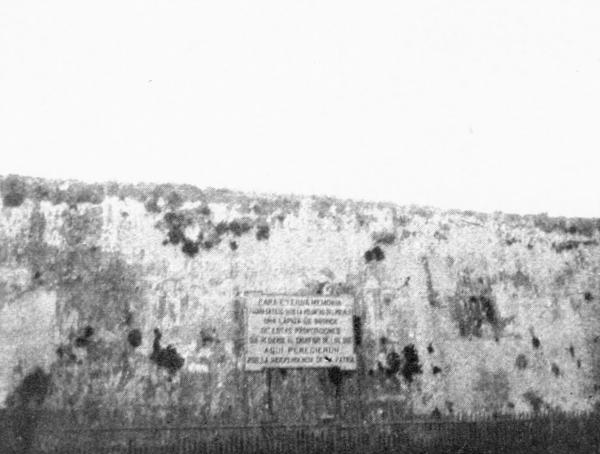
WHERE PATRIOTS WERE SHOT—LA CABAÑA
A great garrison of regular troops was always kept in military readiness in La Cabaña; now a single company of Cuban infantry occupies the fortress. Cuba free and fifty Cuban soldiers in La Cabaña; Cuba a Spanish province and fifty thousand bayonets to garrison and hold Havana down, one single town!
Many ancient guns yet adorn the ramparts of La Cabaña, the newer artillery having been removed to Spain, or, some say, sunk in the sea. The old chapel now serves for a sleeping room for the Cuban guard. The bell which tolled so often for the lost souls of the condemned is now gone. The fount of holy water is a receptacle for junk. The well-worn flight of steps ascending to the roof, no longer responds to the tread of the thousands of feet that used to press them. Right over the chapel, near the place where swung the bell, stood the garrote where, it is said, more than sixty thousand throats have been clasped and crushed by the iron grips. Perhaps nowhere in the world have so many souls been shriven as in the chapel of La Cabaña, and nowhere have so many lives gone out as by this dread instrument of death. And yet, as we stood on this high platform, with the balmy air of now free Cuba filling our lungs, and watched the Cuban soldiery pacing their beat in the park below, it seemed, in the serene and restful humor of the day, almost incredible that only three short years ago, at most but four, here had been enacted a daily tragedy of cruelty and horror which no human pen will ever be adequate actually to portray.
Back in the year 1894, when I had bought a few Cuban bonds, and in 1896, when I had raised the Cuban flag on my McKinley pole at Coalburg, I had felt in a dim way that I was doing a thing entirely right; but it was not until I stood upon the ramparts of La Cabaña, and considered the monstrous pitilessness of Spanish rule, and saw within the focus of my vision the demonstrated proof of cruelty beyond all conception in the present age,—only then, did I fully realize how God had guided the hearts and thews of my countrymen in rendering forever impossible the continuance of these iniquities.
From La Cabaña we wandered across a stretch of grassy sward a quarter of a mile, to the parapets of El Moro. Builded upon a profound rock foundation it guards the angle of the land between the open sea and the far shore of Havana Bay. Above it, as above La Cabaña, floats the starry flag. Within it resides a sturdy, clean-cut, trim-built garrison of our own boys in blue. It did me good to see them. Vigorous and businesslike they looked. Young men, well-kept, clear-eyed, expressing in their look and gait the easy mastery of the youthful, giant power whose simple uniform they wear. El Moro was never a prison fortress, although there are said to be dungeons yet undiscovered, dug deep into the rock base on which it stands. Nor is it now a fort which could withstand an attack by modern guns. But in the ancient time it was an impregnable pile, and stands to-day, a fine example of what the military art taught men to build in centuries gone by.
Most of the guns are old and out of date, notably a dozen of immense size known among the soldier boys as the “Twelve Apostles,” while just one or two of modern make poke their noses toward the city and the sea.
From El Moro we descended to the water’s edge, and finding our boatman, were ferried across to the tranquil city. The sun was sinking behind the highlands in the west; the azure sky had grown to purple all barred with gold and red. The golden light of eventide illumined the city as with an aureole. It seemed to me a hallowing benison over Cuba now forever free.
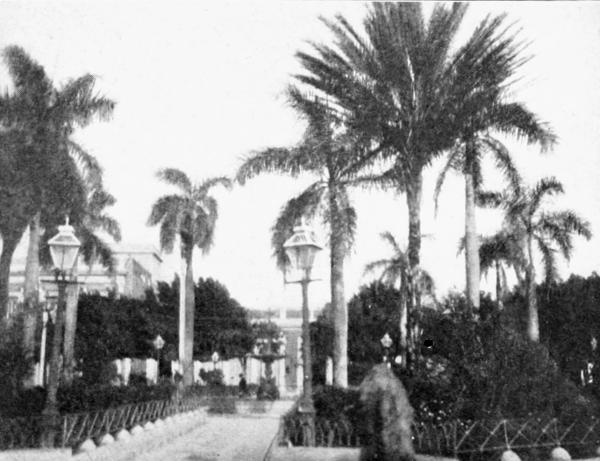
A SPANISH PARK—MATANZAS
XXII
Cuba—Her Fertile Sugar Lands—Matanzas by the Sea
Havana, Cuba,
December 27th.
A cup of chocolate, a roll, a pat of guava paste, such was my desayuno, my breakfast. Señor G——, Superintendent of Civic Training in the Schools of Cuba, had also had his morning coffee, and was awaiting me at the broad portal of the hotel. We call a cocha, bade the cochero drive us to the ferry on the bay, and were soon rattling through Havana’s narrow, rough-paved streets. It was early, not yet six o’clock. But the people of the tropics rise betimes and the busy life of the day was well begun. We could look right into the courtyards, and even into the living rooms of the houses, so close did our cocha wheel to the open doorways and to the wide-lifted curtains of the glassless windows. A young mother looked curiously through the iron bars of a window front at the Americanos. She held her laughing baby daughter in her arms. A pair of slippered feet, a coral necklace, a friendly smile, and it was clothed for the day. A family sat at a long table, each sipping the clear black coffee. The mother was smoking a huge black cigar, the father a cigar of more moderate size, the children were all smoking cigarettes. Scantily clad peddlers were crying their goods, one his back piled high with tinware. Women were carrying on their heads big baskets of fruit. An ancient jet-black African woman trudged along with a squealing shoat, tied by the four legs and slung to her shoulder. A drove of she-donkeys were standing before an open doorway; their owner was milking one of them, the buyer was standing near so as to be sure that the morning’s milk should be the real thing. The shops, however, were not yet open. It was too early for buyers. But the awnings were being spread over the streets, so as to be ready for the sun when it should wax hot.
As we approached the neighborhood of the bay, the press of footfarers in the streets increased. The narrow sidewalks and even the street itself were filled with men and women moving toward the ferry. Our cochero cracked his whip and hallooed at the crowd, and they fled out of the way, quite good-naturedly. I was trying to light my cigar, but the motion of the vehicle blew out the match. I had just struck a third. A woman on the sidewalk saw my fix. She called to the cochero and pointed to me. He stopped his horse upon its haunches. He waited until my cigar was alight, then he drove on. Such is the custom in a city where every man and woman smokes and El Segaro is the King.
At the long, low-roofed ferry house there was a great crowd, an uncommon press. We paid our cochero a peseta (twenty cents), dismissed him and strode among the thick of the throng.
In its midst were a group of gentlemen in white panama hats and white linen clothes. One of them was short and stout with gray mustachios, pointed goatee and flowing gray hair. It was General Masso, the candidate of the Massoista Party for President. I had met him the night when he made his great speech to his cheering followers in front of the Hotel Pasaje, and told them all to refrain from voting when the day for elections should arrive, “for were not all the Palmaistas scoundrels and thieves and would-be usurpers of power, backed, too, by Yankee bayonets! What use was it to vote or try to vote against such combinations for wrong and ill? No! let the Massoistas remain at home, and by the smallness of the vote cast let the world see that the real strength of the Cuban people was not with Palma, the puppet of American power, but with the real people of Cuba, whose day would in the future surely come!” And had not the assembled multitude filled the air with shouts of “Bravo! Viva Masso!” With him was Señor Hernandez, candidate for the Vice-presidency of the Massoista Party, who had also stood on a pile of boxes and stirred the excited multitude with eloquence even more intemperate. And there was also Señor Gualberto Gomez, the greatest orator of Cuba, short, stout, gray-haired, with gold spectacles—a Spanish mulatto, the real leader of the great, turbulent, Afro-Spanish race; the powerful backer of the Massoistas, who it is said, had welded the third of Cuba’s Negro-Spanish population into a solid political machine, bounden together with the secret ties of occult brotherhood. His impetuous eloquence it was which swept the Constitutional Convention, and carried the plank for universal suffrage triumphantly to victory against predetermined plans of the Conservative leaders. He would now have his following hold the balance of power in Cuba, and so rule the Island as does his race in Hayti and San Domingo! For the present, he would use the Massoistas and their pro-Spanish propaganda, later he would throw aside the Spanish following and himself rule Cuba through the power of his organized blacks. Young Garcia was there, too, the son of the great leader, discontented with the minor rôle Palma and the Americans have permitted him to play, and anxious for a Cuba wholly free from the interference of the American as well as the Spaniard. Yes, these leaders were all there, and the great square before the ferry house was packed with a cheering multitude to bid them good-bye, and Masso “God speed” on his journey to his plantation home. When I met these gentlemen before, I enjoyed free and frank talk with them, and they had made no scruple in voicing to me their policies and demands:—their determination to rule or ruin; their policy to refrain from voting and then later rise in armed revolt. This morning they were all gathered here to take a last farewell of their really loved chief, Masso, a fine old patriot with a famous war record, whom many now think that men more cunning than himself are using for their own selfish ends.
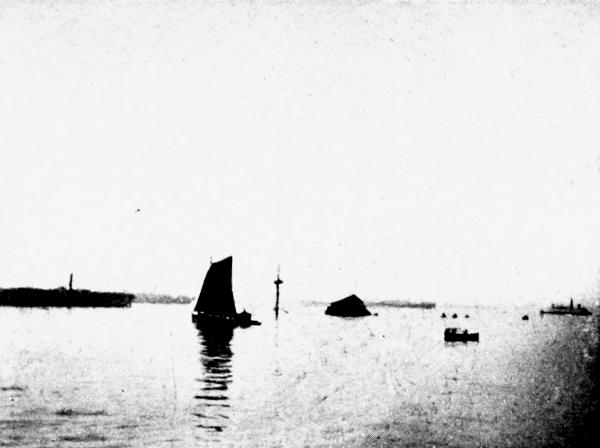
THE WRECK OF THE MAINE
The ferryboat was ancient in make and slow in movement. We were to cross the bay to the little suburb where we were to take the train which was to carry us through the rolling country and level plains of middle Cuba into the rich and fertile sugar-producing province of Matanzas.
Our track over the now clear waters of the bay led us close alongside the crushed and bended wreckage of the United States Steamship Maine, while not far beyond lay at easy anchor three mod
ern warboats of the navy, the Kearsarge, the Kentucky and the Massachusetts, a proud trio for Spanish and Cuban eyes to look upon. The wreck still lies there, its lonely foremast a mournful monument to the tragedy it marks.
The railroad runs almost due east, from the low-lying suburbs, and passes close by the village of Guanabacoa, where were gathered so many of the reconcentrados, where Spanish cruelty developed its most wanton crimes, and where yellow fever played most deadly havoc with Spaniard and with Cuban alike. We sped between rolling grass-covered hills, passing great groves of that most graceful and stately of tropic trees, the royal palm, large plantings of luxuriant bananas, and many cocoanut palms as well. The country was more flat than toward the west, and soon we were moving through wide reaches of the feathery sugar cane. There were miles of it, leagues of it, and all taller and more robust than the cane I saw while traversing the sugar lands of Louisiana.
In the black, deep and wonderfully fertile soil, the cane grows without care or heed. Here the cane once planted need not be reset for full twenty years, and the stock may be cut at six months’ intervals through all that time. No wonder the sugar-growers of Louisiana cry aloud, for they must reset their roots every third year, and can only count on two sugar crops from that; while their cane does not yield nearly so much sugar to the ton as the crops from these Cuban lands. Nor can the sugar grower of the Florida Everglades compete with the fertility of Cuba. Seven years, at most, to a single root is there the limit, five years is more often the rule, and the stalk is but little sweeter than that of Louisiana growth. The American sugar men are now scouting the land in Cuba. I met them from Louisiana and from Texas and from Florida. They are bound to come in numbers greater yet.
For many miles we traversed these waving cane fields, passing many villages and smoking sugar mills at work, teams of fat oxen hauling in the cane, miniature railroads dragging in long train loads of cane to the factories, and thousands of men and many women working in the fields, these lifting their faces from toil to gaze momentarily at our train as it hurried by.
At one station a bridal company entered the train; the groom was clad in black broadcloth, the bride was gowned in soft white fabric, a graceful white mantilla of priceless lace falling over her thick black braids. Their friends were all there to see them off, and cheered with many vivas, showering them with rice as they entered the car, followed by the burly bulk of the cassock-clad padre who had made them one.
Matanzas, which claims to be the most healthful city of all Cuba, is situated some fifty miles almost due east of Havana facing a beautiful bay, and spans the mouths of two small rivers, whose verdant valleys stretch behind the town. The city is ancient, and is spread for the most part along a high, long, sloping hill, or several hills, stretching back and up from the arm of the sea on which it lies. Here has been wrought under the skillful supervision of General Wilson, the most successful of the sanitary regenerations of any Cuban town. The city has been sewered in modernwise and macadamized with care, and is supplied with abundance of purest water.
We alighted at the commodious railway station, a larger and better structure for its purpose than any I have yet seen in Cuba. We entrusted ourselves to the care of a tawney-hued cochero, who galloped us away toward the heart of the town. We followed a long, level, wide street, crossed a substantial iron bridge over the river San Juan, made a sharp turn, climbed a steep pitch of hill and stopped before the chief hotel. Here is a little courtyard, at the farther end of which hangs a life-size portrait of Jose Marte, the martyred patriot. We sat in the patio, where palms waved over us, and coffee and delicious fish were brought to us along with a basket of oranges such as even Florida cannot well surpass. Lighting our cigars, we now sauntered into the fine, old-fashioned, Spanish gardens of the Plaza, laid out with precise symmetry and guarded by low iron fences set on bases of carved stone, the flowering shrubs and many blooming plants being half hid by the iron and the rock.
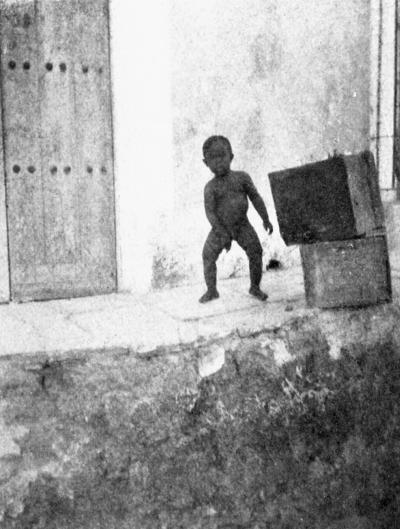
A GLIMPSE OF MATANZAS
We viewed the cathedral, a small square-towered edifice in ill repair, and then visited the elaborate and commodious building for the public school, now in vacation emptiness, and then we strolled to the market where fruits and fish were in especial abundance; and we noted everywhere the multitude of Cubans tan and black, for many negroes live in salubrious Matanzas.
Then we climbed the long hill, until, high behind the town, we came to a hedge of cactus, an open gate, an old and half-dismantled house. Voices of children rang out as we approached the wide piazza. A blue-eyed man with firm and kindly face, a little pinched and pale, but alight with high purpose, greeted us at the door. He had made here a home for motherless waifs, the riffraff and refuse of the reconcentrado camps, whom Spanish heartlessness and hunger had not utterly destroyed. The
man came from Illinois, and with his own small means had gathered these few score children, all little boys here, a separate home for the little girls yonder across the hill; had drawn to him a company of kindly Cubans, and here set up and now successfully maintains, asking no outside aid or alms, these homes and schools for the saving of the little bodies and their souls. The youngsters are the picture of good health. Their fare is the simplest; their instruction kindly, their play hours long. They grow and thrive, and some day will be men and women who will help Cuba’s destiny for weal and not for woe. I grouped the little lads together and took them with my kodak, and cherish the picture, in sad contrast with the party of little Mexican boys who left our ship at Progresso, all unconscious of the brutal slavery and death awaiting them.
We also visited the beautiful and simple shrine and chapel of Monserrat, erected by the descendants of those who came to Cuba from the Balearic Isles. This shrine crowns the summit of a hill overlooking the city. We here tarried long, viewing the wide reach of landscape stretching as far as the eye could see in undulating plains toward the south, with everywhere vistas of ripening cane, while northward wound the fertile valley of Ymurri toward the famous caves of Bellmar.
“Veni aci, Charley Blue-eyes,” they called after us as we passed along the narrow streets. Some of the voices possessed the cadent melody of the Spanish maiden, but we did not deign to turn, for who would be so bold as to call us “Charley Blue-eyes,” we should like to know! Many children were playing along the curb, and few of them wore even a coral band around the neck. Quite as God made them they were, their tan and swart skins, showing soft as satin under the influence of sunlight and fresh air. We were loath to bid adieu to the delightful city, and I shall never forget the charm of its picturesque location, the perfection of its smooth macadam streets, the cleanliness of its white and blue and yellow houses. Yellow was the hue most used and loved by the Spaniards, blue is the color for the patriotic Cuban. Since Spanish oppression has left the shores of Cuba, the towns and cities have been going through a steady metamorphosis from the yellow to the blue.
We lingered upon the fine iron bridge spanning the river San Juan, watching the abundant traffic of the waters beneath us, composed chiefly of fishing and fruit boats, although some were laden with more bulky commerce. At a little shop just across the bridge, we tarried to fill our pockets with delicious cigars, cheaper than even our stogies at home; and we let the boy behind the counter take up a huge cocoanut in its green husk and with his big knife hack it open and pour out the liquor within. “Milk,” they call it, but more like nectar it is, and he filled two deep glasses whose contents we quaffed with great content.
The stars were out when we returned to the city of Havana. The American squadron was ablaze with electric lights, and only the gloomy mast of the Maine, thrusting above the placid waters, hinted at the final provocation to war which so short a time ago brought to Cuba peace with liberty.
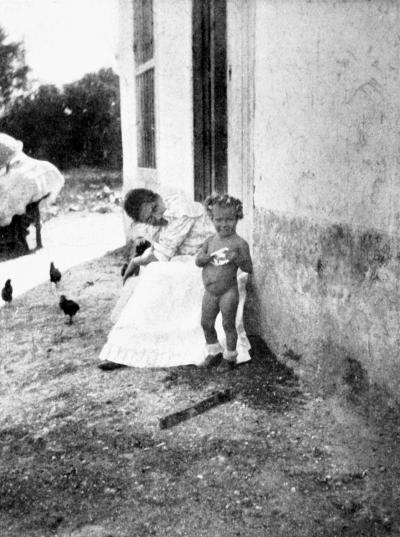
DRESSED FOR THE DAY
XXIII
Cuba—The Tobacco Lands of Guanajay—The Town and Bay of Mariel
Guanajay, Cuba,
December 28th.
It was dark. Through the wide-open window of my chamber crept the soft morning air of the tropics. Some one was shaking my door and crying, “Hay las seis, Hay las seis.” It was six o’clock. I was to leave on the seven o’clock train for Guanajay, and the fertile tobacco plantations of Pinar del Rio. In the spacious, airy dining room, I was the first guest at desayuno.
The railways of Cuba and the railway coaches are yet of the antiquated sort. Our car must have been made fifty years ago, with its small seats of hard plank and windows without glass. The clerk who sold tickets spoke no English. I just kept putting down Spanish dollars until he said “bastante” (enough). Later, I found that, presuming on my ignorance and the throng pushing behind me, he had gathered in two dollars too much, to his personal profit. The railway is owned by Englishmen, although run by Cubans. We rolled slowly out of the city toward the west. We looked upon high stone walls, now and then catching a glimpse of a garden through an open gateway, and then ran between perfectly tilled market gardens with rich black soil, many Chinamen working in them.
Beyond the gardens, we passed stately buildings and the beautiful park surrounding the Spanish Captain General’s summer palace, where are ponds and fountains, palms and blooming shrubs. All these are now owned by the Republic of Cuba, and are some day to be converted into a pleasure ground for the people, just as are in France the ancient royal palaces and gardens of Versailles and Fontainebleau. As our train rolled west, it gradually approached a range of hills, where are now many pineapple farms, yielding pineapples which put the tiny Florida plant to the blush—big, luscious and juicy. A young man from Boston sat next me. He was looking for pineapple land. He meant to quit the snow and ice of New England. He would buy a plantation and settle and live in Cuba, where, thank God, the ice blight never comes, where man has only to plant and nature abundantly does the rest. We passed many orange groves, and lemon and lime and mango trees which the Spaniards had failed to destroy. Their branches were heavy with yellow, golden, ripe fruit. Here, where is no terror of frosts, many a frozen-out Floridian is now arrived or is on the way. The orange of Cuba is sweet, juicy and luscious, and some day Americans will here raise them and sell them in New York, and in this way win back the money they have lost in Florida. As we passed along, we traversed many sugar plantations, once cultivated, now abandoned. The black and ruined chimneys and dilapidated walls of their factories were eloquent witness of devastation and war. But the smaller farmsteads looked prosperous. Beside each dwelling was usually a grove of plantains and bananas. The latter, commonly thin skinned and fragrant, are as small as two of your fingers and most delicious. A young couple plant a banana grove when they set up housekeeping, and thereafter have bananas at hand all their lives.
At many of the houses we saw the Cuban flag floating from the staff top. “Cuba Libre” is in the hearts of all these rural people. I told a Cuban fellow-passenger, that I, too, had raised that flag, the first to do so in my State, and he thereafter treated me like a brother. I had touched his heart. We passed a deep, wide stream, flowing with a clear full tide. It is the overflow from the wonderful spring which supplies to Havana its water. It bursts from the ground a full-grown river. Havana has dammed it, bridled it, and through huge pipes, carries its abundant and pellucid flood into her streets and houses, furnishing fresh, sweet, pure water for the multitude. A few miles further on, we saw another river plunge suddenly into the bowels of the earth. Full and brimming it flows along, and then all at once disappears forever into a mysterious hole. The Spaniards have here raised a chapel and set up a big cross, for must not this engulfing cavern be one of the gates to hell? And what more certain than a house of God to frighten off the devil!
We are now in the midst of some of the finest tobacco lands of the world. This part of Cuba is founded on a coral reef. The lime of the coral has here permeated the ground. Red and chocolate and brown-black, the soil contains just those chemical ingredients which tobacco needs. No other land has anywhere yet been found just like it, and no other tobacco grows with quite the same fragrant quality of leaf. All the world wants this Cuban tobacco. Therefrom the French government makes and sells cigars and cigarettes and reaps great revenues. The Germans also want the Cuban tobacco lands, and the enterprising American intends sooner or later to have his share of them. How would you feel, my smoking brother, to be able to enjoy a delicious Havana cigar, to roll it between your lips and inhale the perfume of its smoke, all for the price of three cents or perhaps a nickel? The Americans are quietly acquiring as great an acreage as possible of the tobacco lands of Cuba. These lands are mainly held in small farms of four and five acres, each worked by a single family, who devote all their attention to the planting of the seed, the raising of the crop, the drying of the leaf, and even the final making of the finished cigar. They sell the cigars at their door, or take them to the town and sell them to the dealers, who buy and then put on their own labels and place them in the market. Nowhere in the United States will nature permit a tobacco leaf to stay on the plant until it is fully ripe; there is too much fear of frost. But in Cuba the leaf hangs to the stalk in the sunshine until it has reached that degree of ripeness which insures the most perfect tone and flavor. Thus it is, there can be no other tobacco just like Cuba’s, for nowhere on earth ’t is said, do soil and climate and human skill so aptly and completely combine to make the product perfect. There are three islands of the sea where the soil is rich and fertile beyond all other lands; the island of Java, owned by the Dutch; the island of Luzon, chief of the Philippines, and the island of Cuba. And in this one product, it is claimed that Cuba surpasses them all.
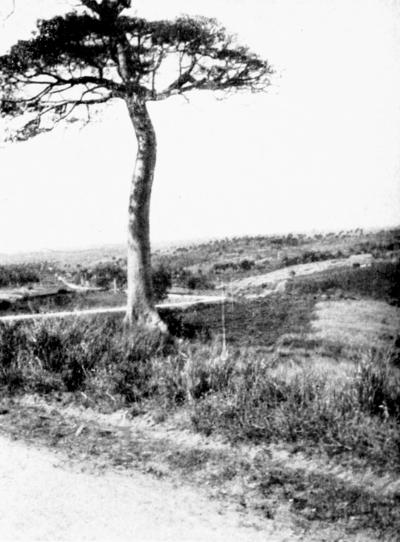
ALONG THE MILITARY ROAD, A CEIBA TREE
We left the train at Guanajay—once a tobacco town of importance, then blasted and wasted by war, burned and ravaged, and now regaining its life and vigor. Here we took an open carriage and drove toward Mariel, upon a noble highway quite sixty feet wide, and all macadamized and ditched—a Spanish military road, once lined and shaded with gigantic and umbrageous trees; now bare of this magnificent bordery by reason of the war. The Spanish soldiery cut them down, lest here and there an insurgent might lie concealed. The road wound over a line of low hills, and then descended to the sea. Along the ridge, at intervals, were yet to be seen the “blockhouses” of the western Spanish Trocha. My friend, Captain Reno, beside me, had been an officer of the insurgent army. An American volunteer, with blood full of red corpuscles, he served all through the revolutionary struggle, fighting the Spaniards just for the joy of war. He crossed this Trocha with Gomez in his famous raid. The Spanish soldiers hid within their houses and shot from their loopholes. But Gomez and Reno cut down the wire barriers, rode through and dared to enter the suburbs of Havana. The superb road gradually winds toward the bay of Mariel. On our way, we passed a new railroad being built by Americans, back to an asphalt lake; Mariel will be their port, the bay their harbor.
Near to us on the left lay another American colony,—a group of Western folk who have come to Cuba to stay. The bay of Mariel, next to that of Havana, is the finest harbor on the western coast. At its entrance, high on a reef, lies the Spanish warship, Alfonso XII, driven on the rocks by American naval guns. Along the shores of this beautiful bay, it is said, will grow up the Newport of Cuba. Nowhere are there so well protected waters, nowhere is there so picturesque a panorama. Here you see palms, royal, cocoanut, and date, and fields of sugar cane and groves of bananas, oranges and pomegranates, and then the foaming, restless sea far out beyond. On the corner of a shaded street, close by the blue waters of the bay, we stopped at a modest, unpainted house. Within it we met a clear-eyed, sweet-faced woman—a lady from North Carolina, a Miss Edwards, who came to Cuba, after the devilments of Weyler had wrought their sad havoc, and gathered up a little company of starving girls, and here has given them a home—forty or more of them. She asks no outside aid. She is spending her own small means. The people of the town, with their Spanish pitilessness of heart, do not understand why she should be doing so strange a thing as to pick up and care for the dirty progeny of dying and dead vagabonds. Better let such a litter die, they say. She told us that she was much alone, that even yet the good people of Mariel treated her with suspicion. If she were a government official, they could comprehend, but they cannot understand how or why anybody should take so great a care of waifs and strays, all for the sake of the humanity of our Lord.
We spent the night at Guanajay in an old Spanish inn, very tumbled down, partly as the result of time, largely as the result of war. We ate our evening meal in a spacious, lofty chamber, sitting at a long table. The company was chiefly made up of tobacco planters, and one or two Cuban drummers, while right in front of us sat a Spanish marquis and his wife with their English governess for the children. They were visiting Cuba to inspect the ancestral sugar estates, and arrived only the week previous from Spain. They treated the company with haughty indifference, and ignored the poor English girl as though she were socially altogether out of their sphere. They helped themselves and talked to the children, while the governess foraged for herself or went without. It reminded me of those mediæval times one reads about, when the clergyman resident in the castle of the lord sat at a table in the servant’s hall. We took pains to see that the English girl received every attention, the Marquis glowering savagely upon us when we passed a dish to the governess rather than to his wife. When the meal was over the pair stalked loftily from the dining hall, leaving the governess to smile upon us in return for our pronounced civilities, momentarily made happy, for the first time perhaps in many months.
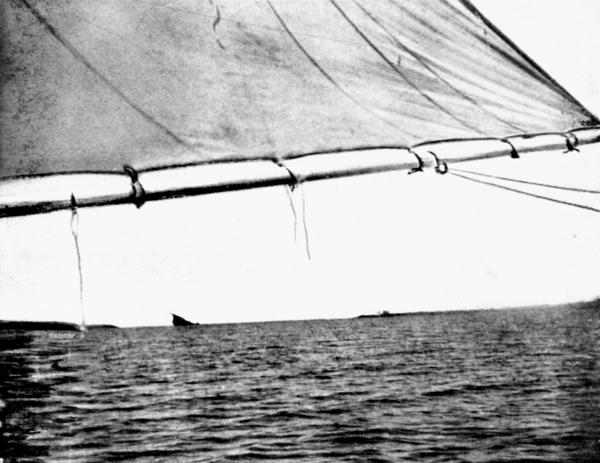
THE BAY OF MARIEL
In the evening we visited the large Reform School for boys, which has been established by the military authorities of our government for the care of waifs whom the cruel reconcentrado policy of Weyler deprived of kith and kin. The children looked well-fed and content, and the courteous Governor, a major in the army, assured us that they throve and learned, gave little trouble, and bade fair to become good men and citizens. It is in this sort of thing, the Home for the little boys near Matanzas, the charity of Miss Edwards at Mariel in caring for the motherless little girls, the charity of our government in providing so generously for these boys, that is seen the difference in spirit of American civilization from the hard and callous pitilessness of Spain. The Spaniard and the Cuban care for their own with tenderness, but they look with indifference upon the suffering of others, nor do they comprehend why they should lift a finger to help anyone beyond the narrow circle of their own family or social set.
We have also called upon a big, gaunt, sunnyfaced man who is devoting his life to these people as a missionary of the Congregational Church. He is from Massachusetts, a man of education who preaches fluently in Spanish, and whose labors have met extraordinary success among the Cuban population of Key West. He has now been transferred to Guanajay, and already is creating a profound impression in a community which has never before known aught but an indifferent Roman priest.
The religious conditions of Cuba are peculiar, I am told. The Bishops and Priesthood of the Roman Church have been supplied by old Spain from time immemorial. The black sheep of the Church have found asylum here. Drawing their salaries, fretting in exile, these ne’er-do-wells of the motherland have cared little, and done less, for the spiritual welfare of their flocks. Guanajay is reputed to be a community among the most spiritually darkened of all Cuba. Hence, it is with no little wonderment that the active, enlightening methods of Mr. Frazier are viewed by those among whom he now ministers. The women come to him for solace and advice, the children flock to his singing school, and the Sunday-school in the afternoon is filled with old folks and young, who come to him after the hours of Mass. Even the local padre himself finds this strange heretic so pleasant a companion that he frequently drops in to share a cigar and gossip of the times. If Americans are to make impression spiritually upon this Latin-Catholic population of Cuba, they will do it only through such intelligent personal and sympathetic methods as are here employed. Mere perfunctory Protestant ecclesiasticism makes no impression upon these Latin-Catholic peoples.
Sunday morning we arose while the stars yet blazed, found a cup of coffee for our desayuno at a little restaurant across the street, and at five o’clock were in the cars again traveling toward Havana.
The country we have been looking on is quite as beautiful as the more flat-lying, but not more fertile region about Matanzas, and I have felt that the many Americans we have met everywhere, all looking for land to buy and to abide upon, are in happy quest. They are entering into one of the veritable garden places of the earth and many more of my fellow-countrymen will surely follow them.
XXIV
Steamer Mascot
Steamer Olivette, between Havana and Key West,
December 31st.
One learns to rise early in these tropical lands. The midday siesta here affords the rest which we are wont to claim for the early morning hours. I have readily acquired the habit. To lie abed is become a burden. I stir abroad betimes as do all others. And I am sleepy also toward midday, and quite inclined to take a nap when the heat is most intense. I recall that two years ago when coming home from France, the only stateroom I could obtain upon the Wilhelm der Grosse, was already partly taken by a gentleman from Mexico. I doubted whether it would be pleasant to chum with a stranger, but I had no choice, so made the best of it. He had the upper berth, I slept below. But although we were a week upon the sea, I never saw him, and I do not to-day know who he was. I was asleep before he turned in. I was still asleep when, at break of dawn, he passed out to pace the decks. He took his midday siesta when I was enjoying the midday sun, or resting upon my sea-chair. I then wondered at the persistent habit which drove him from a comfortable bed almost before the night was spent. Now I comprehend his ways, and if I were to voyage seaward to-morrow, I should be rising with the dawn. Yesterday morning I had risen at four o’clock, and had taken my desayuno at an hour when those at home are sunk in sleep.
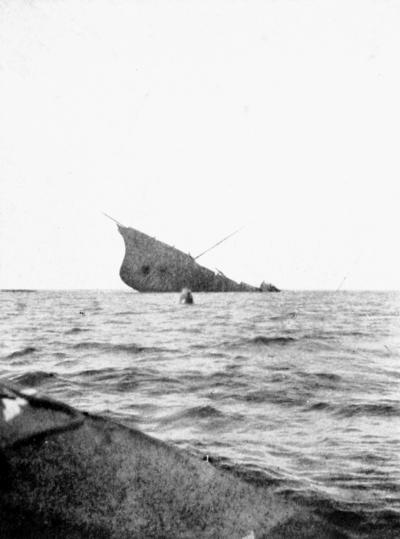
THE WRECK OF THE ALFONSO XII
Overnight a great storm has arisen. I tried to find out at the hotel about the weather, but in Havana weather reports are unknown. The Spanish clerk at the hotel smiled at me most condescendingly for asking so silly a question as, “Is a storm likely to be coming from the North or the South, or anywhere; and what sort of a day are we likely to have to-morrow?” Bowing politely, he spoke in sneering undertone to his Spanish companion, and then in broken English said to me, “I never hear even an American ask a question like that, Señor. How we know what the weather is to be? God makes the weather Señor, not you or I.” And they both smiled upon me with supercilious contempt. They took me for a fool. Only a fool would pretend to ask what Providence might have in store. So much for the Weather Bureau and the yet mediæval Spaniard!
When we left the harbor a few hours later, a great sea was tossing gigantic breakers above the ramparts of El Moro. We plunged into the fury of a Norther, which turned out to be one of the wildest gales of the midwinter. I might have put off departure a day or two if I had known of it, but Spanish ignorance sent me out in a small and laboring boat to make the dangerous ninety miles across the straits in the face of such a storm.
After my breakfast, a Spanish hall-boy of the hotel had struggled down the successive stairways with my valise. Ordinarily, we would have taken the new electric elevator, but the American company which recently installed it had recalled their experts, and the Spaniard supposed to run it in their place had promptly put the machine out of order. The cage now hung fast about half-way up the shaft awaiting American skill to set it moving.
One of the many cochas drawn up before the loggia of the hotel was soon carrying me to the Caballerio Pier, there to have my trunks and bags stamped with the certificates of the health officers of the port, and checked through for the journey to Tampa. And then I went up to a little bird shop on Calle Obispo, and took charge of a clever parrot, for which I had arranged the day previous,—a bird brought from the Isle of Pines, with green body, white head, pink throat. She is named Marie, and yesterday she talked to me long and loud in Spanish. Along with her I purchased also a pair of pretty love birds. Perhaps I may tell you that the Marie with which we reached Florida could talk no Spanish, and the pair of pretty parakeets, instead of being loving mates, turned out to be two fighting males. But all of this I only learned when many leagues distant from the soft-eyed señora who sold them to me in the little shop on the Calle Obispo.
Our boat was named the Mascot, and well was it so christened, for the fierce billows tried her seaworthiness to the limit. The Norther which broke its fury upon the coasts of Yucatan did not arouse so angry a sea as that which fought the currents of the Florida Strait.
The greater number of our passengers were Cubans going across to work in the tobacco factories at Key West. It was apparently their first experience of the sea. They filled the forward decks, and gay and lively was their company as they waved their adios to their shouting friends ashore. The tempestuous waters caught us before we even left the bay. We were steaming out dead in the teeth of the gale, and the little boat pitched until she almost stood on end, and rolled as though her gunwales would be every time awash. Our Cubans soon lost their speech and then their breakfasts, and were at last filled with fear alone. They were scarcely recovered when we made fast to the long pier at Key West, and did not regain their cheerfulness until their legs were firmly set upon the land.
Key West boasts a larger Cuban-Latin population than native American, and sonorous Spanish speech falls more frequently upon my ear than th-i-th-ing- s-i-s-sing- English; yet I behold the Stars and Stripes floating above me and know myself at home.
My journey through Mexico and Cuba is at an end, and I am returned to the United States. I now experience again the same shock of transition which so moved me when a few weeks ago I crossed the Rio Grande and entered Mexico. For many days have I beheld and felt the puissant tenacity of a civilization older than my own; a civilization once world-dominant and still haughty and assertive, which begat arrogant war-lord and subservient slave, which exalted the few and crushed the many, and which to-day while it applauds and assumes the outward habiliments of democracy, yet underneath retains the flesh and blood of despotic individualism; a civilization, nevertheless, marked by the highest appreciation of all that appeals to the finer senses in splendor of religious ritual, in sensuousness in art, and in the graceful and the ornate in architecture; in music and in belles-lettres.
For the masterful rule of Diaz I had come prepared, but of the numerous well-ordered and well-built Mexican cities I had no thought. The discovery that here had been successfully applied the principles of municipal ownership of public utilities centuries before Chicago, San Francisco, and New York had debated their problems, came to me as a revelation, and when I beheld the noble cities of Mexico, of Toluca, of Morelia, of San Louis Potosí, of Monterey, and many others, giving for three hundred years free water and free illumination to their people, and throughout these centuries adorned with well-kept parks where flowers bloomed, artistic fountains flowed, and music played, for the free enjoyment of the poorest peon as well as the millionaire grandee, I was fain to bethink me whether the practical, money-getting American might not after all take lessons from his Latin brother of the South.
The romance of Mexico’s early history, the travail and triumph of Montezuma and Malinche, of Pagan teocali and Christian cross, stirred my imagination and aroused my interest to highest pitch, while the present progressiveness of Mexico’s people, the enlightenment of her leaders, the noble efforts she has made, and is now making to keep step with the procession of human progress, excited my sympathy.
Nor have I ceased to marvel at the extraordinary geographic and climatic gifts which nature has so lavishly bestowed upon this favored land; a country where every climate from the heats of Yucatan to the cool airs of Quebec are brought together within the compass of a journey of a single day; where teeming tropics and fertile highlands alike pour out their fruitfulness for the use of man; where alone upon the North American Continent has beneficent nature presented conditions which made it possible for mankind to develop an indigenous civilization of advancing type;—upon these plateaus existed well-built stone-and-mortar cities centuries before Cortez and the Spaniard set foot upon her shores; here successful agriculture has prevailed in uninterrupted continuity for a thousand years; here precious metals have been dug and worked by man for unnumbered centuries; and upon these salubrious highlands more than a mile above the sea, beneath the shadows of her snow-capped Sierras, man has developed, and may yet develop, the highest energy of the temperate zones.
I confess that despite a general knowledge, I yet entered Mexico ignorant, sadly ignorant, of one of the most splendid portions of the earth’s domain, and while my glimpses of this great country have necessarily been limited and partial, yet I have seen enough of her mineral and agricultural wealth, the solidity and comfort of her cities, the vigor and intelligence of her people, to assure me that the Republic of Mexico is destined to be no puny factor in promoting the advancement of the world, as well as the further increase in riches and power of the sister Republic wherein I dwell.
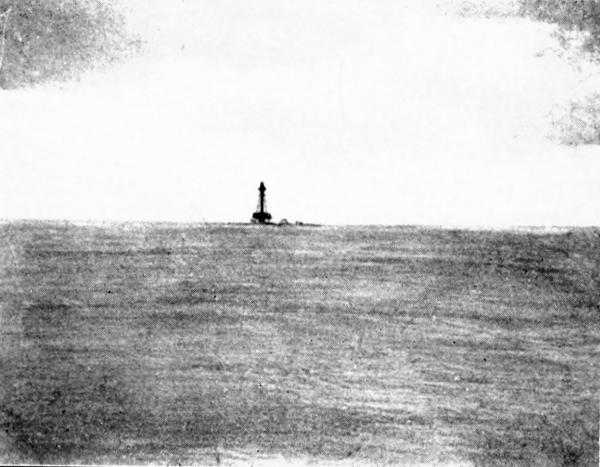
KEY WEST LIGHT, THE SOUTHERN EXTREMITY OF THE UNITED STATES
Nor has my transitory glimpse of Cuba, “Pearl of the Antilles,” as she is, caused me the less to marvel at the abounding fertility which constitutes her a veritable garden, and the charm of her climate, free of all frosts, yet temperate enough, amidst the cooling breezes of the all-surrounding seas, to make her the home of white races which hold fast to their primitive energies although within the tropics. While in imagination I behold her, at no distant date, taking her proud place among the galaxy of States of the great Republic of the North and vying with the most splendid of them in opulence and power.
INDEX
- Acambaro, 46-87
- Acapulco, Highway to, 99
- Alamo, The, 41
- Anahuac, Valley of, 52
- Ario, 107
- Arrive at City of Mexico, 54
- Azteca Mines, 135
- Balsas, The Rio, 152
- Boys, The Little Stolen, Etc., 214
- Buena Vista, Battlefield of, 46
- Bull Fight, A, 75
- Cabaña La, The Fortress, 236
- Cathedral, City of Mexico, 61
- Charleston-Kanawha, Leaving, 15
- Chocolate, A Cup of, 159
- Church, Roman, 61-63-178
- Churumuco, 155
- Cima, La, 52
- Comments on Municipal Methods, 172
- Copper Industry and Utensils, 102
- Cotton Lands of Mississippi, Louisiana, Texas, 21-40-43
- Crossing Florida Strait, 273
- Cruelty of the Spanish Blood, 118
- Cruelty, Spanish, Burying alive, 237
- Cuban, A Mansion, 232
- Cuernavaca, 188
- Cuyaco, The Hacienda La, 123
- Cuyaco, The Rancho, 159
- Descending La China Mine, 137
- El Padre, 95-187
- English, Spread of the Language in Mexico, 174
- Fiesta of Our Lady of Guadaloupe, 165-185
- Fonda Diligencia, 97
- French Market, New Orleans, 31
- French Quarter, The Vieux Carré, 30
- Garcia, Señor Don Licénciado Vicente Garcia, 170
- Guadaloupe, Fiesta of Our Lady of Guadaloupe, 165
- A Guest of “Señora General” Wood, 228
- Gulf of Mexico, Crossing the, 212
- Habana, 220
- Havana, A Private House in, 231
- Havana, Markets of, 225
- Havana, The Opera House, 228
- Hotel Concordia, 93
- Hotel Iturbide, 55
- Hotel Jardin, Mexico City, 264
- Hotel Jardin, Morelia, 181
- Hotel Metropolitán, 204
- Hotel Morellos, 114
- Hotel Pasaje, 221
- Hotel St. Charles, 25
- Incidents in Land of Heat, 161
- Inguran Mines, 117
- Italians in Mississippi, Etc., 22
- Iztaccihuatl, volcano of, 53
- Izus Hernandes, Our Mozo, 95
- Jackson Square, Reflections on History of, 29
- Jefe Politico, A, 109
- Jesuits in Morelia, 180
- Jorullo, Volcano of, 122
- Kentucky, Passing through, 17
- Lakes—
- Chalco, 53-69
- Cuitzeo, 88
- Patzcuaro, 88-99
- Tezcoco, 53-69
- Xochimilco, 53-69
- Llaños, Crossing the, 143
- Laredo, 43
- Lawyer, A Lawyer of Ario, 115
- Military Macaws, 131
- Mantillas, Buying, 202
- Mariel, 264
- Masonic Bond, Strength of in Mexico, 50
- Masso, General, and the Revolution, 249
- Matanzas, 254
- Memphis, 21
- Mexico City, First Impression of, 56
- Mexico City, Characteristics of, 65
- Mexican Travelers, 160
- Michoacan, The Congress of the State of, 168
- Mining, Antique Methods of, 129
- Mina La China, The China Mines, 136
- Mina La China, Descending the, 137
- Mina El Puerto, 145
- Mines, The Inguran, 117
- Mississippi, Traversing State of, 23
- Monterey, 45
- Monterey, Passing through, 45
- Moonlight, Brilliancy of, 100
- Morelia, 89
- Morelia, Description of, 172
- Morelia, Life in, 176
- New Orleans, Life and Color of, 25
- New Orleans, Water Traffic, 37
- Noria Mines, 134-150
- Nuevo Laredo, 44
- Orizaba, Volcano of, 203
- Orphans from the Reconcentrado Camps, 255
- Oropeo, Hacienda de, 132
- Patzcuaro, Lake, 88
- Patzcuaro, Town, 91
- Pompano, Eating a, 27
- Popocatepetl, Volcano of, First Sight of, 53
- Prado, The, Havana, 222
- Progresso, Yucatan, 212
- Provincial Despot, A, and His Residence, 107
- Pulque, 70
- Pulque, Origin of Legend, 73
- Rancho Nuevo, 120
- Ravens, 103
- Ready for Revolution, 250
- Restaurants in Mexico City, Remarks on, 57
- Revolution, Ready for in Cuba, 250
- Saltillo, Passing Near, 46
- Sam, “Mr. Sam,” of Vera Cruz, 205
- Saving the Children, Matanzas, 255
- Saving the Children, Mariel, 265
- Santa Clara, 106
- Saving the Children, Guanajay, 267
- San Nicholas, College of, 180
- San Luis Potosi, 48
- San Pedro, Rancho, 126
- Scorpions, 154
- Southern Pacific Railway, 39
- San Antonio, 41
- Sugar Cane, Louisiana, 23-39
- Sugar Cane, Cuba, 252
- Tame Vultures of Vera Cruz, 206
- Taylor, Incident Regarding Governor, 20
- Tenochtitlan, 53
- Theaters, Mexico, 199
- Tio, 93
- Titian, A Picture by, Legend of, 91
- Tobacco Lands of Guanajay, Cuba, 262
- Toluca, 181
- Toluca, Life in, 183
- Tortillas, Making, 132
- Vendettas of Kentucky, 17
- Vera Cruz to Cuba, 210
- Vieux Carré, New Orleans, 26
- Yucatan, 216
- Yucatan, Strait of, 217
- Yucataka, Senator, 208
- Walled up Alive, 241
- Water-fowl on Lakes, 88
- Water to Cities and Towns, 108
- Map, 284
